Text
INTRO TO COSTA RICA + TRAVEL WARNINGS!
Note: To skip my intro and travel warnings, jump to my next post for a full recap of my trip to Costa Rica.
Pura Vida! Life has been so good to me this past year. Despite our current [horrifying] political climate in the U.S. and a few unexpected learning experiences, I have to say that I feel very lucky to close 2017 with good health, a loving family, beautiful friends (old and new), and the most amazing & supportive boyfriend by my side through it all. As some of you may have already known, I had been thinking about pursuing my dreams to teach English and create my art while traveling full-time for years, and last year at the end of 2016, I finally made the first step by leaving my job as a Production Coordinator, Office Manager, and Illustrator at Malka Media. It was a bittersweet goodbye, and it took me months to muster up the courage to start that conversation with my bosses, colleagues, and friends, but I look back now (more than a year later!) and feel nothing but grateful for everything I was given the opportunity to experience, including traveling to Mexico (see my post on that here)!

(my Malka Media family that I bid farewell to pursue my dreams)

(my “office” in Mexico)
By January of 2017, with the guidance of my awesome life-coach and brother Nathan, I had outlined a year-long plan for myself to budget and save in order to fund my tuition and living costs of moving abroad, and scheduled new milestones I needed to reach in order to set my plan into action. I had many goals in mind, but after taking time to reflect, I realized that I had only one real mission: to make this world a better place in my own unique way. It sounds cliché, but I had been living my life more passively than I had thought, struggling through challenge after challenge and feeling more empty as the years zipped by.
Teaching has always been a passion of mine - from my roots of holding weekly drawing lessons with my classmates in elementary school (I’m looking at you, X and B.Telf!), to my freshman year of college when I set off to pursue teaching as a major. Somewhere along the way, between teaching preschool art classes and substituting at the Zimmerli Art Museum for Al’s drawing classes, I lost my focus on teaching and redirected my energy towards painting and making art. Some of that can be blamed on Rutgers University’s policy at the time, which restricted Mason Gross students majoring in a visual art concentration from also partaking in the 5-year education programs offered to every other major. I weighed my options, and I chose painting, my first true love. I don’t regret making that decision, because in doing so, I was able to explore my reasons for making art in ways I had never thought of before, and because I majored in painting, I was able to conduct my research for my thesis project in Cuba (see my post on Cuba here). That first trip abroad is what sparked my passion for traveling, and put into perspective just how lucky I was to be born in a country of freedom, to parents who had paved a road of opportunities for me since before I was even born.
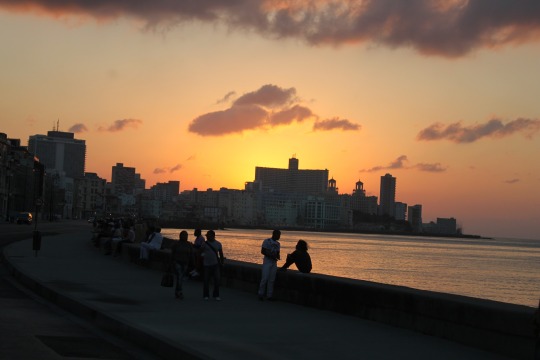
(my first trip abroad to Cuba - the spark that started the fire)
It was that spring of 2013 when a seed had been planted in my soul - to travel, to continue creating art, and to share the wealth of knowledge and opportunities that had been given to me by sheer luck of existing in the time and place that fate had decided. But, as all plants do, I needed to grow more before I could bloom. Fast-forward through my time living in the Philippines (posts on that here, here, here, and here), then returning home and freelancing as a painter, to working at a publishing company in NYC and then on to Malka, and there I was - 25 and feeling lost again.

(my first experience living in another country - on one of the 7,107 islands of the Philippines)
When I first left Malka last winter, I felt an immense sense of fear for the future, but with that fear came excitement and determination. I had already begun taking an online course to learn more about my options for earning my certification to teach English as a second language, and needed a way to save money and still have the flexibility to travel and plan more for the year ahead. I was lucky to find a temp position at Cozzoli, working as their Marketing Manager and Events Coordinator in the months between traveling back to Ecuador throughout the year. By the fall of this year, I had finally completed my application and interviews for the CELTA course, and was accepted to the program in Montañita just days before taking off to return to Ecuador again.
In the midst of all this, I have been supported by the most incredible friends and family. Some of you may remember my friend Claudia, who I met in Ecuador during my first visit to the Galápagos (read that post here). Claudia was living in Cuenca at the time, but had moved to Costa Rica after our trip. Then in March of this year, she reached out to connect me to her friend Kriss, who would be traveling to the U.S. alone and visiting New York City for the first time. At the time, I was still renting my apartment Café Bustelo in Jersey City, but had begun working at Cozzoli in Somerset, so was only living there on the weekends. Since my room was fully furnished but vacant on weekdays, I offered Kriss a place to stay during her visit. My amazing roommates Julia and Ethan graciously welcomed her when she arrived, and I was able to spend two weekends getting to know her. Our connection was instant, much like the spark I shared with many of my dear friends around the world. So by the summer, it was only right that I made a trip to visit Kriss in her hometown, and Claudia at her new home in Costa Rica.

(international friendship - Irina from Siberia, Kriss from Costa Rica, and me!)
Although my trip to Costa Rica was short, it was undoubtedly sweet in so many ways. Some of you may know that I typically plan my trips a year in advance, researching as much as possible to create an itinerary that covers a diversity of attractions, natural landscapes, and - of course - the opportunity to see animals in their wild habitats. This time, however, my planning window was short, given my many return trips to Ecuador and balancing my full-time temp job, painting commissions, and application for school. Luckily, Kriss and Claudia were there waiting for me, with plenty of advice and answers to my many questions. I had planned to fly directly from Ecuador to Costa Rica, after spending a week visiting the Galápagos for the fourth time, and a month on the mainland meeting Raúl’s family. I was expecting to spend a full two weeks in Costa Rica, landing in San José and embarking on an adventure towards Volcan Arenal, then off to exploring the Pacific and Caribbean coasts.
In case you didn’t know by now, with my luck, I pretty much live by Murphy’s Law. My initial departure date for June 18th was pushed to a week later when I arrived to the airport in Guayaquil and was denied boarding by Avianca. Unbeknownst to me, since I had been in Ecuador for a stay of longer than 6 days, it was mandatory to show proof of yellow fever immunization before traveling to Costa Rica. So, after our five-hour bus ride from Santo Domingo to Guayaquil, I changed my flight at the Avianca counter for the following Sunday morning, and we boarded the bus for another five-hour ride back to Santo Domingo. Along the way, I delivered the bad news to Kriss, Claudia, Will and X, who I planned to meet with upon landing in San José. Will had needed to change his flight too, so would be arriving just a few days before me. X, on the other hand, was already en route from New York, and read the news once he landed. Rather than follow my itinerary to travel to the Pacific Coast alone, he opted to stay in San José with Kriss and Claudia until Will arrived.
Once we were back in Santo Domingo, I needed to visit the health clinic right away. I wasn’t sure whether I had already received the immunization before, and since the clinic I had visited in New Jersey could not release my records to anyone except for me (in person), we resorted to asking the nurses at the clinic to help me write the immunization card without administering the shot. After explaining the situation and being denied, we felt defeated and began to walk away, when suddenly one of the student nurses snuck out to follow us, and offered to help if we could return during lunch hours. When we returned, she had a card already prepared and only needed my name to write in. We felt so grateful for her help, and thanked her before heading home. Once home, I realized the card needed to be dated 10 days before my departure, and my departure was in less than a week. Thankfully since it was the 20th, I was able to “edit” the hand-written card to read the 10th and hope for the best.
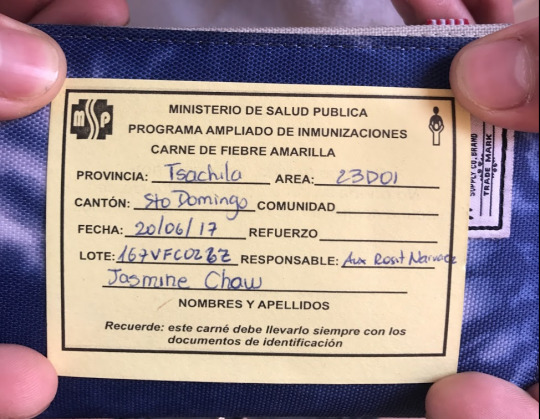
(the immunization card issued by the clinic in Santo Domingo)
Then the 25th rolled around, and we headed back to Guayaquil. At the airport, I was turned away from Avianca yet again. Apparently, the immunization card I received from the clinic was for domestic use only, and I needed to visit the Ministerio in Guayaquil to exchange this for an international document. Unfortunately, since it was Saturday night/Sunday morning, we needed to find a place to stay overnight and head to the Ministerio on Monday morning. At the time of my check-in, the Avianca ticketing counter was still closed, and would remain closed until 6AM, after my flight would have already departed. Because of this, I feared that the remainder of my itinerary (including my return flight home) would be cancelled as well, due to missing this leg of the flight without making a change before its departure. Concerned, I consulted the Avianca check-in counter, who had just denied me entry. They reassured me they would mark me as a cancellation, and not a no-show, which would keep the rest of my itinerary in place.
By now, it was 4AM, and both Raúl and I were exhausted and frustrated. We waited until 6AM for the Avianca counter to open, but by 6:30AM when no one showed, we decided we needed to get some rest and headed to Home Suite Hotel, where I had stayed before my first return to the Galápagos. The hosts, Ronny and Marcos, kindly awoke in the early hours to confirm a room for us, then offered us their couch to rest on while they prepped our room. The next morning, they even patiently listened to our story of how we ended up there in the first place, and offered to accompany us to the airport to try to straighten things out. Apparently, other guests had experienced similar problems, and Marcos himself had his passport taken by an Avianca agent during one of his trips. Ronny and Marcos should definitely win the award for hosts of the year, after everything they did for us.

(our suite at Home Suite Hotel in Guayaquil)
Our first order of business was to return to Avianca to change my flight. It was then that I was asked whether I planned to book a new return flight home from Costa Rica, since my entire itinerary had been cancelled. This was my exact fear the previous night, which I had explicitly asked about and had been reassured by Avianca agents would not happen. When I explained this to the agent, David, he kindly offered to help me find a new option, but unfortunately could not reverse what had already been done. By this point, I had already paid $200 to change my flight the first time, and was shelling out more of my savings to stay in Guayaquil to sort everything out, not to mention the numerous taxi and bus rides, so when David’s search only yielded options exceeding $1,000, I panicked. He calmly reassured me that if I returned tomorrow morning, the options may be cheaper, so I obliged and thanked him for his help. During all of these encounters with Avianca, David had been the only agent to offer genuine help and concern. I’m glad I met him, and in my next post, you’ll see how he was able to finally change my streak of bad luck. In addition to meeting David, the other silver lining in this unfortunate series of events was that our friend Jen happened to be in Guayaquil at the same time of this mishap, and we were able to enjoy dinner with her that evening.
The next day, we visited the Ministerio to have my immunization card exchanged for an international document, and headed back to the airport to change my flight for the following morning. However, this time David wasn’t there, and the new agent was not aware of the situation that had unfolded. After changing my flight to Costa Rica for the following morning, she insisted on charging me a $300 change fee to rebook my return flight to New York as well, since that had been removed from my itinerary due to a mistake made on behalf of the airline agents the night before. Out of options, I paid the amount and headed back to the hostel with Raúl to get some rest before returning to the airport again that night for my check-in.
When we returned back to the hostel, Ronny and Marcos asked us how things turned out. Once we told them about the amount of fees I had incurred from all of this, they immediately offered to join us to the airport to help us try to get a refund for the change fee. By then, I had lost count of how many visits we made to the airport in the past two weeks, or the amount we had paid in taxi fares, but I was grateful for their help. When we arrived, we went straight to the airport’s customer service office for an objective perspective, since Avianca had been of no help to this point. The agent there was not very pleased with Marcos’ tone, who introduced the situation, and insisted that he and Ronny leave the airport before leading Raúl and I to the back offices to speak in private with Avianca. By the end of the visit, I was only refunded $150, and was offered an apology on behalf of the airport. At this point, I just wanted to spend my remaining hours relaxing with my ever-patient and supportive boyfriend, so we headed back to the hostel to enjoy some take-out and Netflix before returning back to the Guayaquil airport (for the final time) that evening.
tl;dr :
Make sure you read all of the regulations for traveling between countries, including necessary immunizations and documents for boarding. This was my first time traveling from one foreign country to another after a stay longer than a layover, so I learned my lesson the hard/expensive way. When I returned home, I did some research and realized I was not alone - this exact situation has happened to many people. Most insurance policies will not cover fees incurred due to your own oversights, and as of recent years, the International Air Transport Association has ruled airlines not responsible for informing passengers of documents needed for travel. You have been warned - I hope you learn from my mistakes and not your own! Safe travels!
0 notes
Text
ECUADOR + GALÁPAGOS
¡Bienvenidos! Once again, I’m late to post - it’s been almost a year since our first trip to Ecuador, but to be fair, I did actually start writing during the trip this time. Since then, I’ve returned to the Galápagos twice (and will be heading there again in two days!). By the end of the year, I plan to earn my certification in teaching English as a second language and move to Isla Santa Cruz to teach.
Update 12/2017: I have now been to Ecuador 5 times (4 of those times in Galápagos), and will be returning in two weeks to study in Montañita with the CELTA program at International House Montañita. New post on the other locations I’ve visited in Ecuador coming soon, right after my delayed post on Costa Rica!
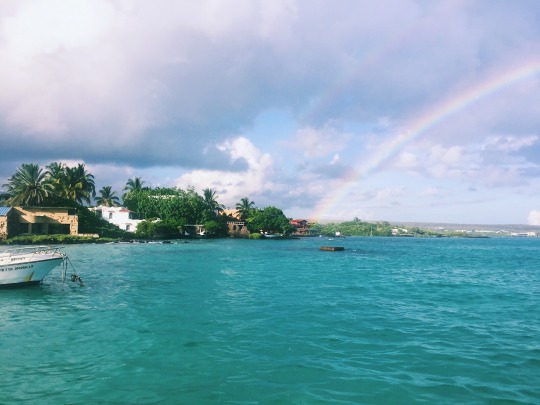
7/22, Friday: DAY 1: QUITO
I have to admit, before we left for our trip to Ecuador, I was nervous. I had done most of the planning for us with looking into hostels, places to visit, and the time and cost of bus transportation between cities for months in advance, but I still felt unprepared the week before my departure. My Spanish was limited at best (4% fluent according to DuoLingo), and I had been reading way too much into safety precautions for traveling on public transportation and exploring the cities after dark. Add to the list that I somehow saved getting my vaccinations and securing my bank account arrangements to just the weekend before my departure, the realization that I would never catch up on PokémonGo upon my return, and suddenly I was freaking out.
Now that I’m beginning to write this during our last weekend in Ecuador, I realize how absurd I was being, but I’m grateful for some of the tips I learned (and for the most part, ignored) during that panic. One of the most important to remember is that while traveling in Ecuador, although US currency is standard (since 2008), big bills are not common and rarely accepted at vendors or casual restaurants. You can most likely exchange 20s or higher at banks, bigger supermarkets (SuperMaxi), or break for change at fancier restaurants, but you’re better off carrying 1s, 5s, and 10s. Single dollars will usually be given back to you in coin form, and there are also 50 cent coins in addition to the mix of US and Ecuadorian 25, 10, and 5 cent coins. I also learned that Banco de Pacifico charges the least for ATM fees ($1.58) as opposed to our unfortunate first choice of Bank Pichincha - which charged an unbelievable 20% of the withdrawal amount. Can you blame me for choosing the bank with a black/yellow logo and name like Pikachu?
Update 12/2017: After multiple visits to Ecuador, I now realize that Banco Pichincha does not charge any ATM fees at all. I’m not sure whether this was also true when I originally wrote this post, or if I made a mistake and misread my ATM receipt! Either way - Banco Pichincha is the way to go! (I use a bank-issued Visa debit card from Investors Savings, which allows me 4 free foreign ATM transactions per billing cycle).
The other precaution I read was to only take taxis with orange license plates, and to ask the driver for the fare price or to start the meter before the ride. I honestly didn’t follow the latter at all, because even in instances when we were likely charged “more than average,” the fare never exceeded $10 (except for long drives to/from the airport in Quito) and I always tipped an extra dollar or two anyway, which isn’t standard either but everyone is so damn nice I wanted to tip them all. More on the former rule later, when we maybe almost get kidnapped because I trust people too easily (sorry mom!).
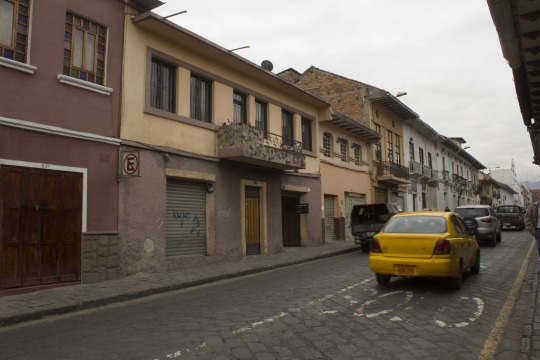
The fact is, I’ll talk to anyone. Most people will tell me that I’m not careful enough, but you won’t believe the amazing people I’ve met, secret places and deals I’ve found, and stories I’ve heard because of that. In this trip alone, I’ve met some of who I think are the best people in the world, and I’m constantly reminded in my travels how much love and light truly exists in this sometimes very scary world. Just remember that despite the negativity we have to sift through daily, there are always incredible friends just waiting to meet you in every corner of the Earth.
We started our trip in Quito, where we arrived to Mariscal Sucre International Airport late at night. We were picked up by Guillermo, who met us at the terminal and drove us through quiet streets to our first hostel, El Hostelito (~$14/pp per night for individual pods). When we arrived, we entered through a giant steel gate door lined with barbed wire above, then walked up the stairs to get to another door leading into the hostel. As we checked in, we asked our hostel hosts if there were any places to eat nearby, but she said she doubted anything was open. She offered to call us a taxi, but when we said we would walk instead, she cautioned us to watch our belongings when we went out. I’m not sure if it was just because it was late, or that she was so adamant about not walking around, but we felt immediately insecure and made it only a few blocks, passing a closed Pizza Hut and a closed Domino’s (on the same block, I swear) before deciding to turn back around. We ended up finishing Will’s bag of Cheez-Its while watching some really terrible TV.
The next morning, we woke up to the breathtaking views and altitude of the mountains surrounding us, and headed to the bus station for our first destination. Of course, one of our first meals was a quick one at the station, but definitely worth it. For $1.50, I tried my first humita, a steamed fresh corn cake wrapped in corn husk - like the most magical cornbread ever. Will shelled out a little more cash ($4) for a full plate of steak, rice, salad, avocado, and papas fritas.
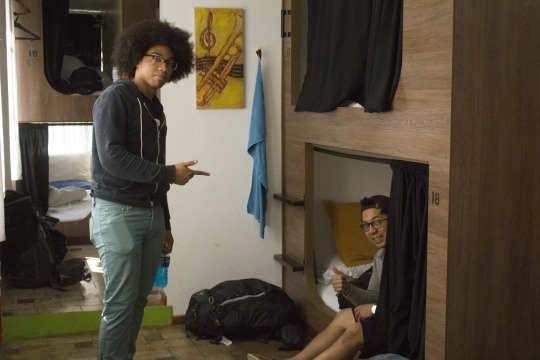
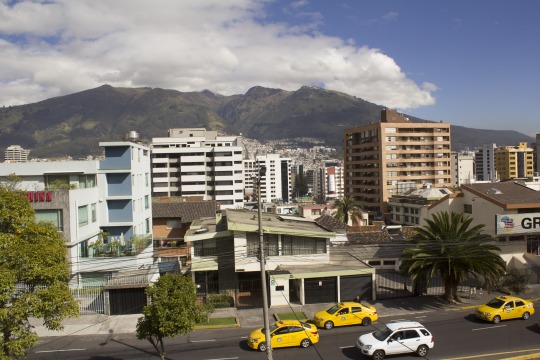
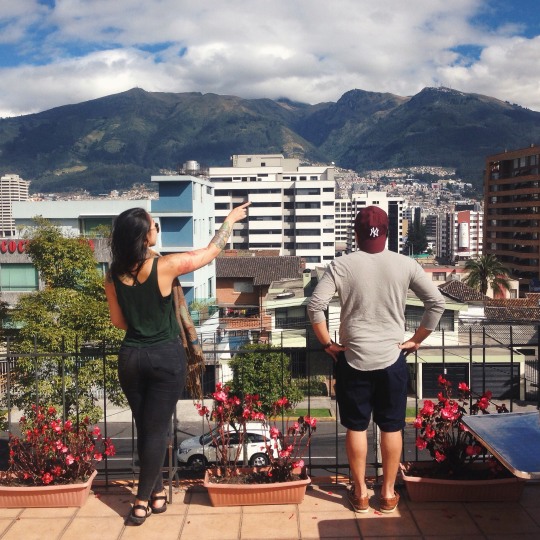
7/23, Saturday: DAY 2: BAÑOS
The bus ride to Baños ($4.50 from the Terminal Terrestre Quitembe, about 3 hours) was unbelievably beautiful. I watched in awe as we carved through the mountains, clouds floating just above the green peaks of trees and land.
Baños de Agua Santa (“Baths of Holy Water”), commonly referred to as Baños, is a city in eastern Tungurahua Province in central Ecuador, named after the hot springs located around the city which have a reputation of having healing properties due to their content of various minerals. It is known as the “Gateway to the Amazon,” as it is the last big city still located in the mountains before reaching the jungle and other towns that are located in the Amazon River basin. Baños is located on the northern foothills of the Tungurahua Volcano, at an elevation of 1,820 metres (5,971 feet) whose activity has been characterized by frequent powerful ash explosions and lava flows can be seen from the town. The last time the volcano erupted in October 1999, all 17,000+ residents were forced to evacuate the city for weeks.
(source: Wikipedia)
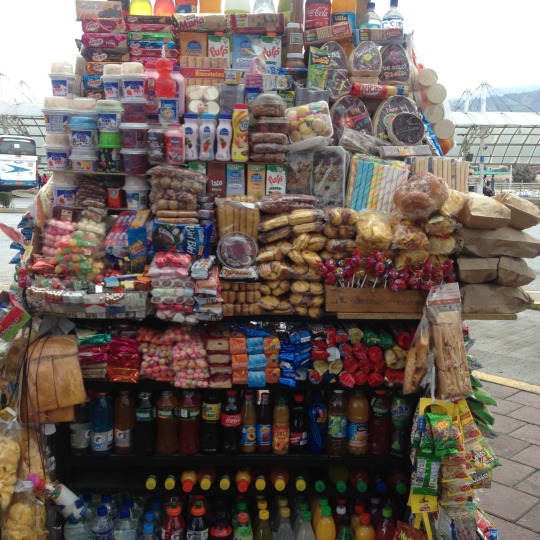

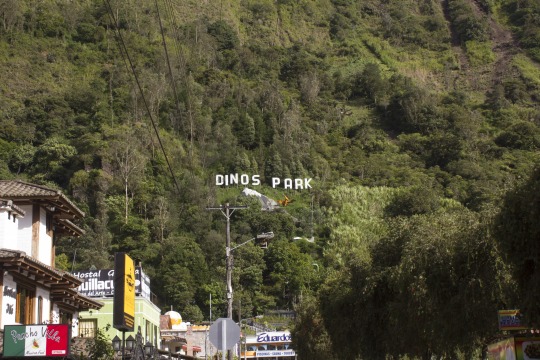
When we arrived, it was late afternoon so right after we checked in to Hostel Chimenea (~$14/pp per night for a 3-bed room), we headed out to catch the last of the slivers of sunlight spilling onto the nearby waterfalls and setting behind the cathedral square. Foolishly, we took the advice of our guidebook to eat at a local café called Café Hood, which despite its delicious meals, offered no authentic local cuisine. At least we got to taste some of the handmade sweets on our way back, including a taffy candy spun on wood, unique to Baños. We actually had stopped to buy some colorful hard candies ($1 per bag) but the woman who owned the cart was so friendly that she kept slipping in taffy into our bags for each bag of candy we bought.
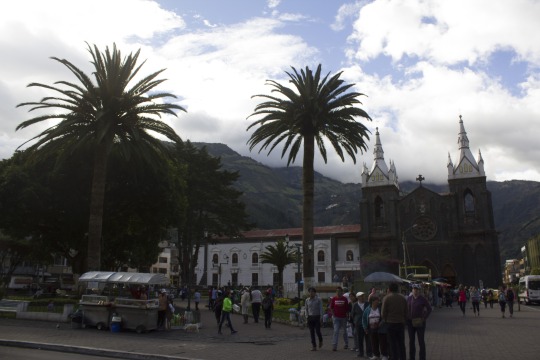

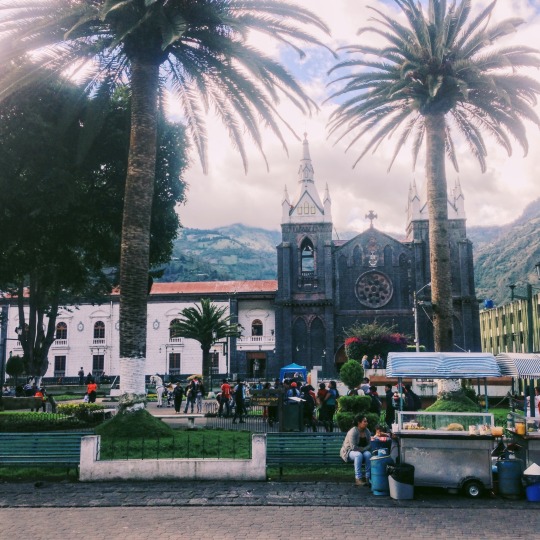
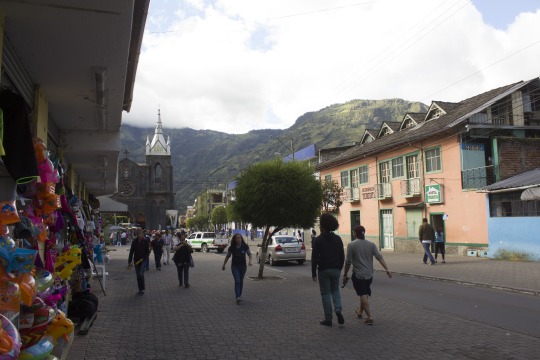
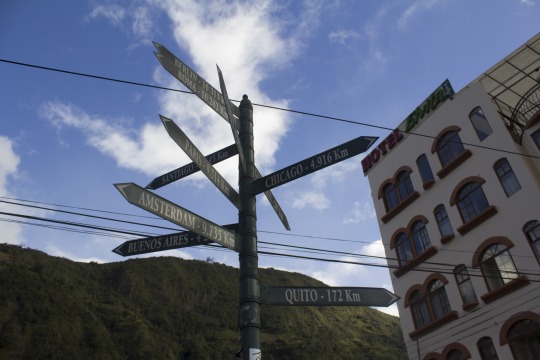
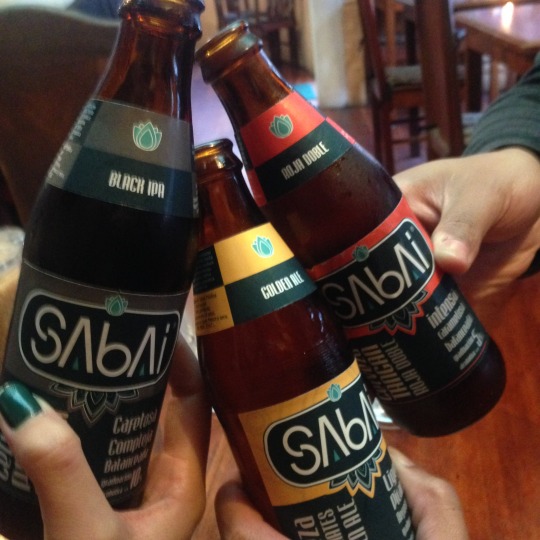
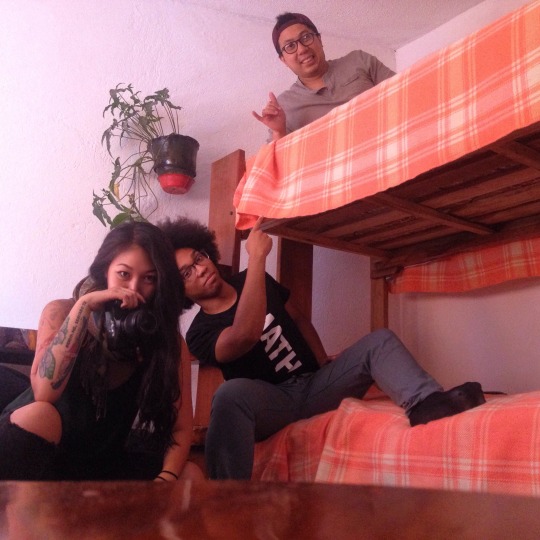
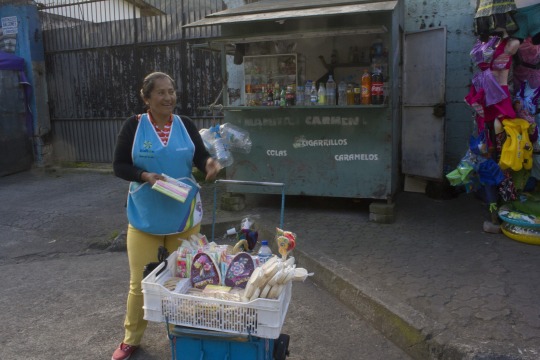
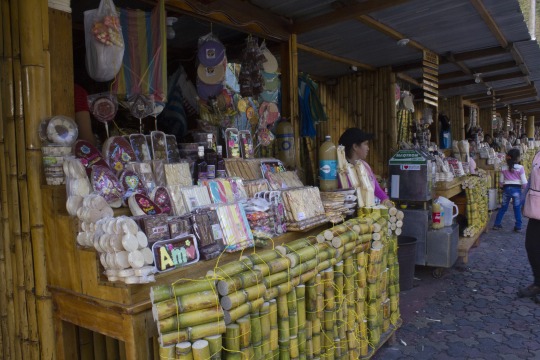
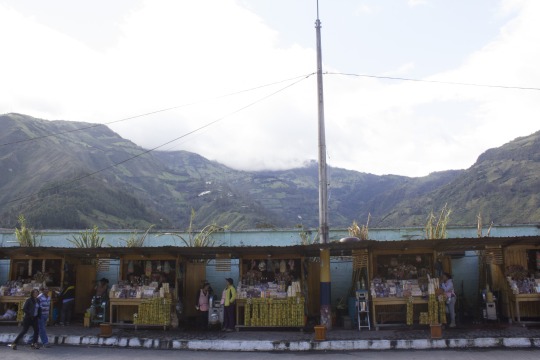
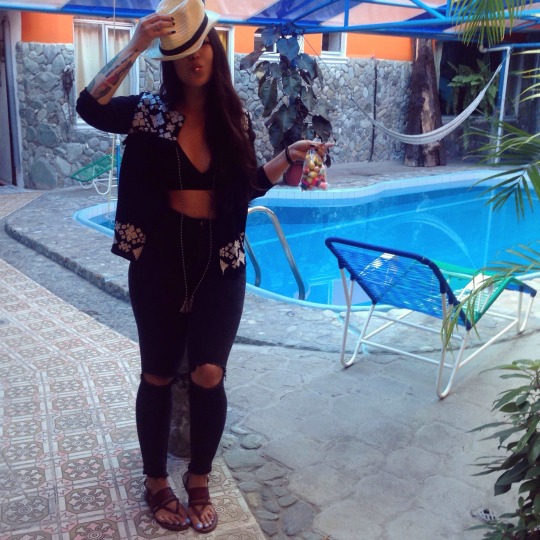
That evening, we headed out to the square to check out the bar scene. At the time, it was only around 7pm so all of the bars lining the streets in the center of town were still pretty empty. We settled down at a spot blasting rock music from its open front, where we met the only other bar patron, Mike.
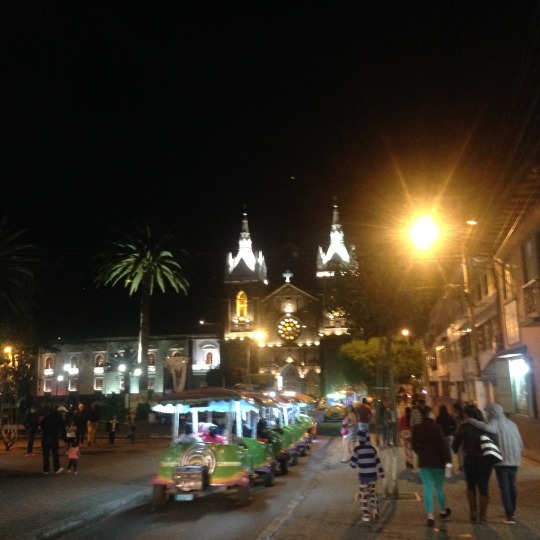
Mike is a United States Navy veteran, who fought in the Vietnam War and has been living in Baños for just about a year, after spending eight years living in Argentina. Like my brother Nathan, he has a deep admiration for Latin America, and like my brother Jordon, was an engineer (mechanical) before retiring. Despite his practicality, Mike is an empathetic man, with a love for the arts; especially music, which he “can’t listen to for too long otherwise I start to become real emotional.”
Immediately upon beginning our conversation, I knew I was meant to meet this person. I don’t mean that in any religious connotation, because like Mike, I don’t quite believe that religion is anything more than “the oldest form of government; they tell you what you can and can’t do, and then they say - by the way, we want your money.”
I just knew that conversation had to happen, then and there. In two hours, Mike gave me answers and asked me questions that I had been searching for and yearning to discover, but simply needed to hear from the right person to truly understand. He had lived a lifetime of wanderlust, with 52 countries and every state in the US of A in all their glory under his belt, which he traveled through on his motorcycle (like my roomie Ethan!). Mike had been through it all, and he was still living for more. I listened to his stories intently, hoping to gain some knowledge from his experiences as he recanted years of his life and all the wisdom that came with that.
He was so unabashedly honest, and I admired that. He didn’t hesitate to admit that because of his time in the war, he often had to come face to face with discrimination against Asians that spurred from that, and he hated that part of himself. As a first generation Chinese American, who has had my fair share of negative encounters with shallow-minded people, I had never heard this side of the story before. It was interesting to hear someone speak about a quality of themselves they hated, and has failed to change at his deepest core, to a person who could very well take offense by it. After Mike returned from the little boys’ room, he said that he wanted to clarify what he meant; that the bad memories create bad expectations of the associated culture he fought as he defended our country, but that he absolutely respects each and every individual and will never allow anything trump that. He then confessed, “I’m a human being and I’m not perfect, but I’ll always be honest.” That commitment to honesty brought up some curiosity from my end, including asking how he managed to live a life so full of travel. While he admitted the Navy funded a good chunk of the start, he told me of the two businesses he successfully built and ran, one of which he sold to an employee for $1 after his wife passed away. In his words, “your ability to adapt is your strongest quality. If you fear nothing, you can do anything.”
It sounds cliche, but that motivation was everything I needed to hear at this point in my life. I’ve never pictured myself settling into contentment, and yet I fear change just as much as anyone else. Mike reminded me that as long as I’m breathing, it’s never too late to learn anything - even how to love. Mike lost the love of his life 21 years ago to breast cancer, and even as he spoke of her to me, his eyes began to well up with tears. She was his second wife, after being divorced for 12 years “with a different girlfriend on my arm each week.” And yet, six months after their first blind date, they were married.
I asked him how - how he knew she was the one, how he could make such a drastic change, and how he made all those years work. The first two questions, he didn’t have much of an answer to. It was the same old spiel of “you just know,” but his answer to the third really stuck. He said that each month, both of them would sit down and tell each other what they had been annoyed with that past month and hoped to improve, and the other wouldn’t be able to respond until a week later, “because time allows you to discover a response, not a reaction.”
There was so much more that I learned from our talk, and I’m so grateful to have met an individual who impacted my perspective and encouraged my aspirations so genuinely. Every time I feel shy about practicing my Spanish, I hear Mike saying, “you can’t fear being judged when you’re making an effort to share someone’s culture, and if anyone wants to judge you for it, fuck ‘em.”
By the time I turned around from the bar, the streets were teeming with people of all ages, but mostly kids looking to party. Mike had recommended The Leprechaun, so we headed there and arrived to a line of people anxious to dance and a crowd just socializing in the street out front. As the obvious foreigners, we got pulled through the line and crowd right upstairs to complimentary shots - yellow, blue and red like the Ecuadorian flag, and lit on fire. It was, very literally, LIT.
By my next drink, I was ready to navigate the crowds to dance to some good ol’ reggaeton music (because the Salsa Room was still too intimidating) and by my last drink, I had an Ecuadorian dance partner. Lucky for me, he spoke English well, skateboards, has a tattoo of a pizza slice and partly owns a cool little pizza place down the street, has style for days, and to top it all off loves Kanye West and Big Pun. I thought of everything Mike told me earlier at the bar, but as classic Jasmine would do, I wrote it off as too good to be true and let him drive me back to my hostel on his motorcycle before letting it go. Don’t even think about saying anything to me about “this is why we worry you’ll be kidnapped some day” because I’ve already heard it.
7/24, Sunday: DAY 3: BAÑOS // CUENCA
The next morning, we woke up bright and early to head to our ziplining adventure, which we had set to depart at 8am. Still half-drunk, we stumbled into town to find the tour’s storefront closed, so we crossed the street for breakfast. Luckily, the friendly woman who booked our tour (and gave us a sweet discount for $20 per person) spotted us and walked in to ask if we wouldn’t mind waiting another half hour for departure to give the drivers more time to prepare. We welcomed the delay to take our time eating breakfast.
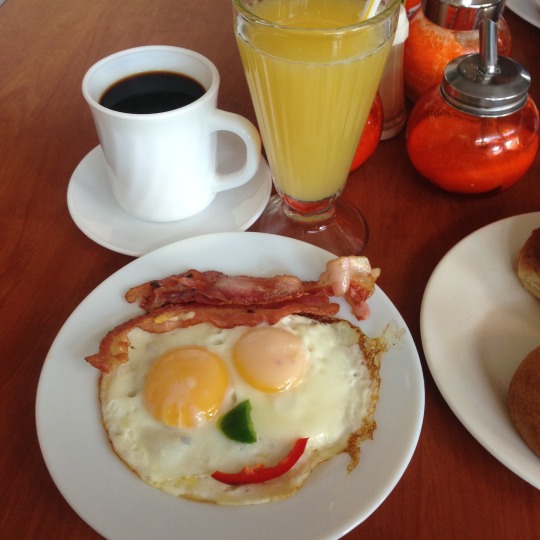
It was about a half hour drive up the mountains to our destination, Puntzan Canopy ($20/pp). When we arrived, our guide Jon simply strapped on our equipment for us and showed us the map of the 6 lines we would be going to that morning. There was no extensive safety training or waiver signing, which was a refreshing change from any kind of “adrenaline sport” that we have in the U.S. Once we hiked up to the first line, Jon explained where to put our hands on the line and how to slow down or speed up, then clipped one person in and we were off. I was super nervous for my first zipline but once I made it to the other side I realized it wasn’t so scary.. until our next line. The next line was a bit longer and a lot higher, and we were given the option to do this one in the regular “seated” position or upside down with legs crossed above our heads. Of course, I went with upside down. About halfway through, I started to slow down a little and for some reason thought I might fall and freaked out, repeatedly saying “holy shit holy shit holy shit” to myself - which I later realized would have been a terrible choice for last words. By the third line, I was feeling much more comfortable and got to experience the “superman” position which actually felt the most natural and gave me a sense of what it might feel like to be able to fly. The next few lines were much higher up and required a decent amount of hiking to get to, which was probably terrible idea for the morning after drinking heavily but also super rewarding. I wonder if I would have had the balls to do any of this had we not conquered Fuji last year. Pretty sure there are still remnants of my fear of heights lurking in my gut, though.
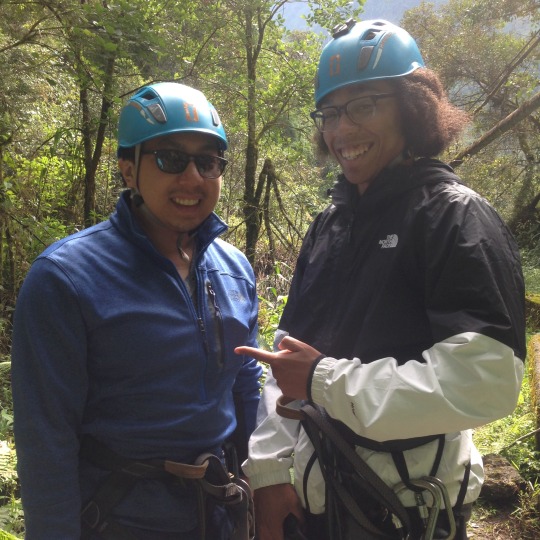
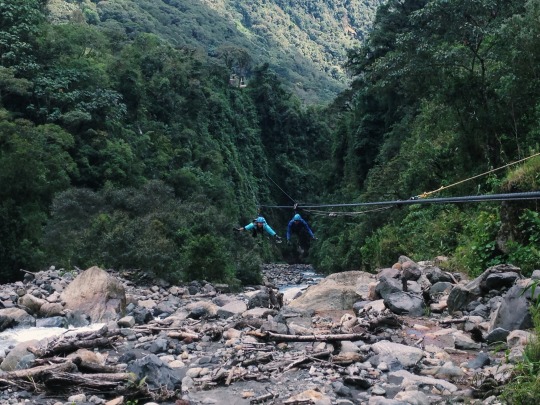
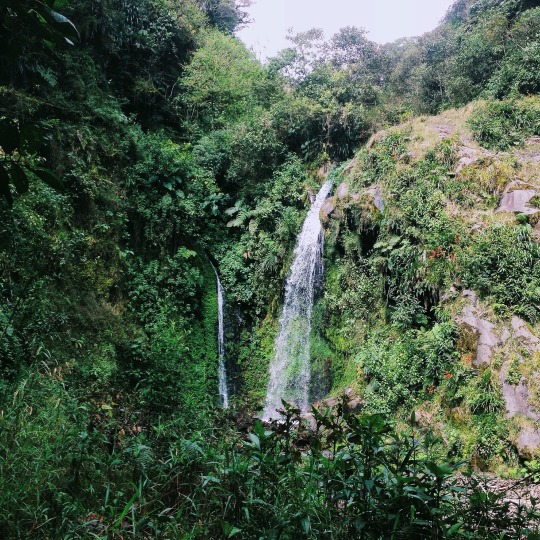
When we returned from ziplining (they call it canopying), we had just enough time to pack and check out of our hostel. Our next destination was Cuenca, (~$8 from the Baños bus terminal, 6 hours). Although I had looked into the bus terminal locations, cost, and time from city to city, I didn’t have the time for detailed schedules, so when we arrived at the terminal, we were surprised that there were no direct buses to Cuenca on Sundays. Instead, we could either take a bus to Riobamba or Ambato and then transfer. The problem was, when we arrived to Ambato, we had no idea how to get to the next bus. Since we were the last ones off the bus, I asked the driver where to go, and understood only the direction to walk towards. When we turned the corner and didn’t see any stations or bus stops, we decided to take a break for food. Right outside of the restaurant sat an elderly man, who although seemed like he might be homeless, made no gesture towards us for anything. But while we ate, I noticed one of the employees step outside with a bowl of food and a cup of juice, handing it over gingerly to the man. I thought about how rare this act of kindness would be in NYC and admired the respect the employee emulated. I figured this would be a good opportunity to ask him how to get to Cuenca too, and sure enough - not only did he type out in Google Translate that we needed to take a taxi to a bus terminal; he walked us outside, hailed a cab for us, and told the driver our destination before bidding us good luck.
When we got to the terminal, we were told it would be another 3 hours before the next bus to Cuenca. By the time we would arrive, it would be past midnight. Since I barely slept the night before, I didn’t mind the long bus ride ahead to catch up on some rest before checking in at La Cigale (~$13/pp per night for a 3-bed room) for real sleep. I was so tired when we arrived that when the concierge asked (in Spanish) if I spoke English, I answered (in Spanish) “only a little” and ended up carrying the rest of that conversation in Spanish. He was probably really confused at how slowly I was speaking but whatever, it was good practice.
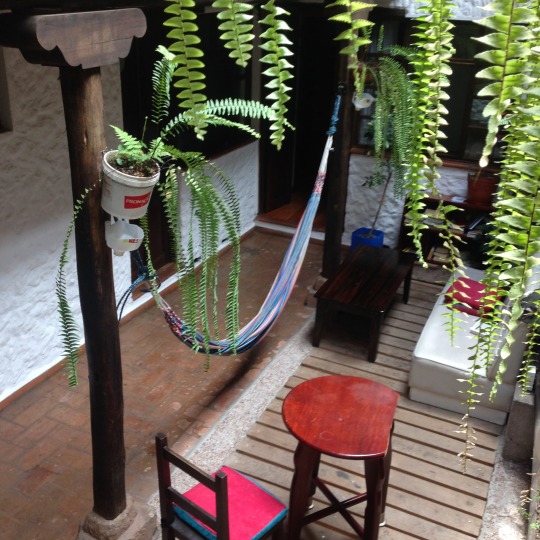
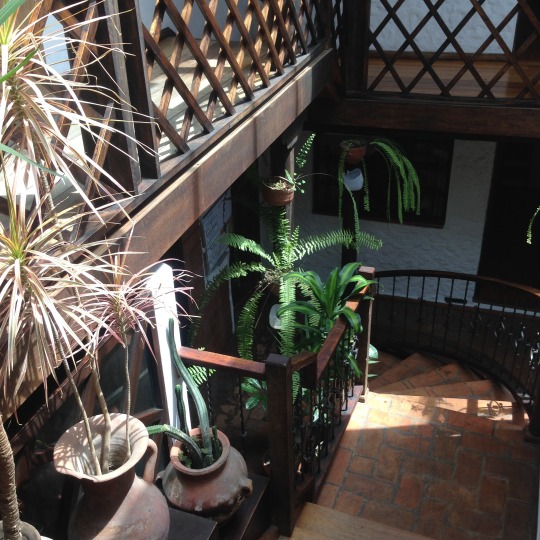
The city of Cuenca — in full, Santa Ana de los cuatro ríos de Cuenca — is the capital of the Azuay Province. It’s widely known as the most European city in the country of Ecuador due to its highly 16th and 17th century era Spanish colonial architecture resembling cities and architecture throughout Spain. Located in the highlands of Ecuador at about 2,500 metres (8,200 feet) above sea level, the centre of the city is listed as a UNESCO World Heritage Trust site due to its many historical buildings.
At least three cultures have left their imprint on Cuenca. When the Spanish arrived in the 1540s, they encountered the ruins of a great but short-lived Incan city called Tomebamba (“Valley of the Sun”). The Spanish eagerly dismantled what was left of it, incorporating the elegantly carved Inca stones into their own structures. Before the Inca, the indigenous Cañari people had lived in the area for perhaps 3,000 years. They, too, had a city here, called Quanpondelig (“Plain as Big as the Sky”).
(source: Wikipedia & Lonely Planet)
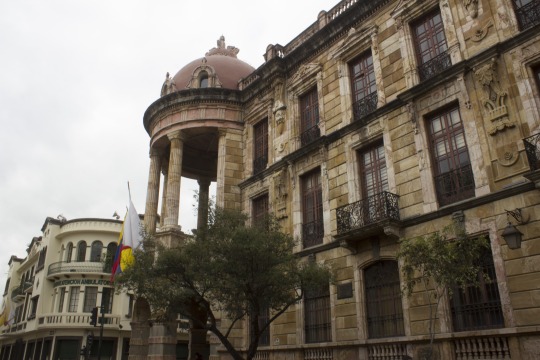
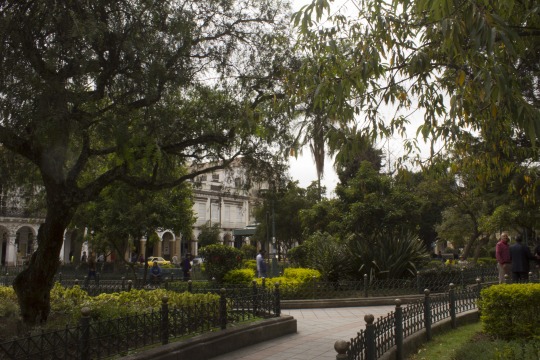
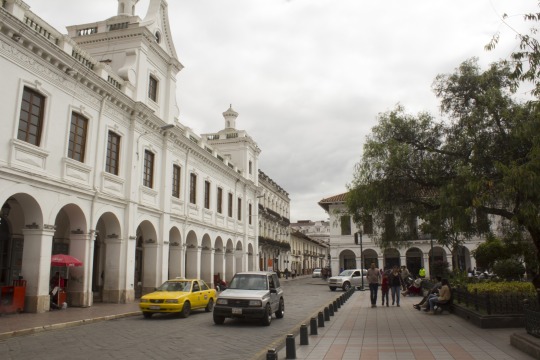
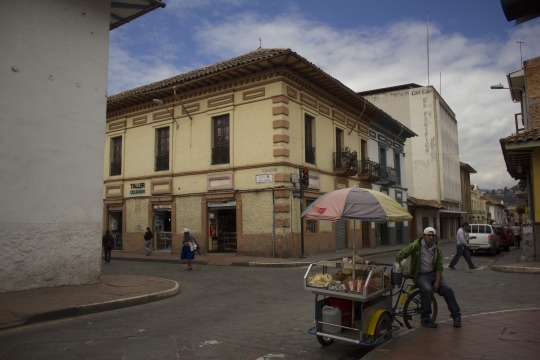
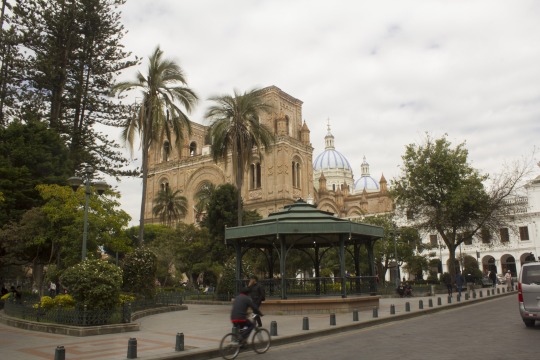
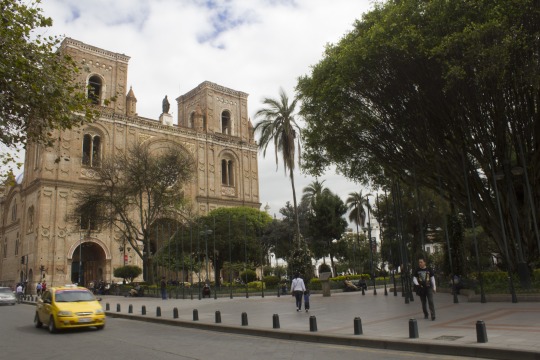
7/25, Monday: DAY 4: CUENCA // GUAYAQUIL
When we woke up, we figured we could squeeze in a few hours of exploring the beautiful colonial streets of Cuenca before having to take another bus to Guayaquil to catch our flight out to the Galápagos. We only had about 4 hours to walk around before having to check out of the hostel, so we gave ourselves two missions and decided we would just take photos of whatever we could along the way. Our first stop was food (duh), and we wandered into an inviting little place where one of the hostesses spoke English and welcomed us in. It was here that I ordered the first of many ceviches, none of which were disappointing despite their differences. The one here was ceviche de camarones, a little bowl filled with an abundance of sweet little shrimp in a savory, tangy vinegar with cubes of tomato, garnished simply with tiny slices of red onion and cilantro, accompanied by lime and a classic bowl of roasted corn kernels.
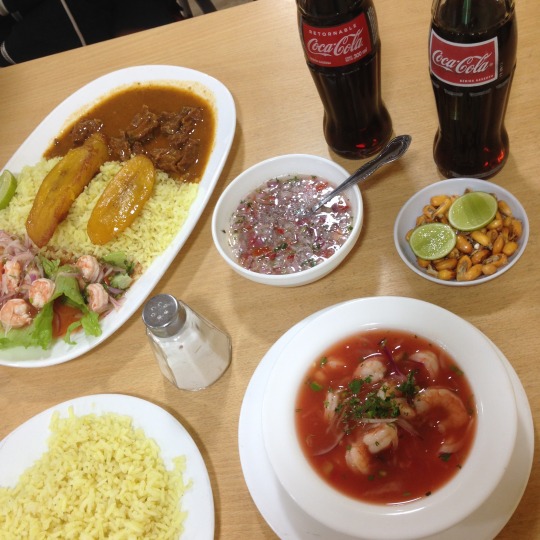
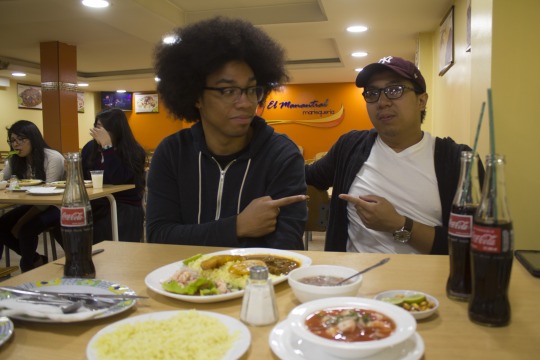
After we had lunch, we went on a mission to search for the best coffee in Cuenca. We didn’t do much research, but once we spotted Cacao y Canela, we knew we found something special. An adorable little café adorned halfway with cocoa beans and cinnamon (appropriate), halfway with kitschy Wisconsin license plates and random signage, we sat down as the only patrons and were quickly served by the attentive waitress. We each ordered a coffee, and Will tried the strawberry cheesecake. After our coffee fix, we walked back to the hostel to pack and check out before embarking on our next bus ride to Guayaquil (~$8 from the Cuenca Terminal Terrestre, about 4 hours).
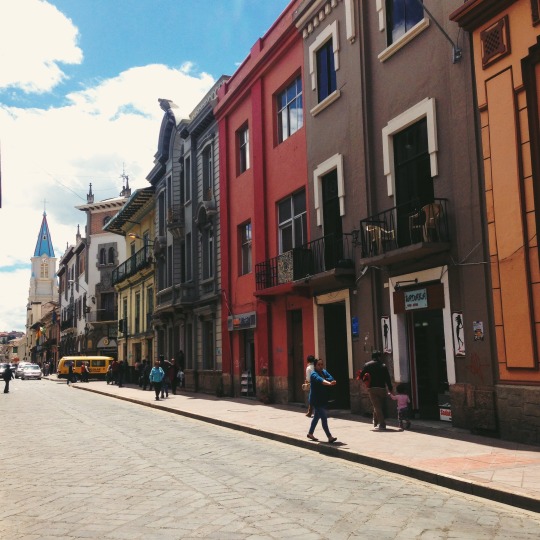
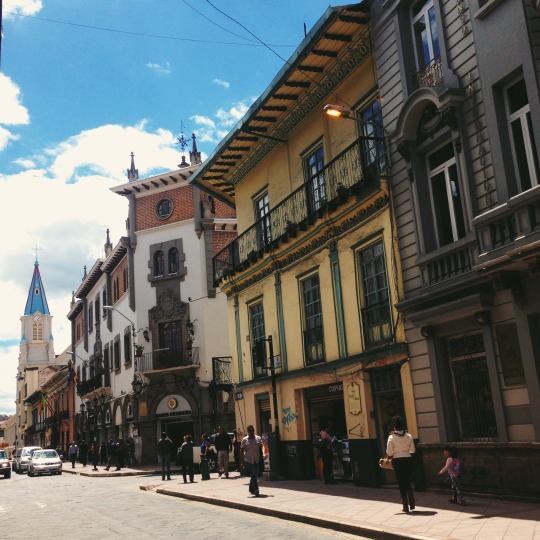
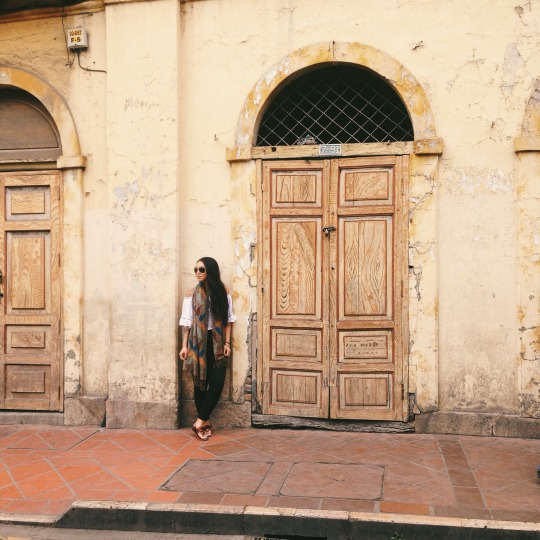
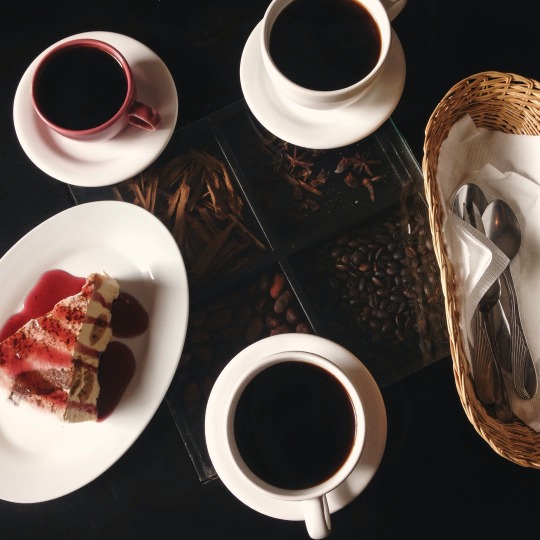
Once we got onto the bus at the Terminal Terreste de Cuenca, the ticket collector stood up to begin speaking to the bus. At first, we figured it would be the standard, 2-minute protocol of general safety precautions, maybe a spiel about how long the ride would be and when we would stop at a rest area. Nope. That speech turned out to be a solid 20 minutes (at least) about - from what I could understand - the dangers of Guayaquil and foodborne illnesses that could be contracted from certain food and drink there. I was baffled, but the 20-something guy sitting next to Will reassured him he didn’t need to pay attention to any of it. I suppose it made some sense, since Guayaquil is considerably more notorious for street crimes than colonial, picturesque Cuenca. But when we arrived, it didn’t feel too different from my experience living in Cebu - granted, the vibe was not like it was in Cuenca, but I felt at home amongst all the gated homes with glass-topped walls surrounding them, the bustle of people and busses in the busy streets, and the occasional stray dog roaming curiously about.
The difference between the weather in cool, breezy Cuenca to hot, humid Guayaquil was a welcome change for me since I prefer to sweat than shiver, but I guess so do mosquitos. Once we arrived in Guayaquil, it immediately felt more crowded and intense than the calm streets of Cuenca. We hailed a cab and shortly after realized that the driver couldn’t figure out how to get to our hostel, La Casa Tangara ($10/pp per night for a 3-bed room), when he stopped to ask local pedestrians for directions. It took a few stops and wrong turns for us to arrive to the metal gate door that our host slid open, which he locked once we stepped inside. This was probably our favorite hostel of the trip, because despite its metal gate doors and glass-topped concrete walls, the interior was decorated by beautiful botanical murals and equally as welcoming live plants lining the corridors and blooming around the outdoor dining patio. It was a small place, with only 3 bedrooms and a shared kitchen, living room, and laundry service, but the host was kind (and exceptionally friendly to Will), the WiFi was poppin, and the room was comfortable.
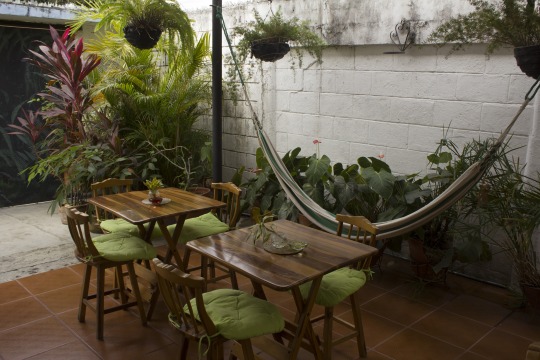
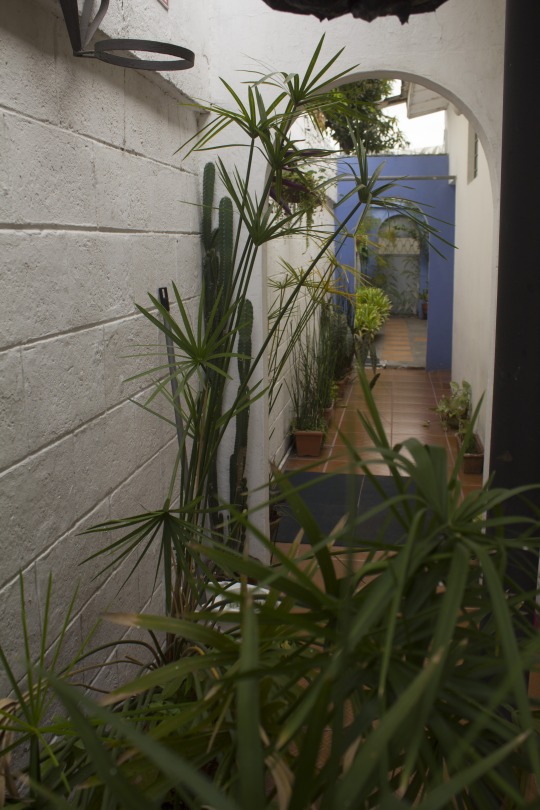
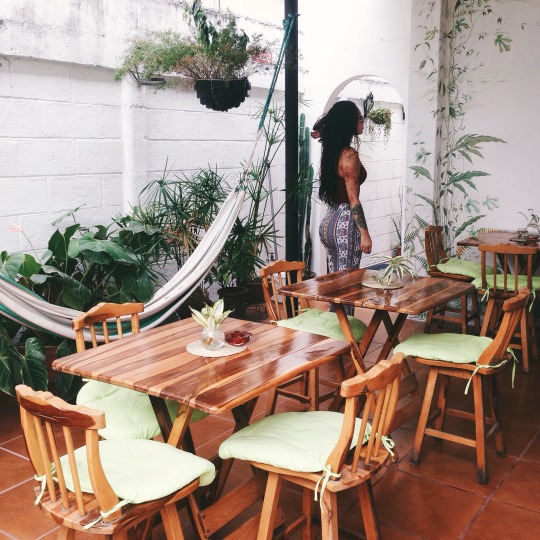
When we settled in, we asked the host if there was any place nearby for dinner, at which point he offered to call us a cab. We asked if we could walk there, but he cautioned that since the sun was setting soon, we should probably take the cab either to the mall, or a few local restaurants. Will asked him if it was safe to leave the hostel, and his response was, “Well, since today is a holiday, it should be safer” (it was Simon Bolivar’s birthday) - as if criminals need to be home with their families on national holidays, too.
We ended up taking a cab to the San Marino Shopping Mall, and made a full lap around to explore each floor and the food court before deciding to cross the street down the block to McDonald’s. Will and X have a tradition of trying the McDonald’s in foreign countries, and I guess I’m not completely opposed; I just refuse to have it more than once during a trip abroad. All I have to say is that the McDonald’s in Ecuador is on another level - as in, they have a separate dessert bar inside, and their fries taste at least 5x better.
Once we left McDonald’s, the most reasonable thing to do next was go to the nearest convenience store for snacks. Of course, being SnackGurl, I had to get a wide variety of snacks to try. I wasn’t very impressed - most of the chip snacks tasted kind of stale, and they were pale in comparison to the freshly fried bags of papas fritas you could get from the snack peddlers who boarded the busses with homemade local snacks (chips, peanuts, sliced fruit, etc).
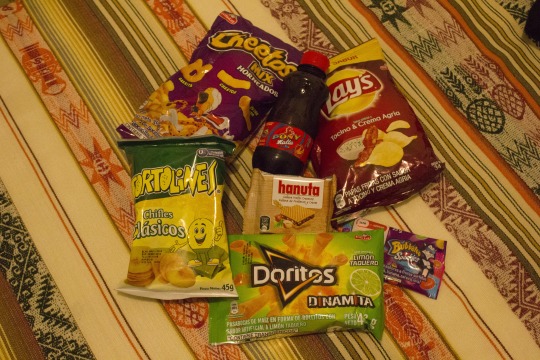
7/26, Tuesday: DAY 5: GUAYAQUIL // SAN CRISTÓBAL
The next morning, we awoke to breakfast made by our host - the most delicious scrambled eggs ever, buttered toast, watermelon, and coffee.
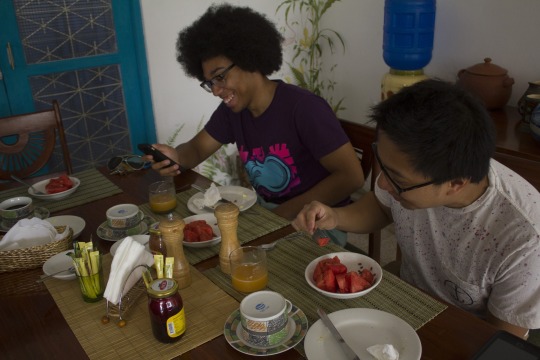
Once we packed, it was time to head to the José Joaquín de Olmedo International Airport to depart for the Galápagos. It’s important to note that the process for checking into a flight headed to the protected archipelago is much more extensive than most flights, despite that it is technically domestic. First of all, there are no direct flights to the Galápagos from outside of Ecuador. Flights depart from Guayaquil, Quito, and Cuenca to either of the two airports in the Galápagos - Seymour Airport (GPS) in Isla Baltra (also known as South Seymour), connected by ferry to Isla Santa Cruz, and San Cristóbal Airport (SCY) in Puerto Baquerizo Moreno on Isla San Cristóbal (also known as Chatham). There are only four flight times during the day, too - one in the early morning, and one in the early afternoon. I would highly suggest planning for at least 2 hours prior to departure time, since check-in requires applying for a tourist transit card ($20), then a preliminary baggage screening before you even step into the airport’s regular security and bag check.
Right before boarding the flight, to my pleasant surprise, I turned around and spotted Giselle, one of my brother Nathan’s best friends. Giss was with her cousin, Claudia, who lived in Cuenca. It was such an awesome moment of serendipity to realize we were on the same flight into Isla San Cristóbal together, and would be traveling to Isla Santa Cruz on the same date as well.
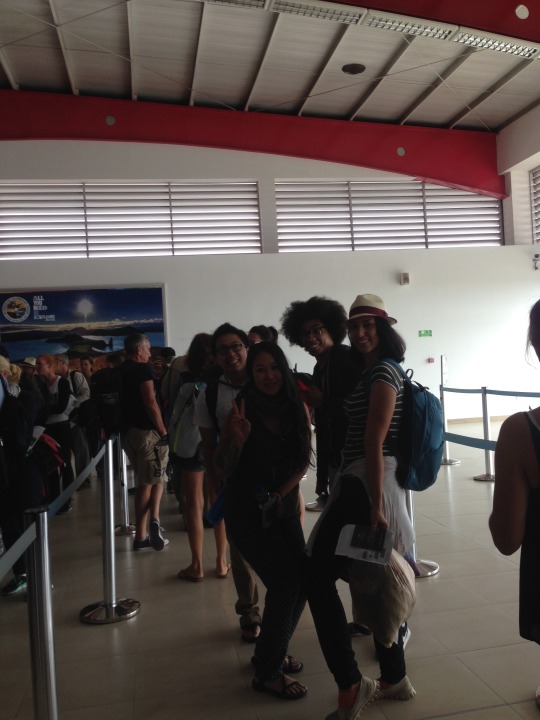
San Cristóbal (also known as Chatham) is the fifth largest and easternmost island in the Galápagos. It is the site of El Junco, the only permanent stream and source of fresh water in the islands, and is also where Darwin first went ashore in 1835. San Cristóbal is also the site of the oldest surviving settlement in the Galápagos, El Progresso, established in 1869. It has since been overshadowed by a second town, Puerto Baquerizo Moreno, located on the southeast coast.
(source: Cornell and Galapagos Conservancy)
When we arrived to San Cristóbal, it was actually a gloomy day with not much sunshine. Once the plane landed, we stepped off the stairs into the windy runway to walk towards the airport, where we were required to pay a $100 entrance fee (cash only!) to the Galápagos National Park. This money goes towards the conservation efforts made to protect the islands’ precious archipelago, where 95% of the land area is designated as protected by the Galápagos National Park Directorate (GNPD). In fact, tourists are permitted to explore specific visitor sites only with Park-certified naturalist guides. The GNPD coordinates group visits to these 60+ sites and carefully monitors ecological conditions.
(source: galapagos.org)
Once we exited the airport, a line of white pick-up trucks were ready to depart from the curb - these are the standard Galápagos taxis that can be found on any of the 5 inhabited islands (Santa Cruz, Baltra, San Cristóbal, Isabela, and Floreana). Of the 21 total islands, there are 18 main islands, 3 smaller islands, and 107 rocks and islets - for a total human population of roughly 25,000. Since most of the islands and islets of the archipelago are not inhabited by humans, they do not permit any overnight stays. In fact, the visiting sites, even on the inhabited islands, are only accessible from 6 am to 6 pm. Since we landed in the afternoon, we only had a little bit of time to visit one of the beaches that day.
(source: Wikipedia)
First, we settled into our hostel Casa de Laura (~$45/pp per night), where unfortunately they had mixed up our reservation. Rather than one room with three beds, we were separated into two rooms, but at least Will and X were directly above my room, despite that we ended up paying more than we expected to for our stay here. They also did not have laundry available here, the bathroom reeked of mildew, and breakfast was not offered, so overall it was not our favorite hostel.

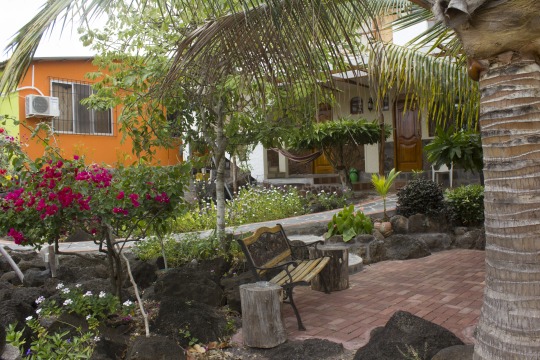
We decided to wander to Playa La Loberia, a beach I had read about that promised an abundance of lazy sea lions, and committed to the long walk down a wide dirt paved road that lead to a rocky beach. I was ecstatic when we finally approached the soft sand after more than a mile of gravel, and saw the first few sea lions lying by the water, basking in the cloudy daylight. Underneath the nearby shrubbery, a few other sea lions hid beneath the branches, resting on each other’s butts. I can’t remember how much time we spent on that beach admiring those beautiful lazy creatures, but by the time we left, the sun was just beginning to set and we were hungry. We headed to a little place decorated with lots of plantlife and trinkets, with flags from all over the world hung from the ceiling. Of course, I had ceviche again.
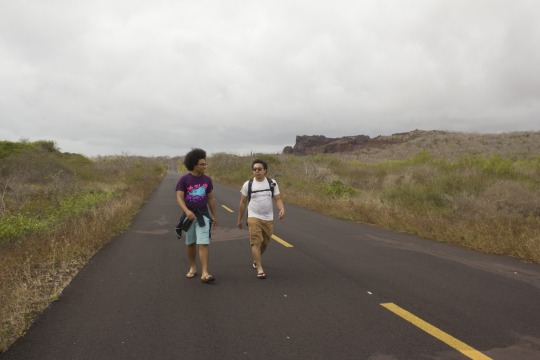
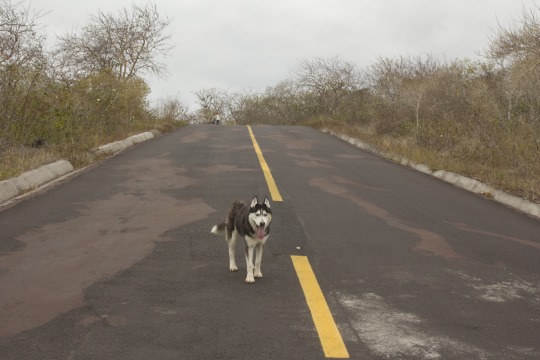
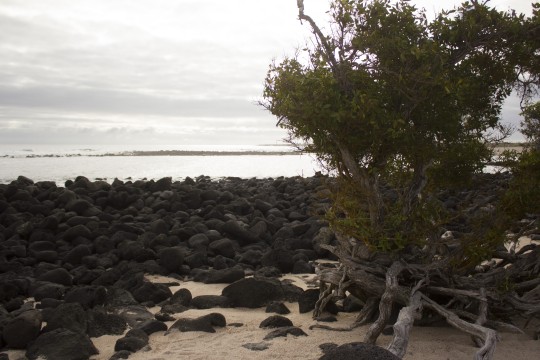
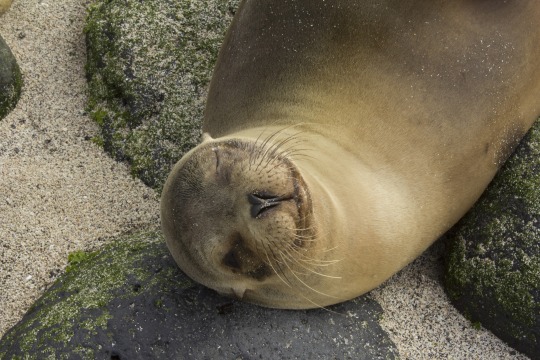
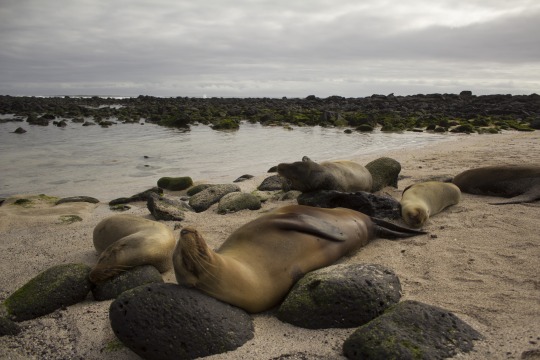
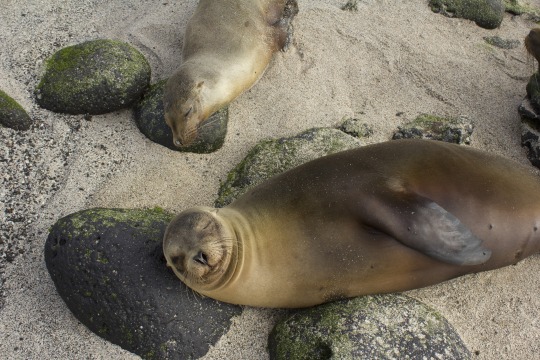
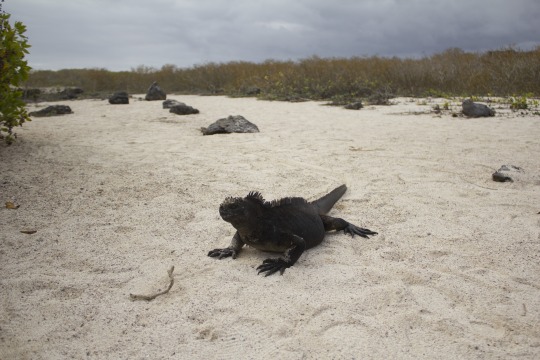
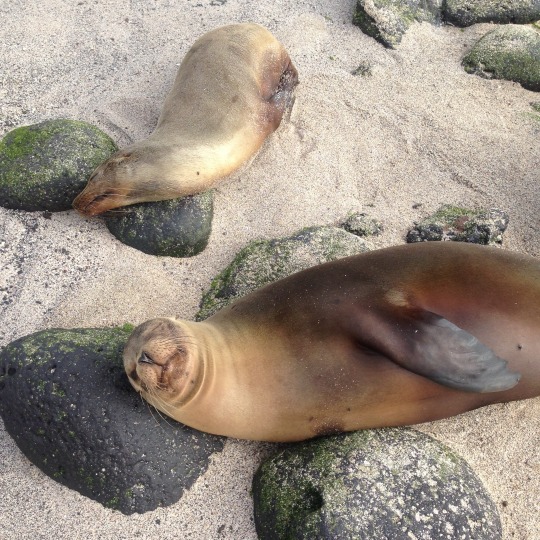
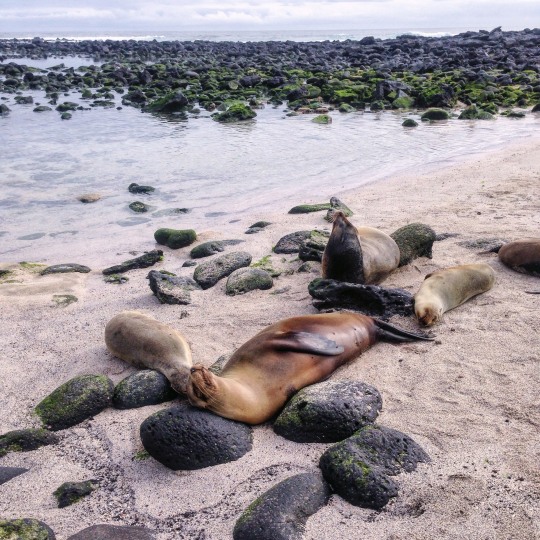
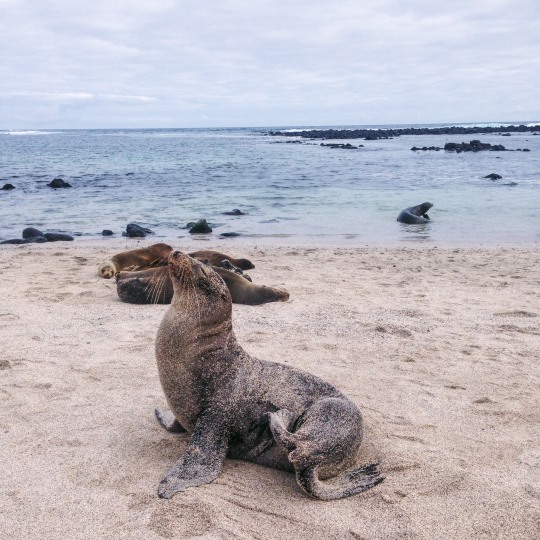
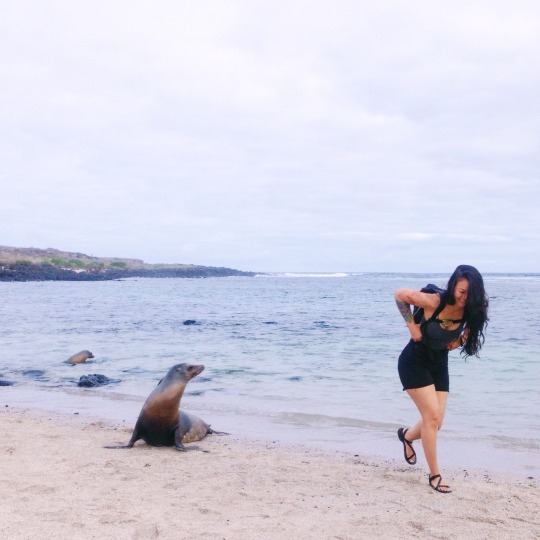
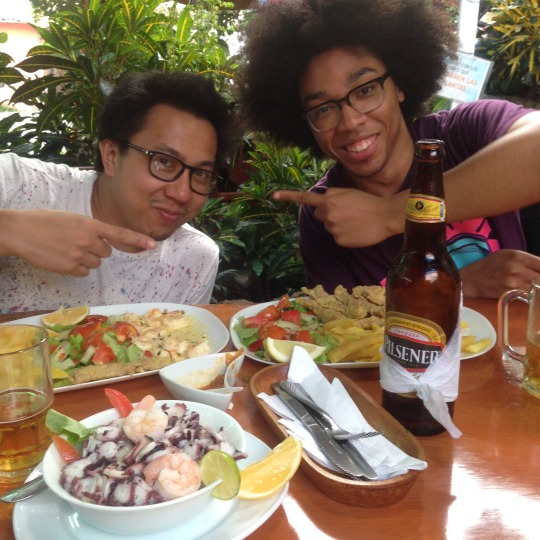
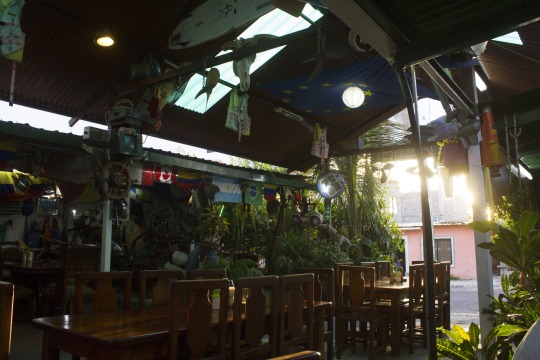

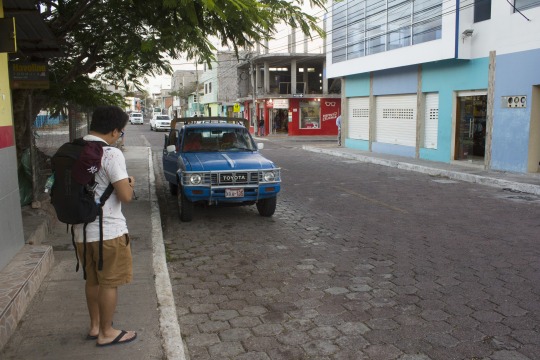
That night, we met with Giselle and Claudia for drinks and to book a tour with one of the local tour groups that they had spoken with earlier. This is where we met Javier, the absolute friendliest man I have ever met in my entire life. Words can’t do this man justice, so I highly recommend that you visit Pacifictour in San Cristobal to meet him. I guarantee that you will smile immediately upon seeing him, because he glows with a rare genuine joy. Our tour experience with Pacifictour was perfect from start to finish, and I’d like to at least credit Javier for getting us off on the right foot. Besides giving us a discount (we each paid around $120, as I recall - as opposed to the usual $180 for day tours), he was so patient with each of us as we tried on our snorkeling gear and wetsuits to prepare individual snorkel bags for the next morning.
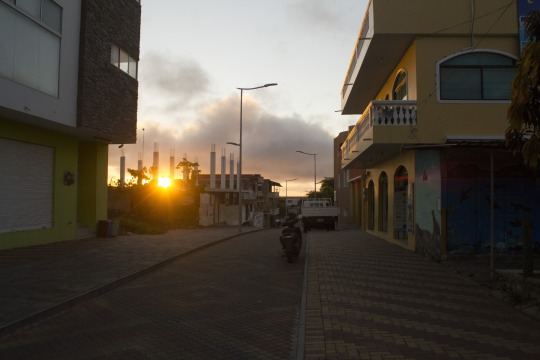
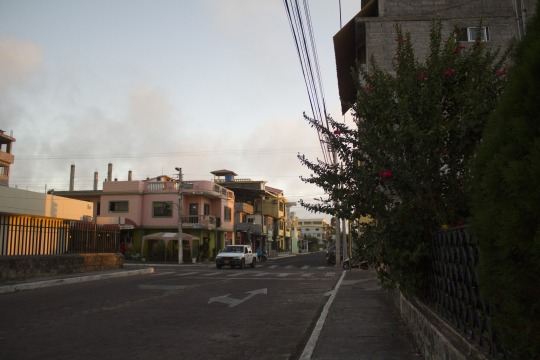
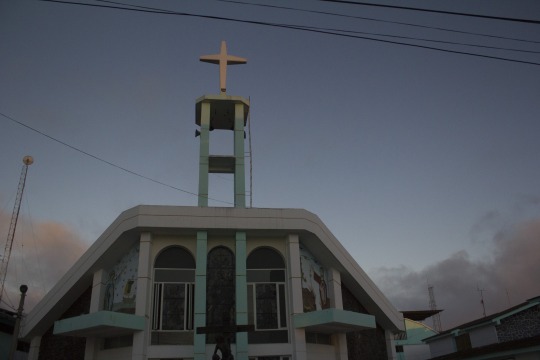
After we settled our tour arrangements, we headed over to El Barquero, one of the few bars in the small surf town of Puerto Baquerizo Moreno. When we first arrived, they looked like they might still be closed, but once we gingerly entered the gate, an older man stepped out of the house to greet us and lead us to the bar that was in the back. Before we could walk in, though, a younger surfer-looking dude asked us for our passports, but some of us were only carrying our driver’s licenses as ID. He made a fuss about this and almost refused to let us in, but Giselle insisted that his demands were ridiculous. By the time we entered the bar, hidden in a small corner beyond the pool table on gravel ground, the tension in the air was already stiff. So when I ordered two shots of whiskey to celebrate Giselle’s birthday and the man arrived from behind the bar with two low-ball glasses for $15 each (beers are usually around $1-3, cocktails don’t normally exceed $10), we weren’t ecstatic. We finished our game of pool quietly before heading out of there, since we had to wake up early the next morning anyway.
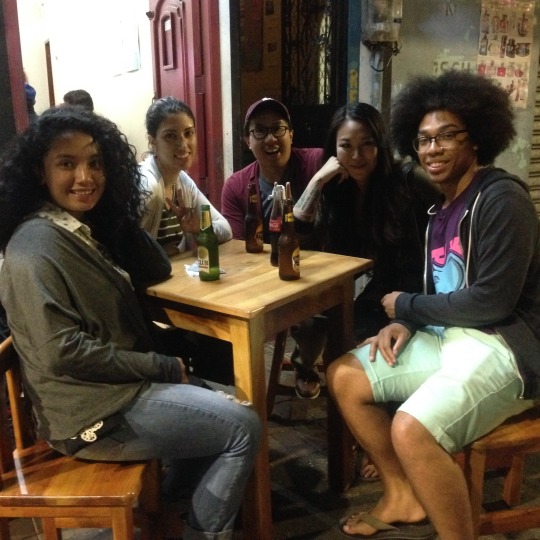
7/27, Wednesday: DAY 6: SAN CRISTÓBAL
By the crack of dawn the next day, we sleepily headed over to Casa Mabell where Giselle and Claudia were staying to meet up and walk over to Pacific Tours together. When we arrived, Javier was already ready to go, bright-eyed and bushy-tailed with all of our snorkeling gear in tow. I wish I could say that he spent the rest of the day with us, but after he walked us over to the pier, he bid us a good trip and headed back to the tourism office. We didn’t really know what to expect, but we were greeted by a very friendly crew of a captain, first-mate, and our tour guide, John Zúñiga. Our group of friends was joined by one more friend when we met Inês on the tour, who was traveling solo in the Galápagos before and after meeting with friends on the mainland. It felt like fate that we all found each other in these magical islands.

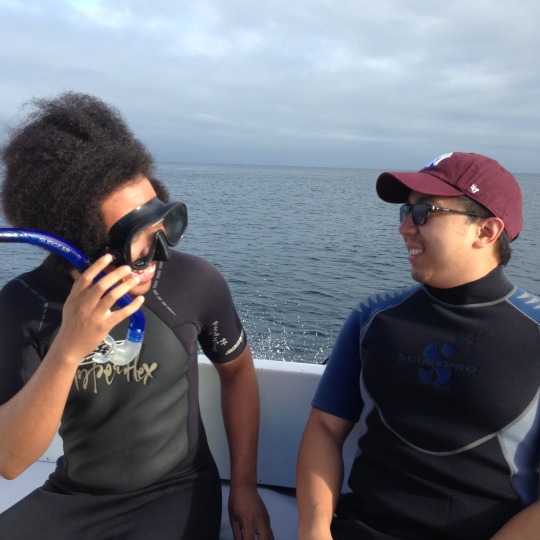
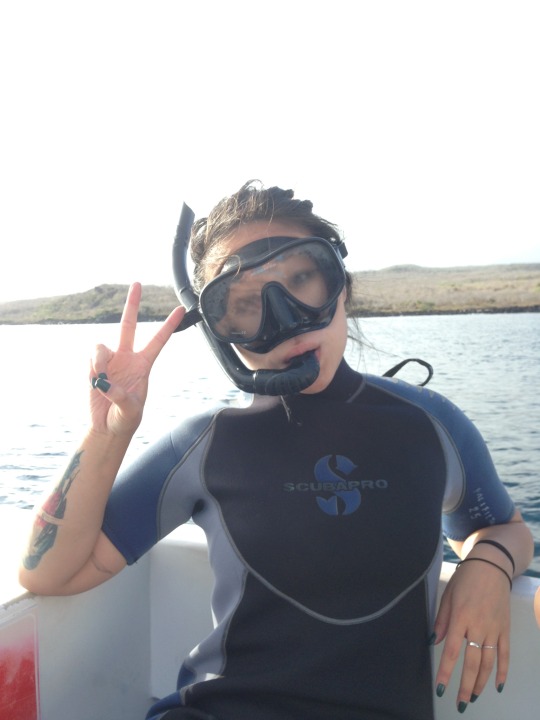
Our first stop on the tour was to León Dormido (“Kicker Rock”), two monolithic rock formations that jut out from the sea, towering over 500 feet out of the Pacific Ocean. When viewed from the south, it looks like a sleeping lion, hence its Spanish name; from the other side, it looks more like a boot, hence the English name. Split with a channel between that reaches 62 feet deep to the sea bed, this iconic landmark of the Galápagos was formed by natural sea erosion to the remains of a volcanic stone. The natural erosion of this ancient cone has created a channel between the rocks that provides the ideal habitat to view a variety of sharks and rays including Spotted Eagle Rays, White-tip Reef sharks, the elusive Galápagos Shark, and Hammerheads. This was a true test to Will’s first time swimming in the open ocean, let alone his biggest fear - sharks.

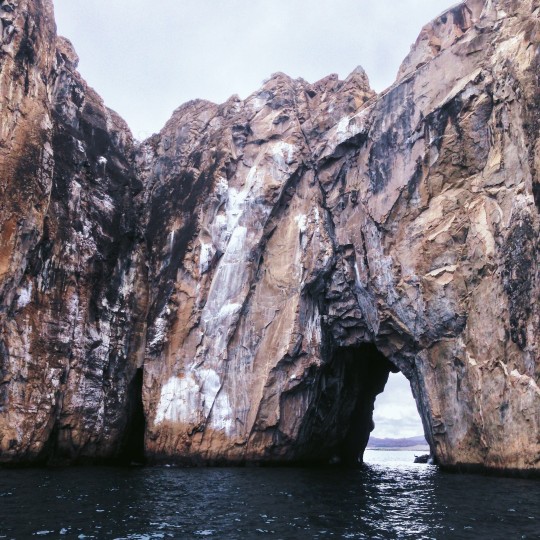
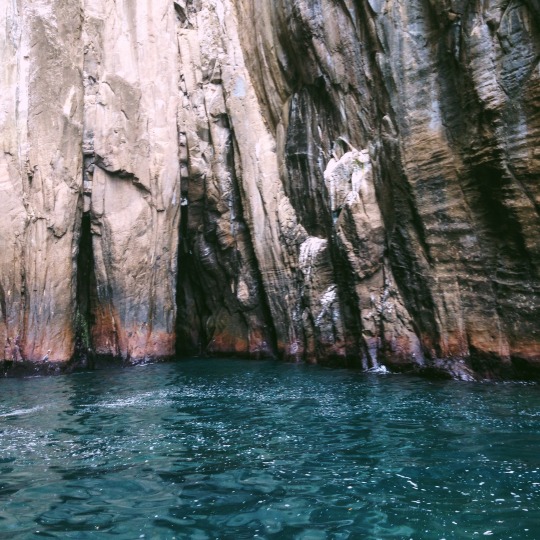
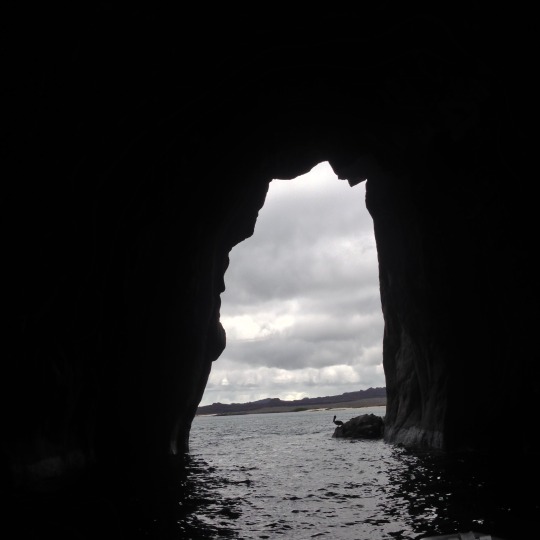
When we first dove in, the water was so cold we all screamed. First we swam from the boat towards the channel, where most of the shark spottings usually are. It was pretty dark in the channel, so visibility wasn’t the best, but once I spotted the shadow of a gigantic Galápagos shark lurking on the ocean floor, my heart began to pound. I’m pretty sure Will had a panic attack because he started choking on water and swam back to the boat to fix his mask. Although I was nervous at first, once I settled into the movement of the waves, I felt at home. The ocean is by far my favorite place to be, and every part of it is so magical to me - except for the jellyfish that kept stinging me. I couldn’t figure out what the sharp pricks were until later that day, when little trails of swollen skin appeared in all the areas I was zapped, itching uncontrollably. Thankfully these stings weren’t deadly and were sort of like intensified mosquito bites. They ended up leaving scars that lasted a few weeks.
After we exited the tunnel, we swam around Kicker Rock for a while, admiring different specifies of beautiful, vibrantly colored fish. But nothing was as majestic as the gigantic sea turtle, gliding past us playfully with his peaceful vibes, allowing the barnacle growth on his shell to just chill there as if a testament to his absolute chillness.
Our next stop was literally paradise - Bahía Sardina is a soft white sand beach located on the northwest coast of San Cristóbal Island. Made of coral and volcanic ash, the sand here is known for being as soft and white as powdered sugar. While we were here, John advised us to step carefully by the dunes and only walk in the areas that he led us through, so as to not disturb potential sea turtle eggs buried in the sand. Sea turtles lay their eggs on the same beach that they were born, sometimes searching from beach to beach until they find the right one.
While we walked along the crystal clear turquoise waters, a few baby egrets and great blue herons swooped about, pecking at the water for vulnerable fish. Above, a frigate bird circled around menacingly, its swift black tail swirling behind each of its graceful dips. The frigate bird is the largest avian species in the Galápagos, and known as the “pirate bird” because of its second-hand feeding habits. Since the frigate bird doesn’t have any oil glands to oil its feathers, it can only hunt outside of the water, pirating the food straight out of other birds’ mouths!
(source: our awesome guide, John Zúñiga - I learned so much!)
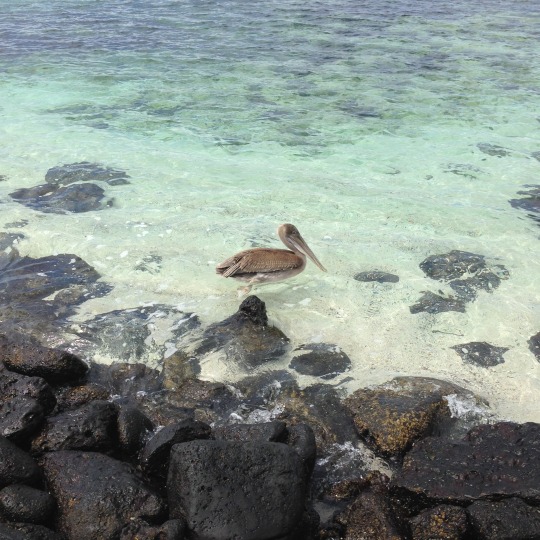
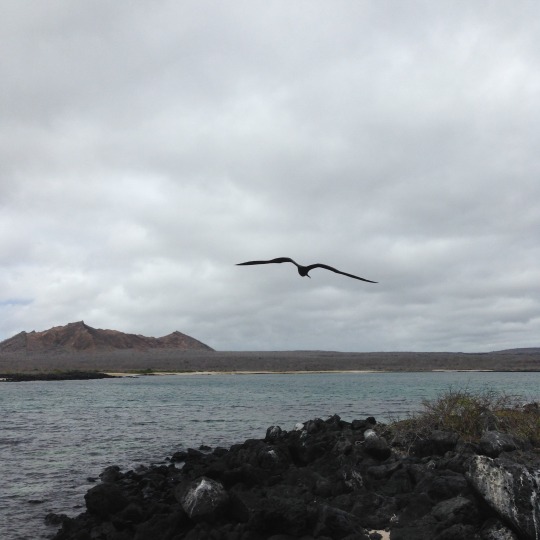

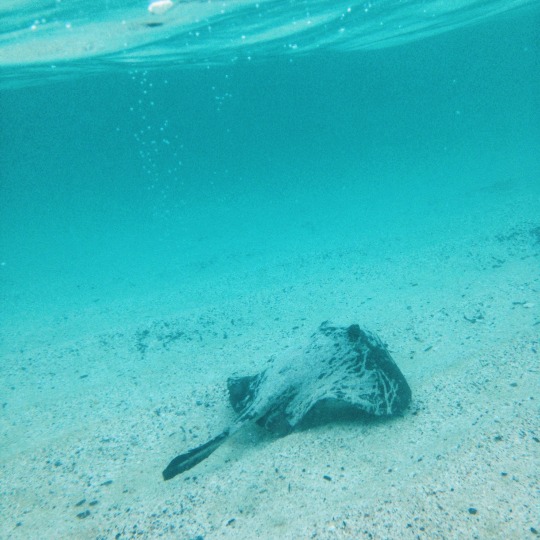
They say that your favorite animal is one that your personality emulates most, and I don’t disagree. I have a lot of favorite animals, but the sea lion is definitely in my top ten. I can’t believe how incredibly lucky I’ve been to be able to see some of my favorite animals in their natural habitats, gleefully living their lives the way the universe intended. I thought that I had reached my pinnacle of happiness last summer when I visited Fox Village in Japan, but seeing these glorious animals basking in the sunlight in their fully natural habitats filled my heart with unbelievable joy.
My brother had forewarned Giselle that she would have a hard time separating me from the sea lions, and I surely didn’t disappoint. As soon as this little guy swam up to me, I was enamored. Sunbathing alongside this spectacular sea lion has got to be one of my favorite memories, and I will always cherish this moment that made me feel so connected with the earth and all of its beautiful creatures.
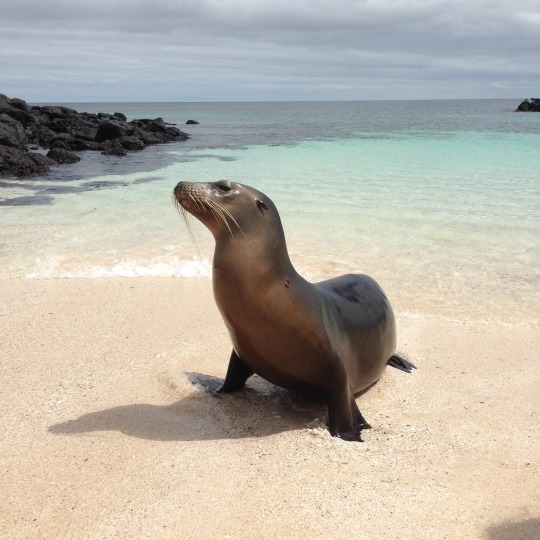
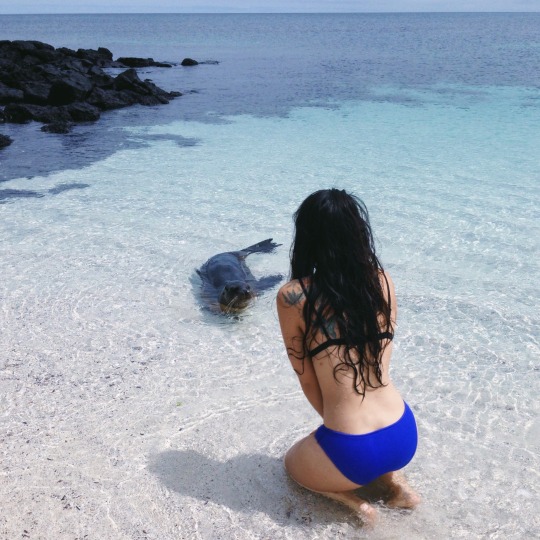
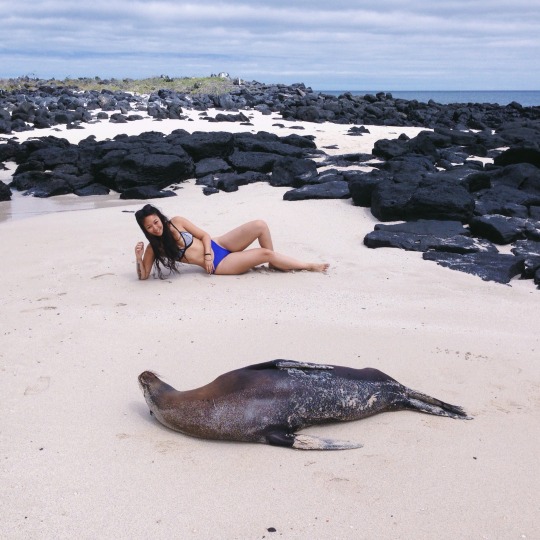
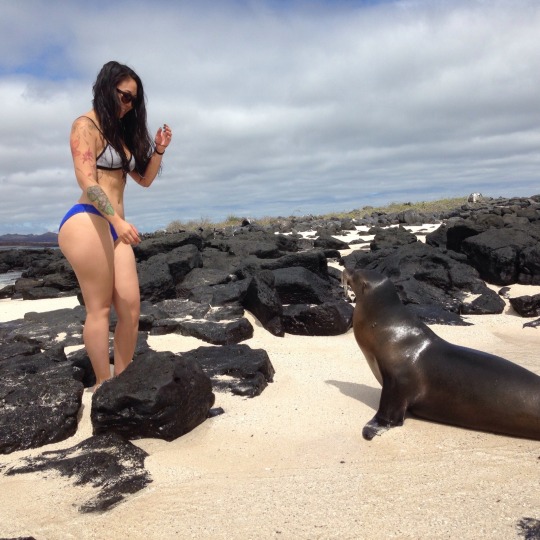
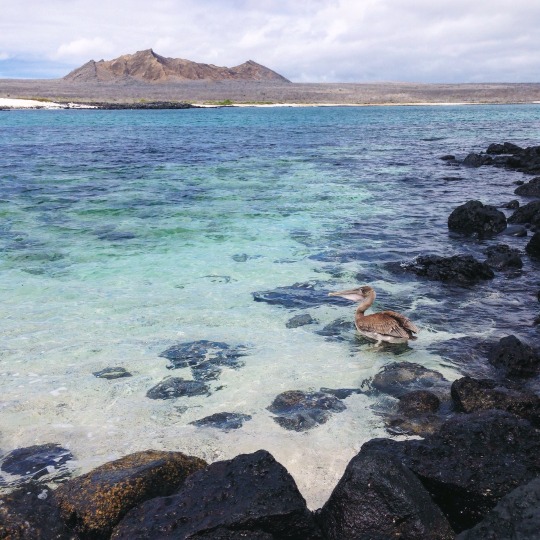
The next destination was equally as breathtaking, but in a slightly different way. We made a wet landing to the soft sands of Bahía Rosa Blanca, and headed towards shore to reapply sunscreen before embarking on a rocky hike through the trail of lava rocks to a small inlet, where dozens of white tip reef sharks were gliding, weaving seamlessly around each other in perfect synchronicity. We all admired their grace in awe when suddenly John asked, “so who is ready to swim?” Given that sharks usually swim to inlets to feed, where they can trap their prey in the corners of the inlet, we glanced nervously at each other as a few of us hesitated to gear up. Sensing our fear, John explained to us that generally, white tip reef sharks are friendly. They’re curious, and will swim up to humans very closely, but rarely attack unless provoked. They’re also kind of kinky. White tip reef shark’s mating is initiated when up to five males follow closely behind a female and bite at her fins and body, possibly cued by pheromones indicating the female’s readiness. Each male attempts to seize the female by engulfing one of her pectoral fins; at times two males might grasp a female on both sides simultaneously.
(source: John Zúñiga)
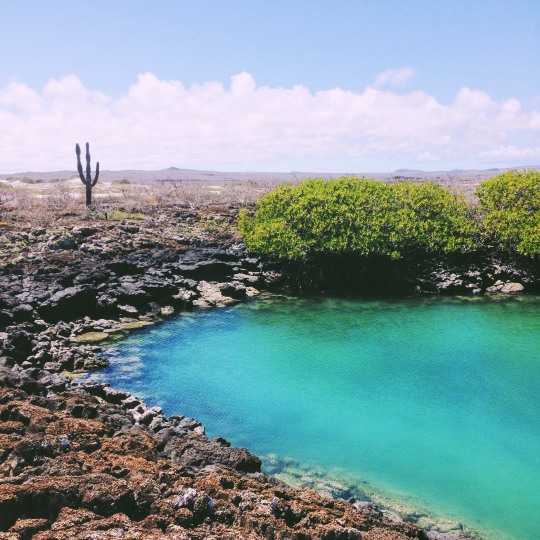
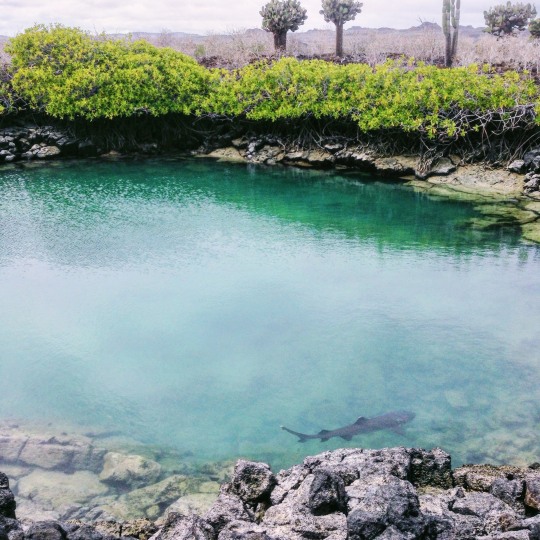
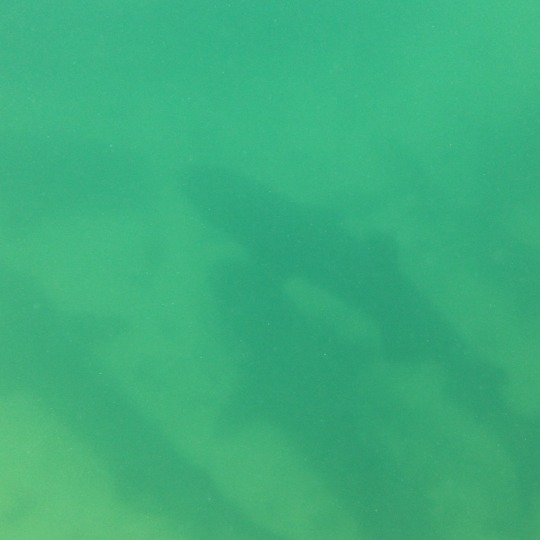
Claudia and Will were the first to dive in as I struggled to adjust my mask, and as soon as they entered the water, the sharks began to circle menacingly beneath them. I opted out of fins, as I feel more comfortable swimming without them, but neglected to notice the sharp edges of the rocks and barnacles leading into the inlet until I cut my foot. The cut was minor, so I decided to continue in and swam towards the sharks, who were now slightly less visible as they darted around a bit more urgently, kicking up dusty clouds of the sea floor sand. I nervously made my way towards John, Claudia, and Will, until my mask began to leak. I headed back towards the edge to grab hold of land while fixing my mask, but as soon as I reached for footing, a razor sharp rock sliced my foot, which immediately began gushing blood.
When I asked John if the sharks could smell my blood, he responded, “well yes, of course they can smell it - but I think they know you have human blood, not fish blood.” He seemed unsure, so I asked if he thought it would be safe to get back in the water with them. Again, he hesitated, “welllll, I think it will be okay, if you are brave enough.” You know me well enough to know that I took that as a challenge, so back in the water I went. Unfortunately for me, by the time I got back in, the rest of the group had gotten out for a break. Now I was alone in the inlet, bleeding, swimming above hungry sharks. My heart was pounding with fear and adrenaline at every movement below me. I decided it would be best to keep my bleeding foot out of the water, so I bent my knee and lifted it up - swimming with one leg only. Later, Ines showed me pictures she took as she laughed at me, swimming around with one foot out of the water like a shark fin. Now I was one of them.
After our shark adventure, John took us for a short tour around the bay as he pointed out the different species that he spotted. One of my favorites was the San Cristóbal lava lizard, endemic to the island and super frickin’ cute. The microlophus bivittatus species are small reptiles with long, tapering tails, slim bodies and rather pointed heads. Their toes are long and pointed, and unlike geckos, they are active during the day. Highly territorial, both males and females defend territories against intruders of the same sex. Both sexes challenge intruders initially by performing 'push-ups’ with their front legs, although this behavior is more vigorous in males. Often times, the males will use their tails in defense against each other or predators, which if bitten off, is not fatal but will not grow back. Female lava lizards prefer male mating partners with longer tails, so if you’re a male who is prone to lose in fights, don’t expect to get any.
(source: John & Quasarex)
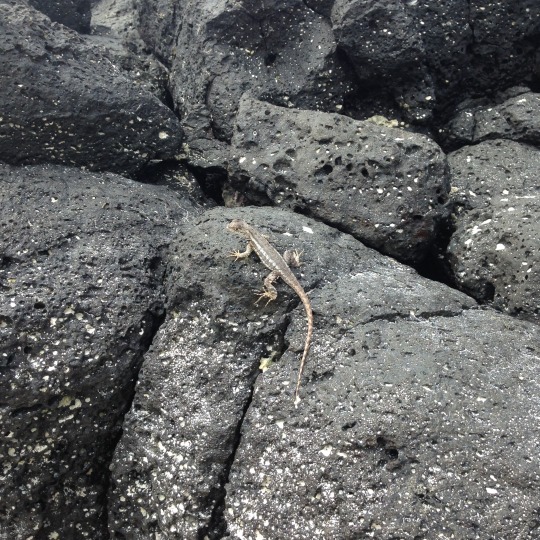
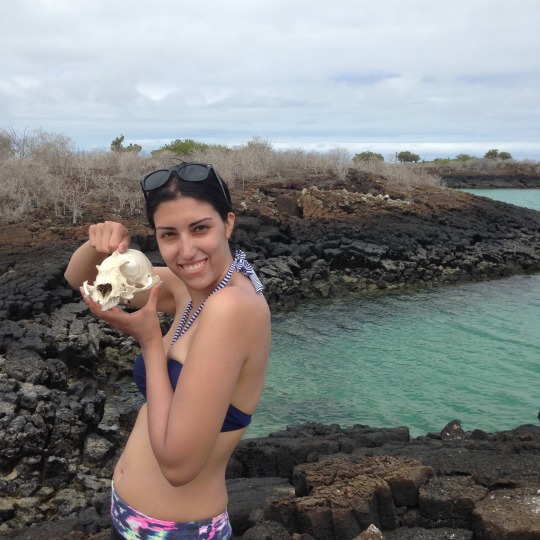
John also explained to us that the reason why the sand on the beaches of Bahía Rosa Blanca are so soft is because it is composed of fine particles of coral. In fact, the sand is so soft that you can slowly sink yourself into it by shifting and twisting without lifting your feet. Once you’ve embedded yourself ankle-deep, if you try to tug upwards without shaking your feet, you’ll find yourself stuck.
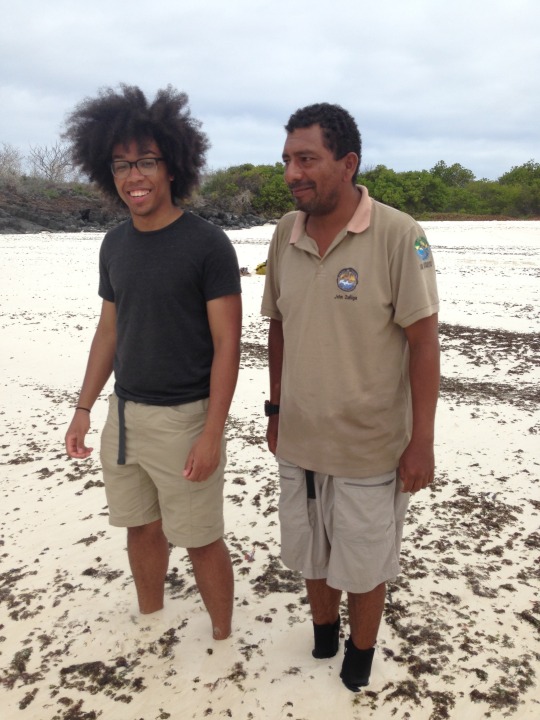
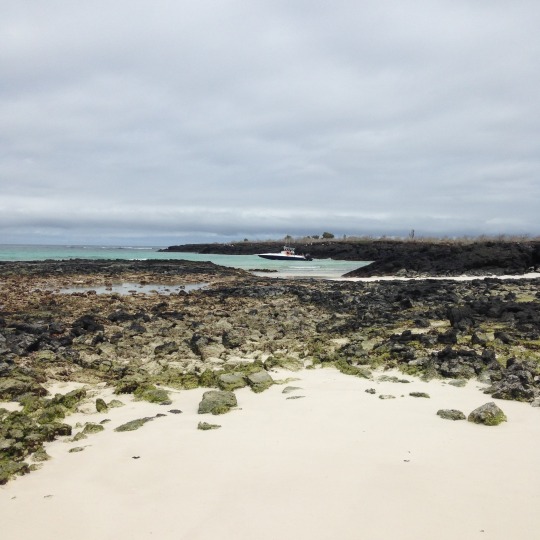
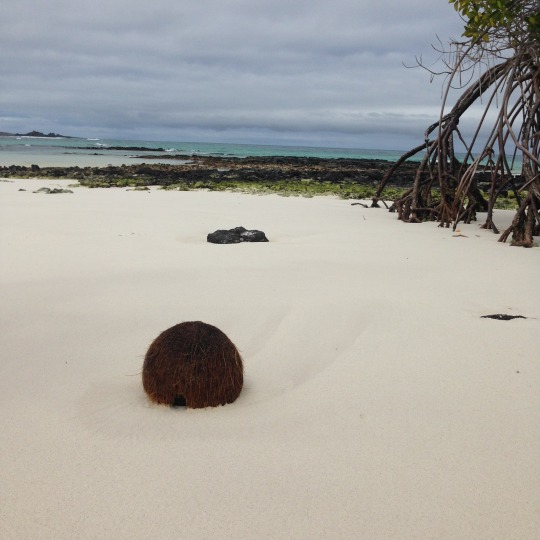
Alas, it was time to leave paradise and board the boat again, where we were served fried fish, rice, and salad for lunch. Like Inês said, it was the most beautiful place we’ve ever eaten lunch. As we started to head back to port, dark clouds began to form. The timing was perfect, because we weren’t scheduled to dock at another stop until we made it back to port, so we were just racing against the clouds to make it ashore. By the time the rain caught up to us, the waves were so rocky that the boat ride turned into a rollercoaster ride. I’m glad no one in our group is prone to seasickness - I love rough boat rides! Along the way, we spotted a humpback whale in the midst of swimming in the storm. The humpback whale, which can weigh up forty-five tons, is perhaps the easiest whale to identify and one of the most fun to watch. Their dark-blue or black bodies are covered in barnacles and they like to “spy hop” by raising their heads out of the water to look around.
(source: About Galapagos)
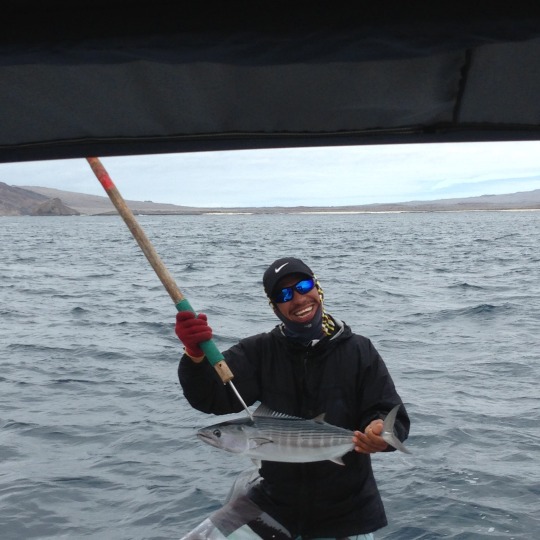
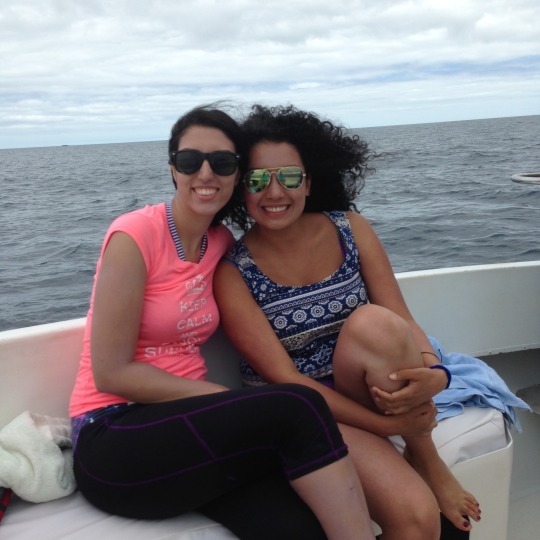
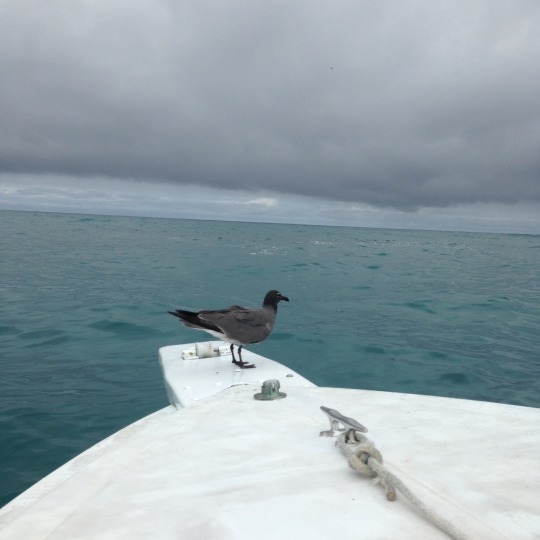
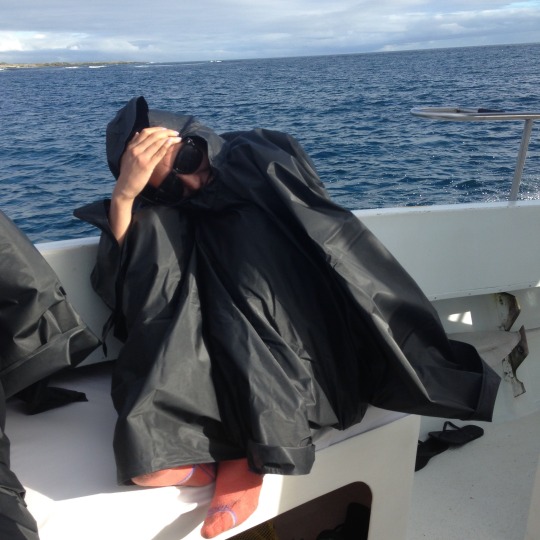
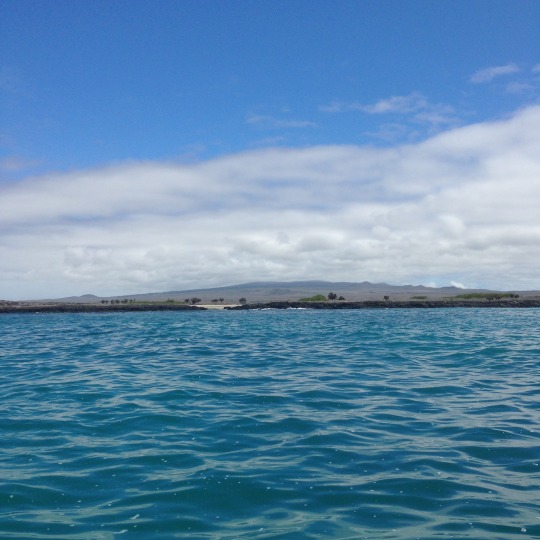

Once we made it back to port, we felt the wave of exhaustion settle in, so we decided to part ways to shower and rest before meeting together for dinner. Giselle and Claudia had to catch up on homework, so Will, X, and I set out to meet up with Ines. We took Giselle’s advice to “just follow the smells” when we were deciding where to eat, and so we followed the same smell I had been mesmerized by the night before. Let me tell you, that was one of the best decisions I’ve ever made, because the food tasted even better than it smelled. It was just a little local spot, called Picanteria “Sapita” with two tables inside, and a few tables outside along with a grill where the delicious smells were emanating from. The choices on the grill were chorizo, porkchop, or chicken - all equally as tempting, but the chorizo looked so pretty that I had to go with that. It was served with a side of colorful pasta salad and a full plate of white rice and beans, almost too much food for me to eat! I can’t remember the exact price, but it was definitely not more than a few dollars, and well worth every cent.
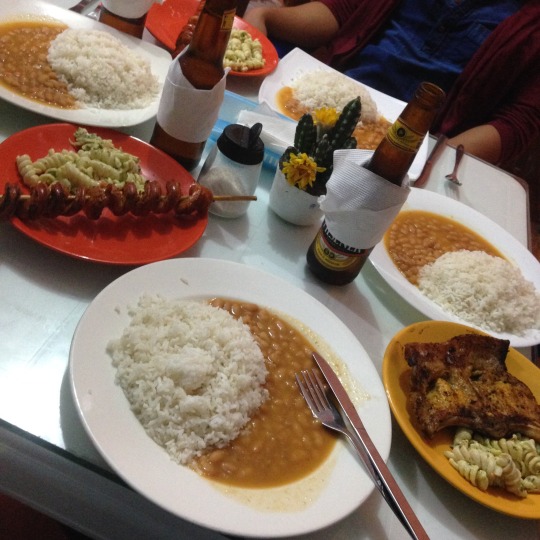
We decided to spend our last evening in San Cristóbal at Bar Iguana Rock, a local bar/lounge with a pool table and dance floor. They were so much more welcoming and friendly than the nasty encounter we had our first night at El Barquero. In fact, I still follow them on Instagram and it looks like they’ve expanded into a restaurant specializing in artful displays of sushi too! I can’t wait to go back to try some, because every photo looks delicious. Coincidentally, while we were there, the first mate from our boat tour showed up to play pool as well! We all knew he had a crush on Claudia so we kept teasing her as he begged her to dance salsa with him.
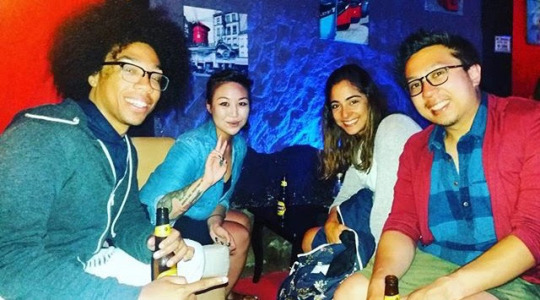
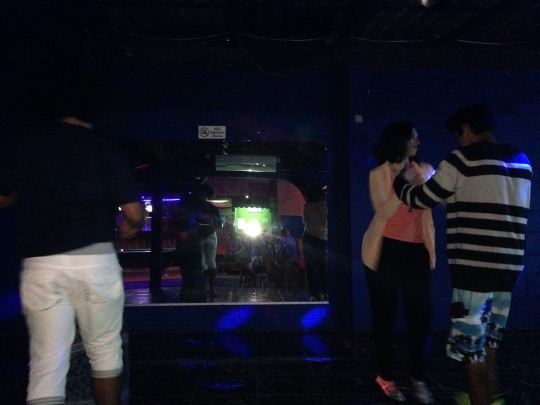
As the night wound down, the girls left to get some rest before our day of upcoming travel. Will, X, and I, on the other hand, were hungry again. We thought we were hopeless as we started to trek back to the hostel through the sleepy surf town that turned into a ghost town at night, when suddenly, I smelled something. Lo and behold, my nose led me to J&J Restaurante, where burgers and hot dogs were being taken fresh off the grill by Mr. JJ himself (I’m not sure if his name was JJ, we just kept calling him that). Bless you, Mr. JJ. Bless you for your contributions to mankind and late-night snackers.
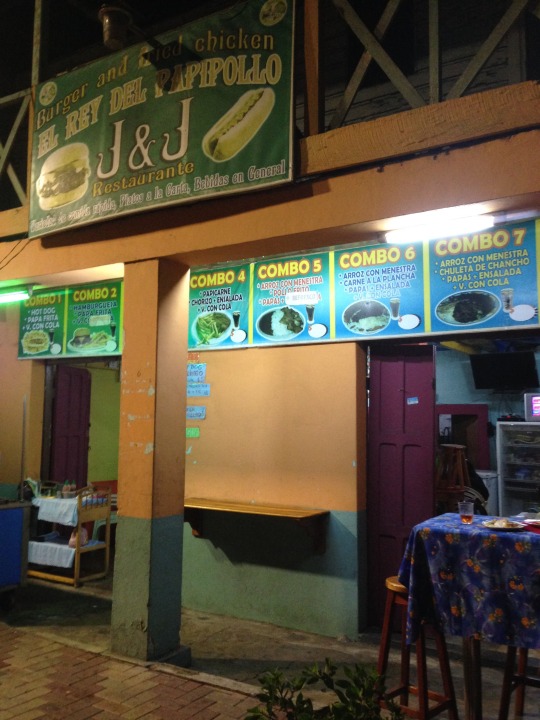
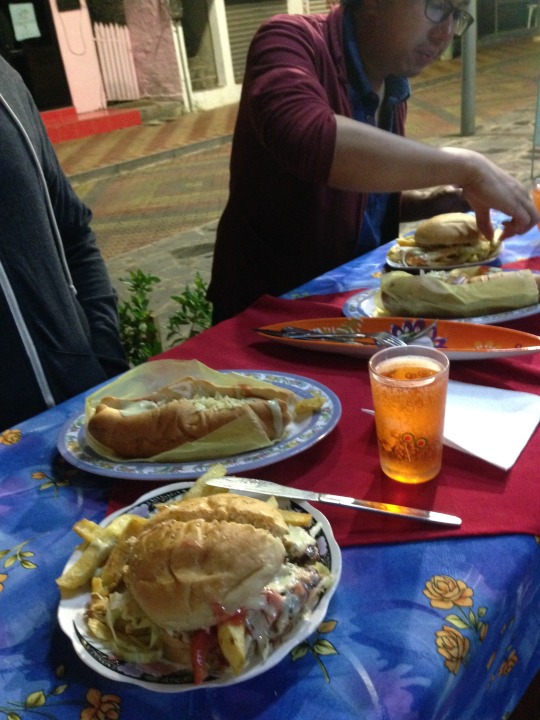
7/28, Thursday: DAY 7: SAN CRISTÓBAL // SANTA CRUZ
The next morning, we had a lazy start as we packed up and got ready to check out of Casa de Laura. For the first time since we arrived, we decided to turn left instead of right to get into the town. Turns out, there was a beach to the left of our hostel all along - literally teeming with sea lions. I was so disappointed in myself for not spending every night sleeping on this beach, when suddenly I was struck with the pungent smell of sea lion poop. Yes, sea lions poop too. Everyone poops. Either way, it was worth it just to see more of these majestic creatures up close in their home.

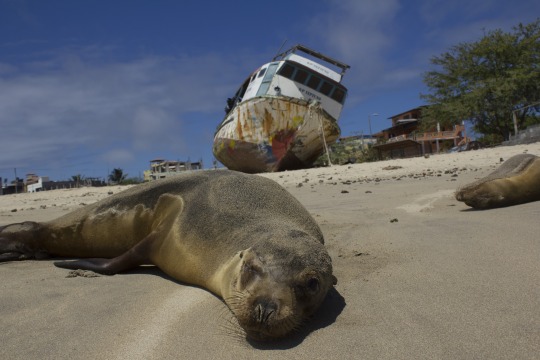
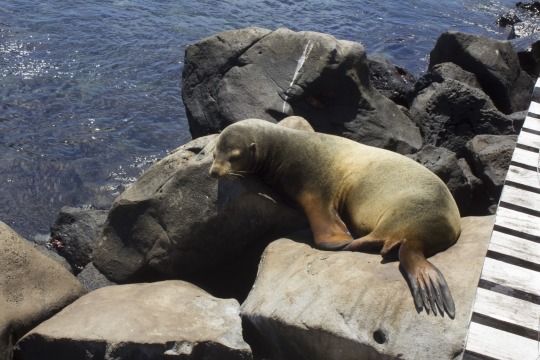
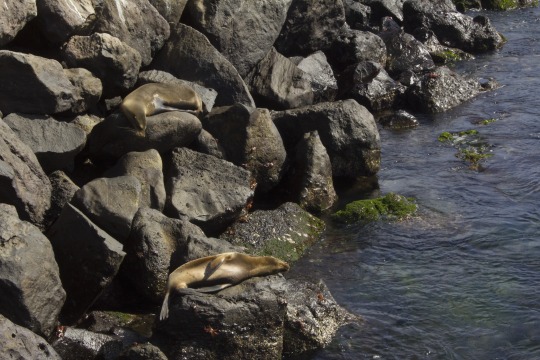
Before heading to the pier for departure, we stopped for a quick snack at Patagonia, where I had my first and definitely not my last bolon experience. Let me tell you a little something about bolon. Bolon is an Ecuadorian dish that is made of fried green plantains that are mashed up and mixed with different ingredients - usually with crumbled white cheese - and then formed into a ball and fried again until it is crispy on the outside and soft and crumbly on the inside. Bolon is a slang term that means large ball, so you could translate the name of this dish as green plantain balls, but I just call them heavenly.
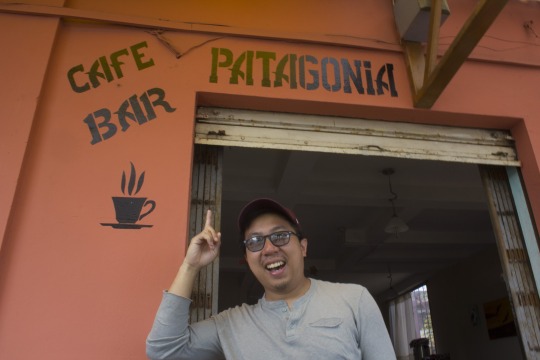
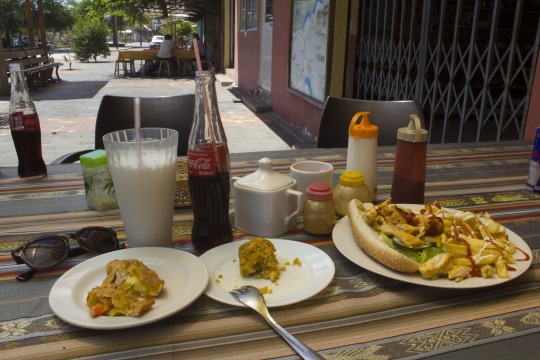
On the way to the pier, I decided to pick up some aloe vera for my unexpected (and painful) sunburn that I must have gotten during our boat tour the day before. Since resources on the islands are limited and there are strict restrictions on incoming cargo to limit the amount of pollution, most tourist items like this, sunblock, and other bath necessities are priced double or triple their original cost. It might seem like a rip-off, but if the price tag was the same as it was in your home country’s grocery store, then tourists would likely start to take advantage of the availability and create more waste and need for cargo traffic in and around the islands. So while $28 was not a pleasant price to pay, I respect the cause and took this as a lesson not to forget to apply sunscreen before falling asleep in the open sun on a boat.
So, I know a lot of people have complaints about how tedious airport security check-in can be, but if you ever plan to travel between islands in the Galápagos, be prepared to have your belongings thoroughly inspected and then tag-locked before you board the inter-island boats. Generally, no food is allowed (bottled water is okay), no plants or flowers, no rocks/shells/coral, and shoes with dirt or mud must be cleaned. This is all in an effort to protect the fragile archipelago and the unique species of each island that could be threatened by outside contaminants or harmful species.
The boat ride from San Cristóbal to Santa Cruz was about 3 hours, and we each paid $30 for our tickets. Despite being slightly over-crowded, the boat was pretty comfortable. I don’t get motion sickness, so I can’t speak on this, but Will did not enjoy the ride whatsoever. The rest of us slept pretty much the entire way, though it seemed like Giss had the best nap of all. When she woke up, she shared her theory that being on a boat is a lot like being inside of a womb - just floating and swaying to the motion of the waves like a little fetus - hence why it feels so comforting!
By the time we woke from our naps, our necks were sore and we were docking into the town of Puerto Ayora, the capital of Santa Cruz located on the southern coast of the island in Academy Bay. Although the island of Santa Cruz (also known as Indefatigable) is the second largest in the Galápagos, it is the most populated, including the town of Puerto Ayora as well as the agricultural villages of Bellavista and Santa Rosa. The island itself is actually a large dormant volcano, which last erupted about a million and a half years ago, leaving behind the remnants of its activity in beautiful visitor sites like Los Gemelos, two large pit craters along the road from Puerto Ayora to Baltra that were caused by the collapse of empty magma chambers.
Santa Cruz is also situated next to Isla Baltra, a small island (also known as South Seymour) where the Seymour Airport is located. The longest paved road in the Galápagos runs north-south across the island of Santa Cruz, which leads from the airport ferry at Itabaca Canal on the north coast through the highlands on its way down to Puerto Ayora.
(source: Wikitravel & Galapagos Conservancy)
Have you ever taken a nap that made you feel more exhausted after you woke up? That’s exactly what happened to all of us, because once we docked, we groggily made our way through the bustling port to the line of white pick-up trucks waiting for the throngs of incoming tourists and decided to part ways to rest before meeting again for dinner.
When we arrived to our hostel, Galapagos Native (~$38/pp per night, for a 3-bed room), we were greeted at the receptionist desk by Joffre, who I had been emailing to coordinate our stay before our trip. Joffre is super friendly and helpful, and is a native resident of the Galapagos (could you have guessed by the name of his hostel?), so he has lots of local knowledge and runs his hostel with amazing conservation practices. The only downside to our room was that the window faced the street, and since the top panels only had a screen and no glass closure, the sound came right through. Other than that, it was clean, roomy, and had plenty of outlets for us to charge all of our phones and cameras. At first, we thought the WiFi was shady but after spending more time on the island, we realized that it was the island itself and not the hostel in particular that received spotty service. After all, we were in the middle of the Pacific Ocean.
That night, we all met for dinner at The Rock, where they were having a cocktail special (2 for $10, I think?). Either way, their drinks and food were delicious. After dinner, we headed over to one of the local bars along the main street of Avenue Darwin, which was surprisingly crowded. This was my first time at Bongo Bar, so I had no idea what to expect when we first walked up the stairs that lead to the rooftop bar, which has beautiful and intimate outdoor seating area, indoor pool table (free!), and both an indoor and outdoor bar. We sat down at a table closest to the bar and immediately were served a tray full of free shots. Of course, this was before I found out that every Thursday at Bongo is ladies’ night, so I just felt all extra special when I took my very first shot of Coco Loco.
After a few drinks at Bongo, we all decided to go downstairs to La Panga, the dance club below Bongo. Now, I have no idea how to dance salsa but Clau and Giss are pros so we all just joined in for fun. As the night got later, it was time to wind down and say goodbye to Inês, who was leaving the next day. It was so sad to see her go, because it felt like we had found such a beautiful travel tribe that lasted only for a perfect few days.
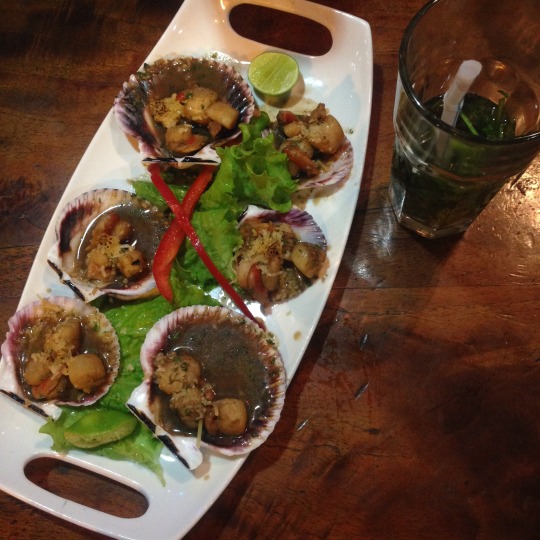
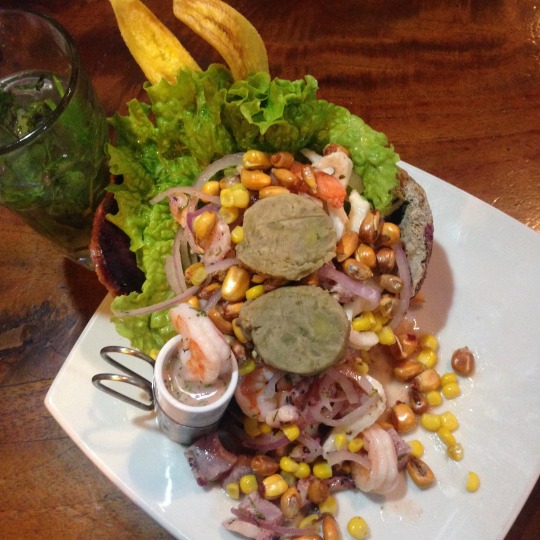
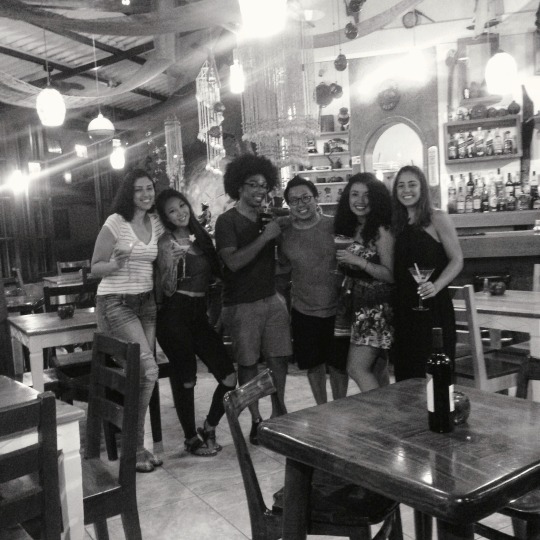
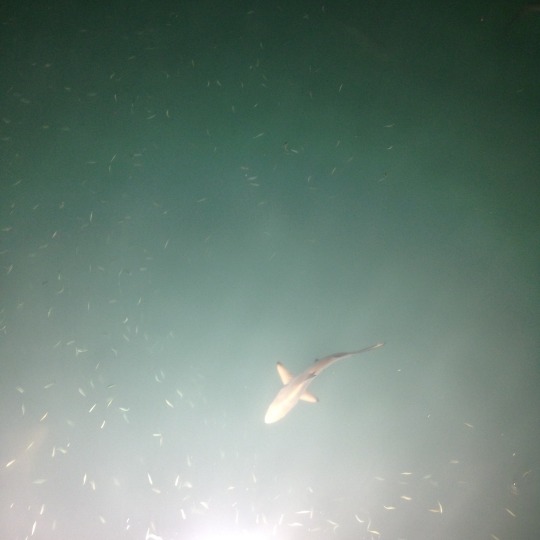
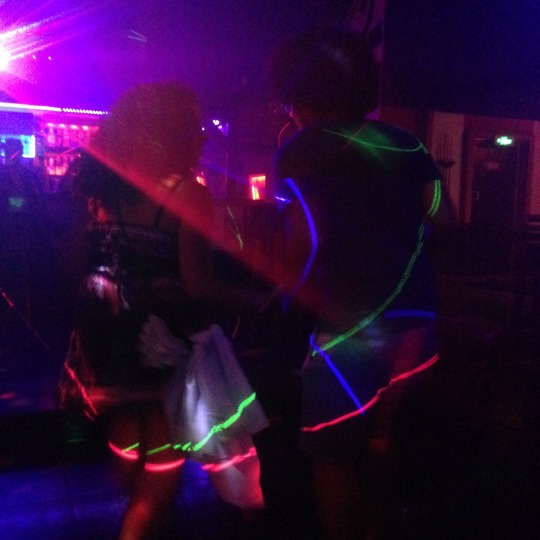
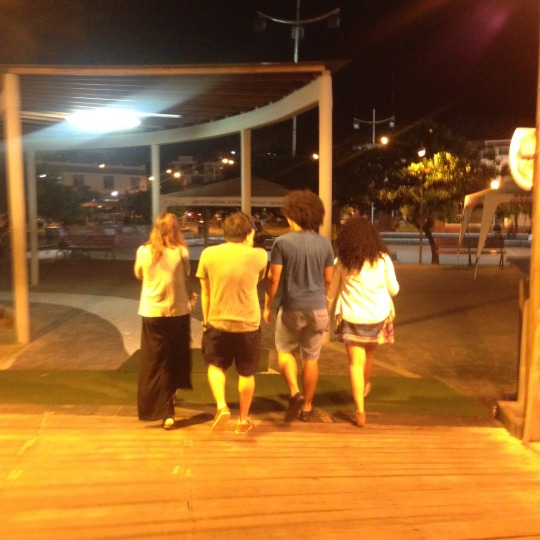
7/29, Friday: DAY 8: SANTA CRUZ
The next morning, Will and I woke up particularly hungry, so decided to walk down the block. Before we could even make it to the corner, the little bodega a few doors down stopped us in our tracks with its enticing scent of freshly baked empanadas. A small group of tourists were clamoring at the cart to place their orders, and we decided to join in. Before we could even sit down at one of the two plastic tables inside, one of the tourists suggested, “try the salsa.. it’s crack.” It was, indeed, crack. We immediately ordered two more empanadas before walking back to the hostel. From that day on, we woke up every morning and headed straight to the Abra K’Dabra empanada cart at MiniMart Merka 7 before starting the day.
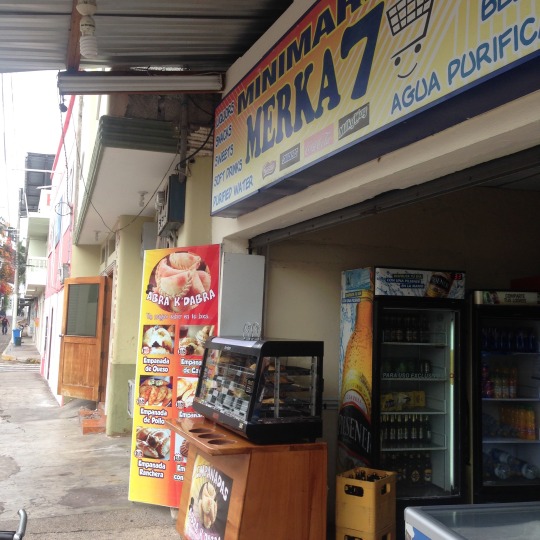
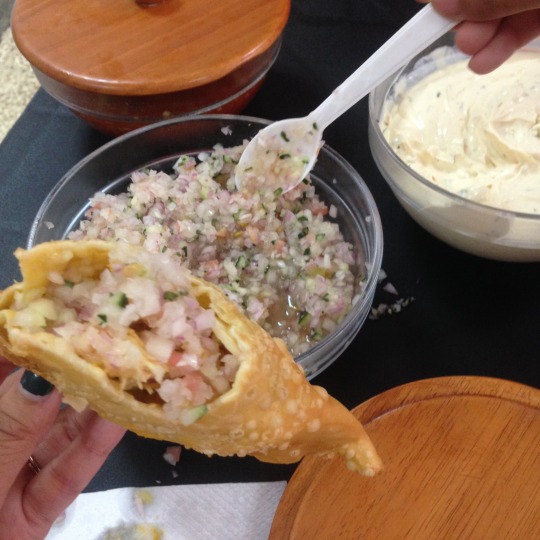
Later that morning, we met up with Clau and Giss at the benches across from The Rock to head out for a day of exploring. Our first stop was to Las Grietas (“The Cracks”), a series of volcanic crevices that were formed during the cooling of molten lava. The porous lava stone of the island allows fresh water to filter down from the highlands into Las Grietas where it mixes with sea water filtering in through the mangroves from the ocean, resulting in a crystalline and refreshing natural swimming pool. To get to this magical sanctuary, we took a panga (water taxi) for about $1 from Puerto Ayora to the otro lado (the “other side”) of the main pier. Once we docked, we followed the signs for the Finch Bay hotel, where the path connects to a short boardwalk along a small beach called Playa de las Alemanes, which leads to another pathway to the beautiful pink salt flats that welcomes visitors onto a cacti-lined trail towards the reward of Las Grietas’ cool waters.
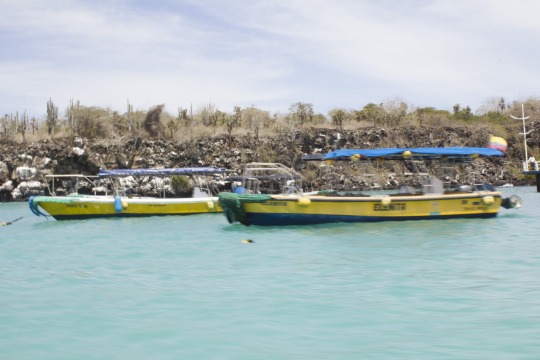
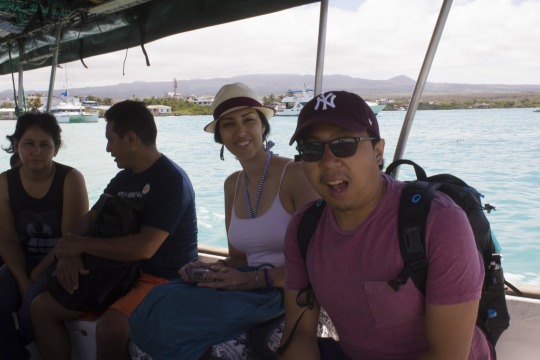
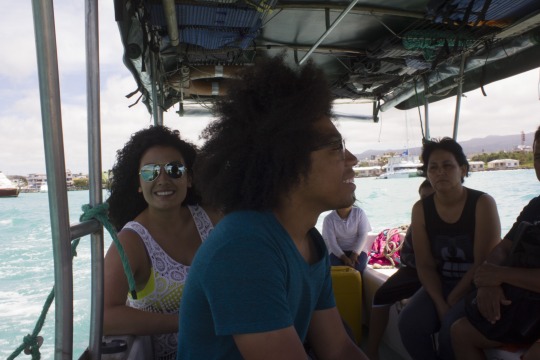
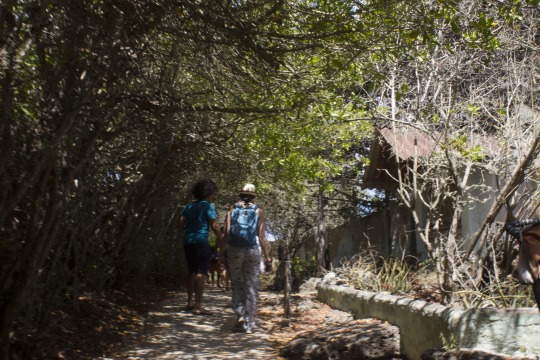
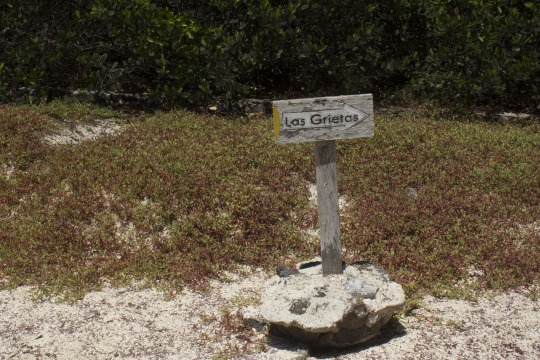
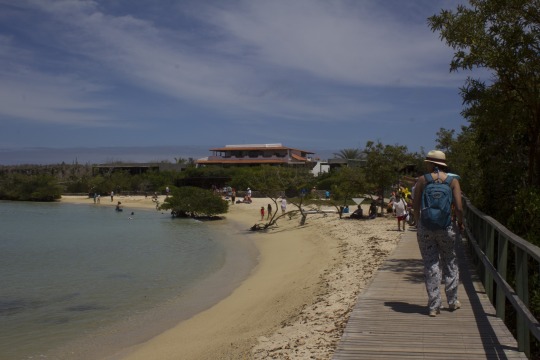
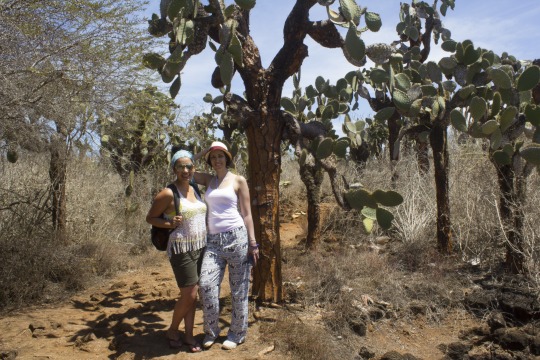
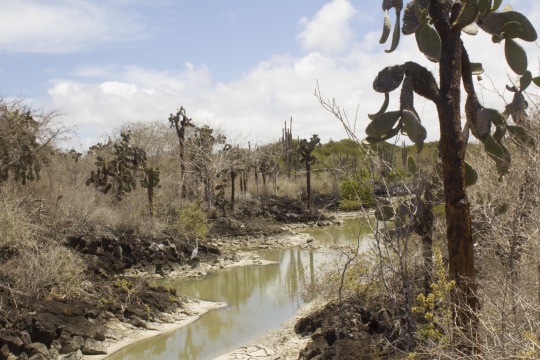
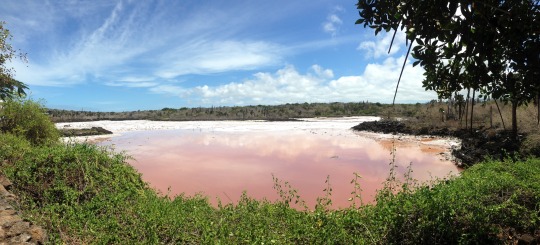
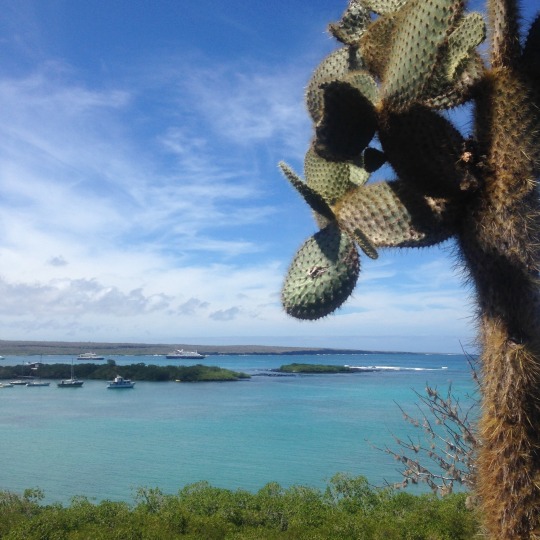
When we arrived, the staircases were already bustling with tourists and locals alike, the wooden coat racks spilling over with clothes onto the hot lava stones surrounding the platform that divers were bravely launching themselves off of into chilly cerulean water. I hesitated to jump in, but the hike leading up had warmed me enough that the cold waters were a welcome refresher, so as soon as the rush of water embraced me, I felt at home again, floating with a perfect view of the sky framed by the towering walls of the crevice.
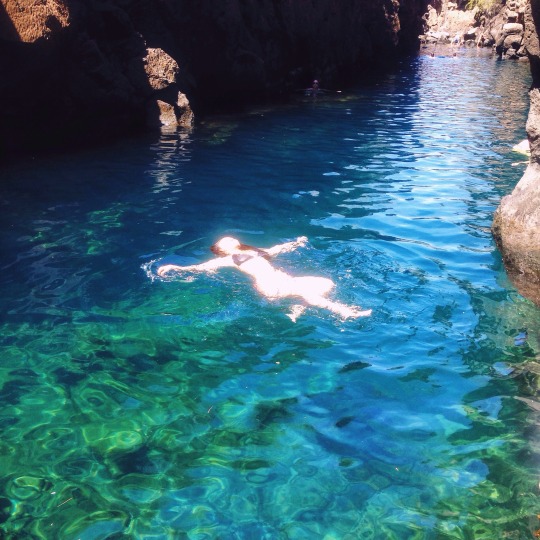
By the time we hiked back down through the cacti trails, past the vast pink salted waters, and back to the panga pier, we were all exhausted and hungry, so once we docked at the port we headed down Avenida Darwin for food. After a short stroll through some of the smaller streets off the main avenue, we came across the Galapagos Deli, where we stopped for freshly made personal pizzas and ice cream. Since there were some flavors I never tried before, I decided to with the guanabana, and mixed it with some fruta (strawberry) for a delicious combination.
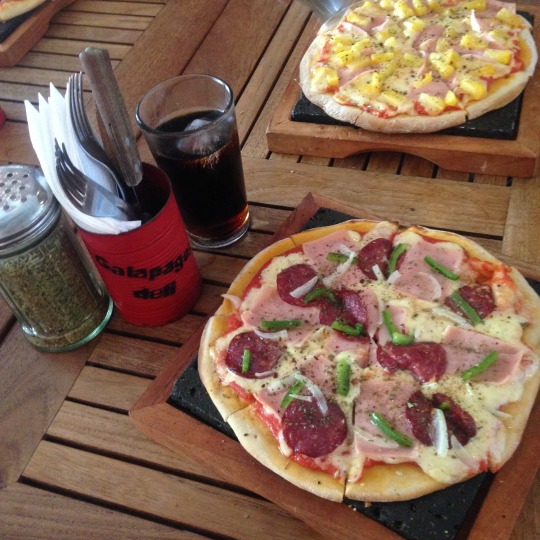
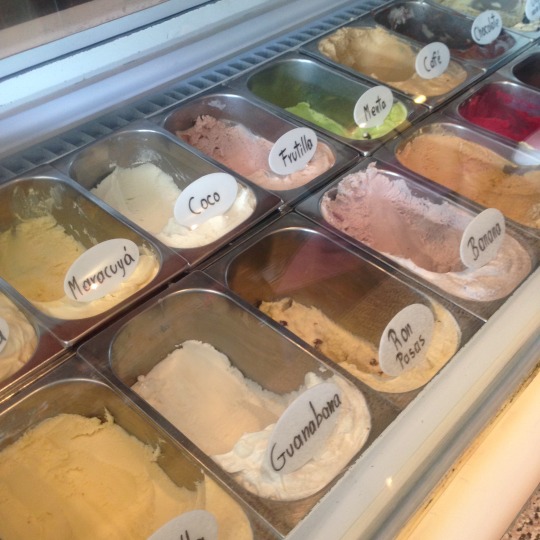
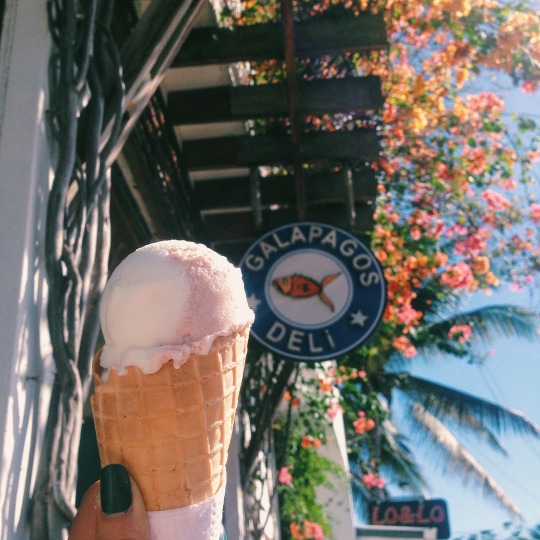
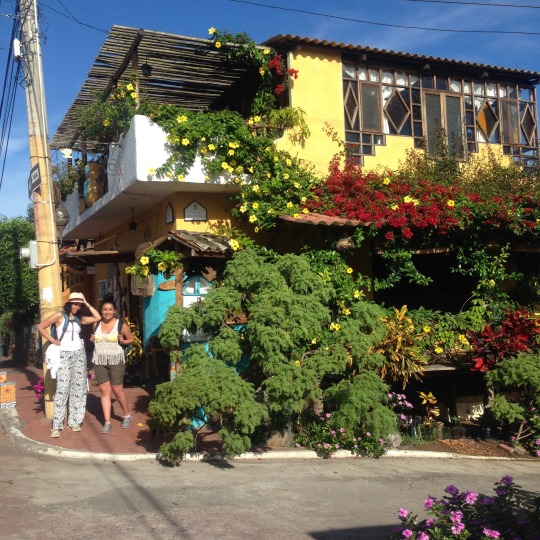
Now that we were full, we walked over to Laguna de las Ninfas (“Lagoon of the Nymphs”), a peaceful lagoon with plenty of shade and a great little dock for napping. By the time I woke up, I realized I had been drooling through a crack in the dock I was laying on - literally, drooling. I haven’t drooled in my sleep since I was a kid, so if that isn’t a testament to how good of a nap it was, I don’t know what is.
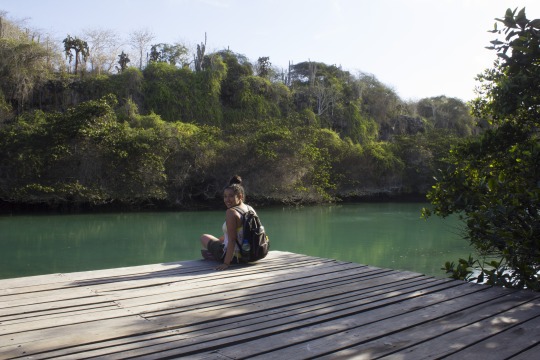
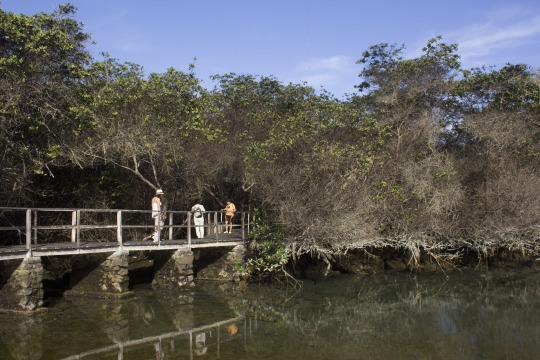
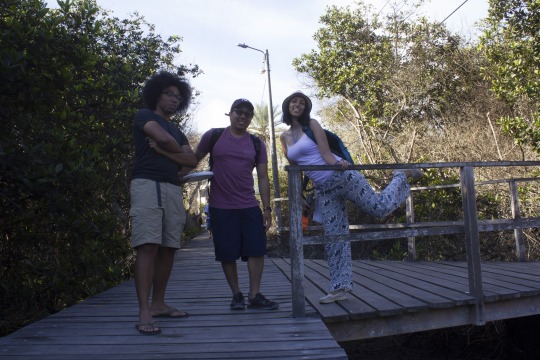
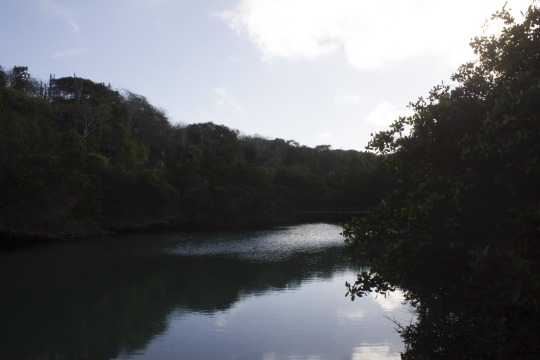
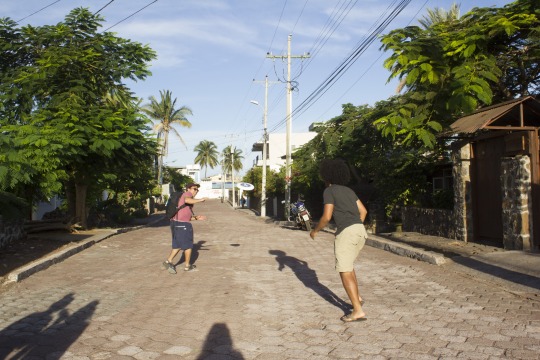
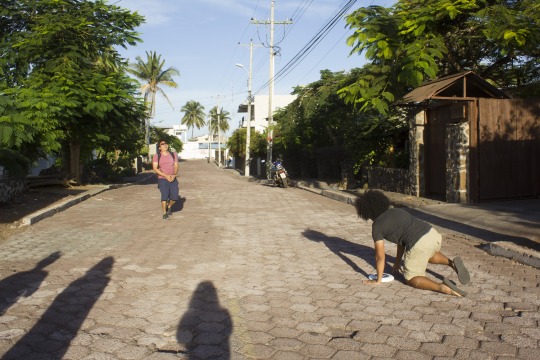
Since it was still early in the afternoon, we decided to take a walk through Puerto Ayora towards Baltra, with the goal of reaching a high vista to watch the sunset. The walk was a long climb uphill, and we never did make it to a vista, but we did witness the beautiful palette of pink hues dancing across the horizon while we explored the terrain.
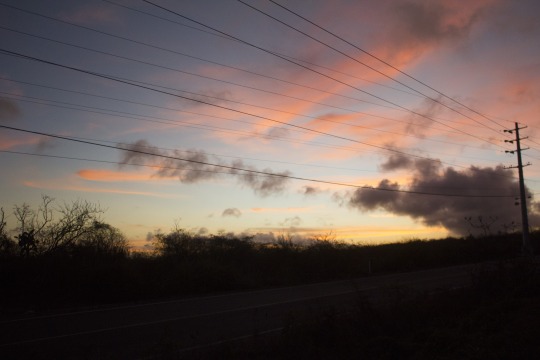
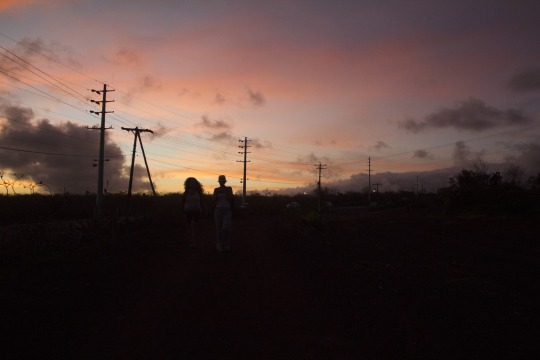
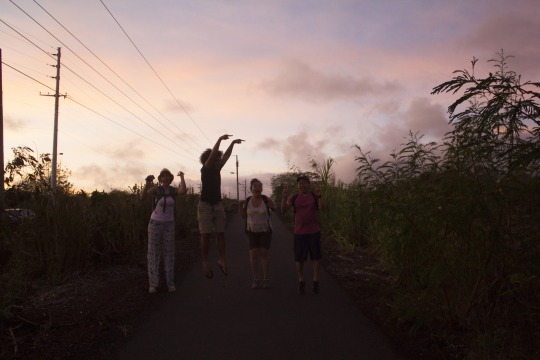
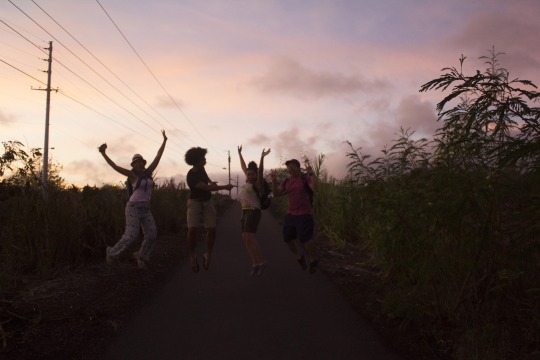
Later that night, we met up with Claudia at Los Kioscos (“The Kiosks”) for some fresh seafood. At the corner of Avenida Baltra and Charles Binford, you’ll find a street lined with local restaurants, framing the cobbled road filled with plastic tables and chairs crowded with tourists and locals picking out their dinner to be cooked right on the grill in front of them. For most dishes, you can choose how you want your dinner cooked - a la parilla (roasted over charcoal grill), al ajillo (pan fried with garlic), frito (deep fried), a la diabla (with spicy red creole sauce), or encocado (in a rich coconut sauce). I opted for shrimp that night, which came with a side of rice, cole slaw, and papas fritas.
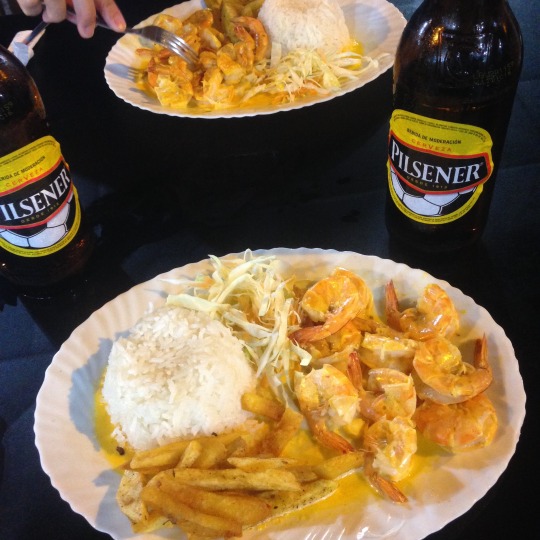
7/30, Saturday: DAY 9: SANTA CRUZ
On Saturday morning, we woke up early to head to Tortuga Bay, the gem of Santa Cruz on the southern coast, famous for its expansive and pristine shoreline that gradually descends into the sparkling Pacific Ocean. Visitors have to sign in before trekking on the 1.55 mile path surrounded by cacti, palo santo trees, and matasarno trees that leads to the beach. In the sun, the journey feels exhausting, but once we arrived, the view was breathtaking - a picturesque soft white sand beach that greeted us with gentle breezes.
Since this beach tends to have strong currents, we walked another twenty minutes towards a smaller beach adjacent to lagoons, where the waters are much more calm and ideal for snorkeling or kayaking. On the way there, we passed dozens of black marine iguanas hanging out under the shade of the mangroves. Claudia and I decided to snorkel and sunbathe for a bit while X and Will rented a kayak from a guy with an eight-pack. Unfortunately, Giss had homework that morning so she arrived a bit later and only got to enjoy the shade where plenty of little Galápagos finches were delicately hopping around in search for crumbs around visitors.
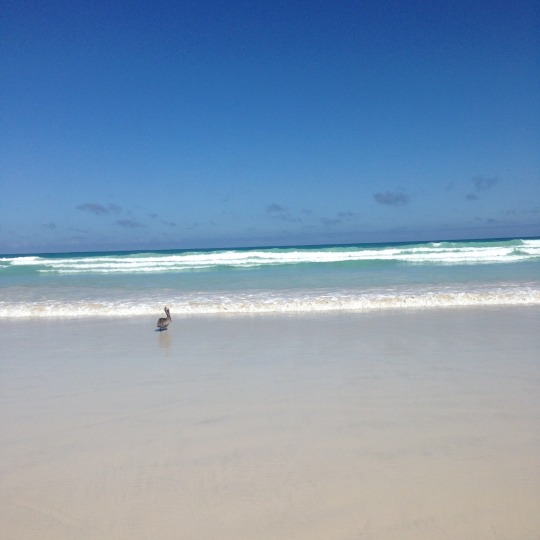
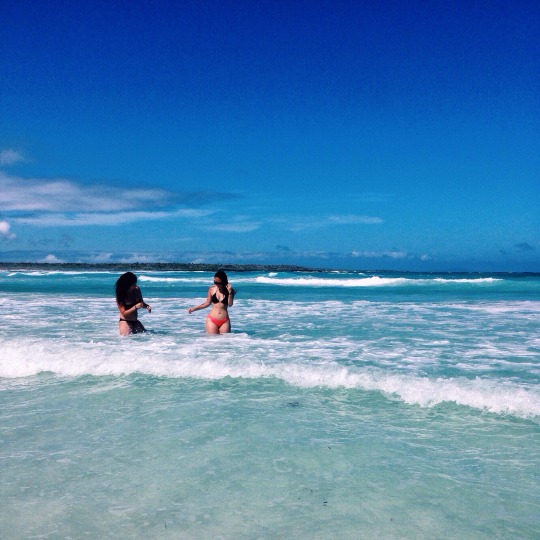
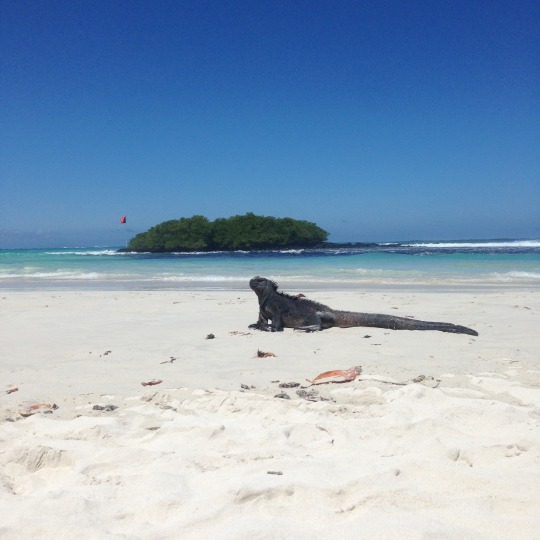
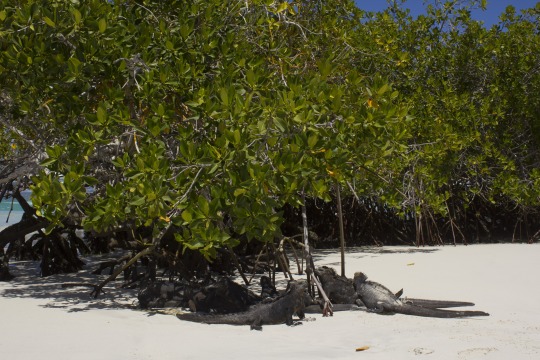
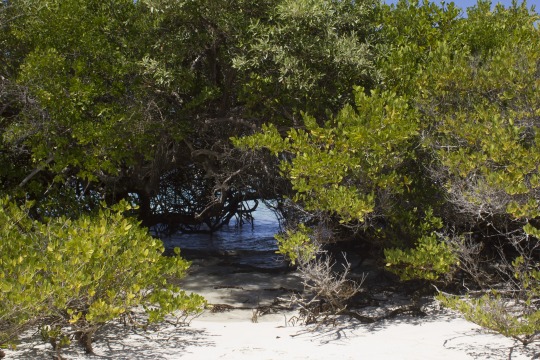
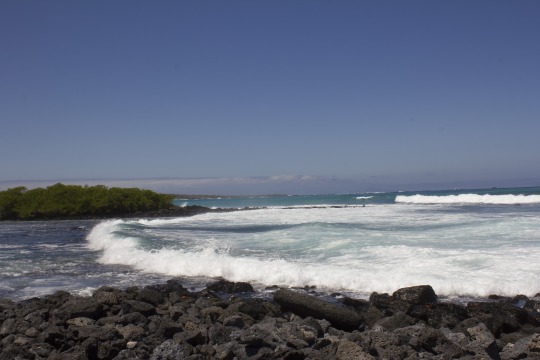
Even though we could have spent the entire day basking in the sun right there in paradise, we had one more visitor site in mind for the day, since Clau and Giss would be leaving for Isabela the next morning and only returning to Santa Cruz for one last night on my birthday that coming Monday. We headed back through the flawless horizon of Tortuga Bay and down the cobbled path between the cacti into town again.
Once we got to town, we hailed a pick-up taxi to negotiate a price to visit El Chato. The El Chato Tortoise Reserve is privately owned land, and located just south of Santa Rosa in the highlands. Apparently, admission is $3 but I honestly don’t remember paying, although we were greeted by the owners of the café on the reserve, who offered us complimentary cups of coffee and tea after we had hiked the grounds. I’m not sure if it was because we arrived late in the afternoon and that the reserve is only open to visitors from 8am to 5pm, but it felt like we had the whole place to ourselves.
We only had about an hour there, roaming the open spaces coming face to face with these majestic prehistoric creatures. The Galápagos tortoise is the largest living species of tortoise, and native to seven of of the islands, with a life expectancy of over 100 years. Within the archipelago, at least 14 species of Galápagos tortoises have been identified, although only 11 survive to this day, living on 10 of the largest islands. Several of the surviving species are seriously endangered. One of the species, C. abingdonii from Pinta Island, is considered extinct. The last known specimen, named Lonesome George, died in Isla Santa Cruz on June 24, 2012. George had been mated with female tortoises of several other species, but none of the eggs from these pairings hatched. Charles Darwin’s observations of the differences in characteristics of Galápagos tortoises in 1835 contributed to the development of his theory of evolution.
(source: Wikipedia & Galapagos Conservancy)
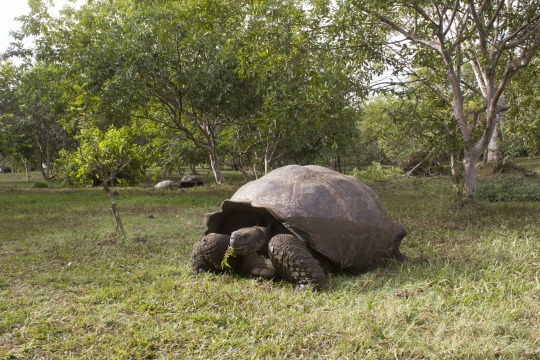
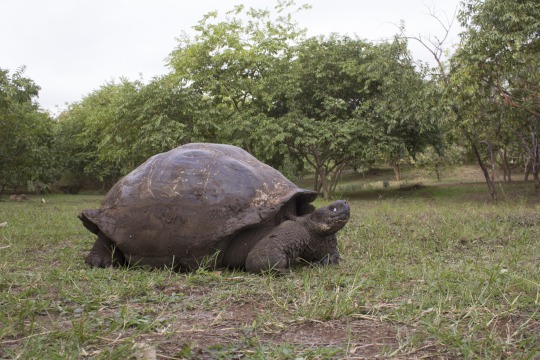
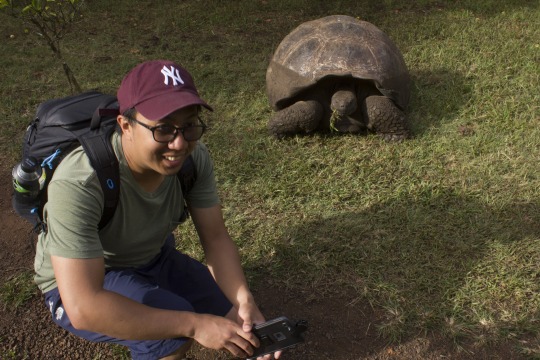
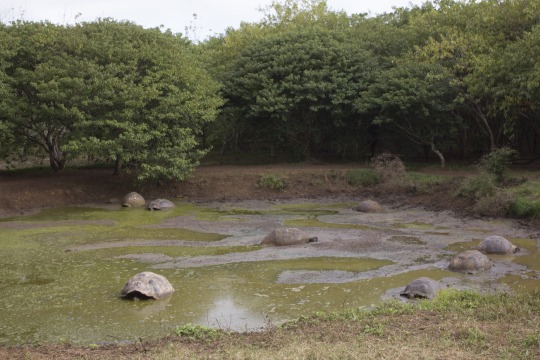
As we walked around, we noticed that some of the tortoises were munching on the abundant fruits scattered under trees, so we picked them up and instantly recognized their fragrant smell. Guayaba, or guava, grows all around El Chato and leaves their delicious little fruits for tortoises (or in our case, visitors) to eat. All it took was a little brushing dirt off, and there we had an instant snack!
If you’re reading this, you probably know me well enough to know that Jurassic Park is my favorite movie. Of. All. Time. Because of this, I’ve always kept a special place in my heart for dinosaurs, so coming this close to the unique endangered species of dinosaur-like animals was a lot like that scene where Lex and Tim are sitting in a tree with Alan admiring the brachiasaurus grazing from the trees around them.
It’s important to note that while we were able to enjoy the fruits of the earth (get it? lol), there are certain fruits in the Galápagos that should be avoided at all costs. Manzanitas (little apples) grow from the endemic Manzanillo tree, also known as the Poison Apple Tree due to their highly toxic fruit and leaves. In fact, even just skin contact with the milky white sap that the leaves contain can cause blistering and burning on the skin. Eating the fruit can be fatal too, although only the Galápagos tortoises are able to digest these poisonous apples. It’s a good thing we didn’t mistake manzanitas for guayaba!
(source: Red Mangrove)
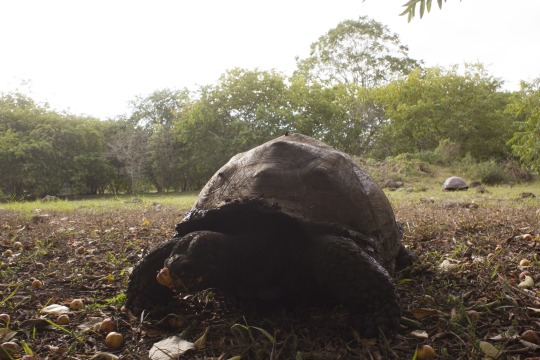
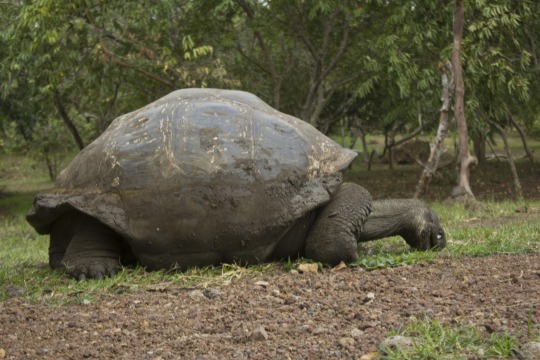
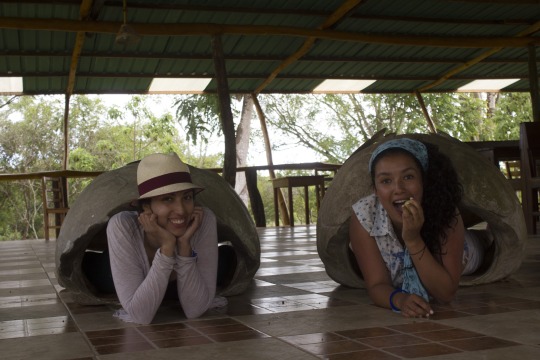
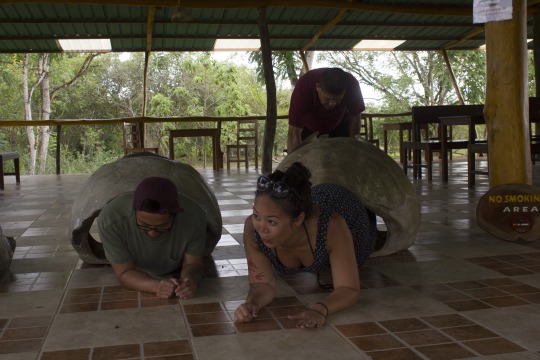
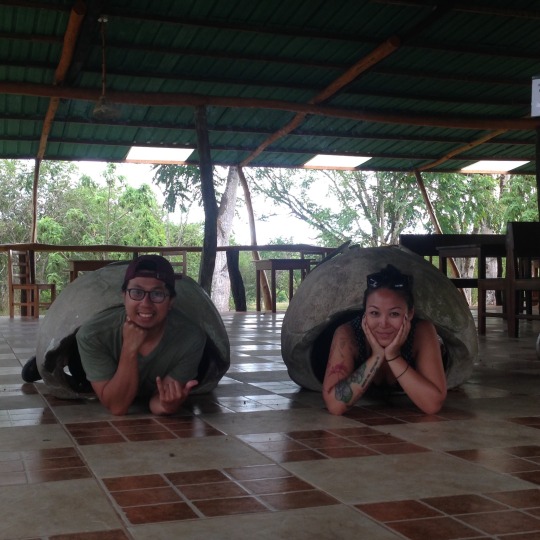
As the sun began to set, we realized we only had enough time to quickly explore some of the underground lava tubes that span throughout the volcanic belly of the island. At El Chato, there are several entrances to these tunnels that formed when surface lava cooled and solidified, while the underground molten hot lava continued to flow, eventually leaving an emptied cave.
(source: Galapagos Conservancy)
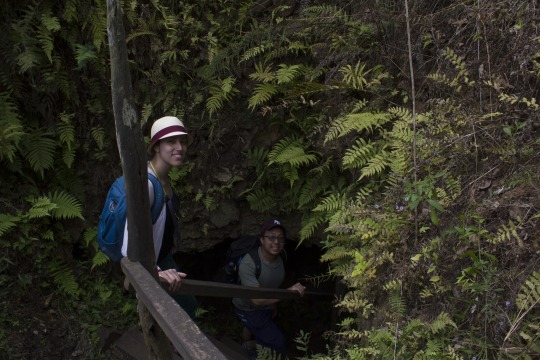
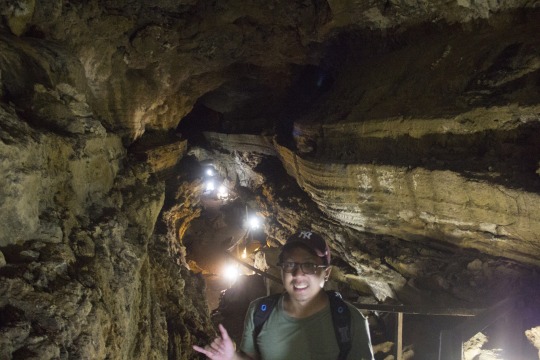
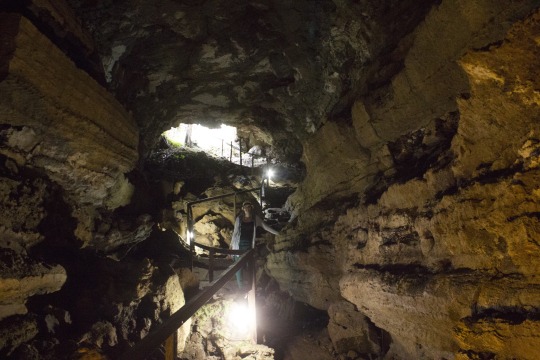
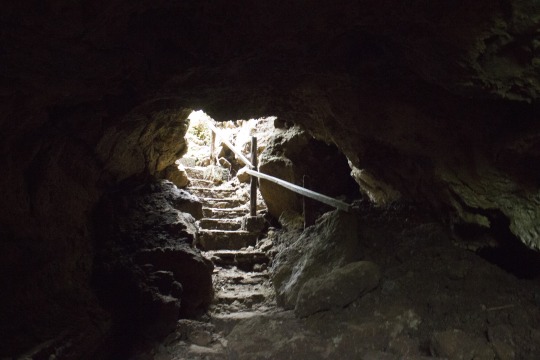
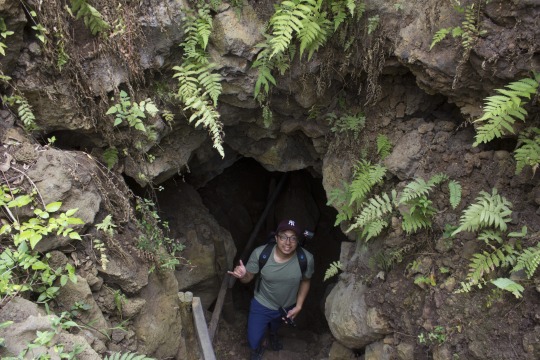
Since we were the last visitors on the property, the hosts at the café generously offered us as much coffee and tea as we wanted as we posed with real tortoise shells and collected as many guayaba as we could hold. On the way back, our taxi driver suggested that we stop in Santa Rosa for a road-side snack. At first my eyes darted to the empanadas that were huge and crispy, but the real prize were the potato balls that Will still dreams of to this day.

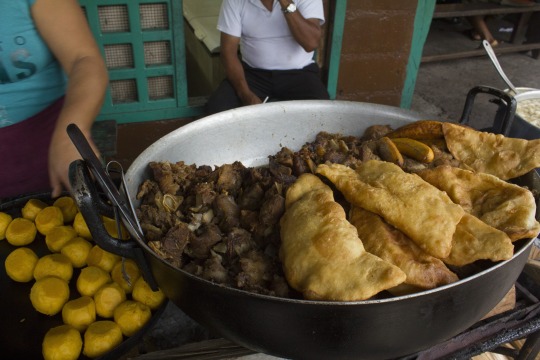
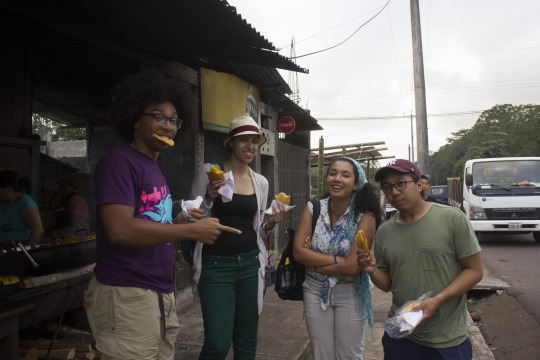
When we made it back into town, we headed to the Kiosks again so Giselle could experience the divine fresh seafood we tried the night before. This time, I opted for the whole brujo (mottled scorpionfish) fish wrapped in foil and grilled right over a charcoal grill in front of our table. As a kid, my favorite part of the fish was always the eyeball, so I had no shame stripping this delicious masterpiece to its bare bones. I just wish I remembered to take an “after” picture for dad, the king of eating whole fishes and cleaning bones.
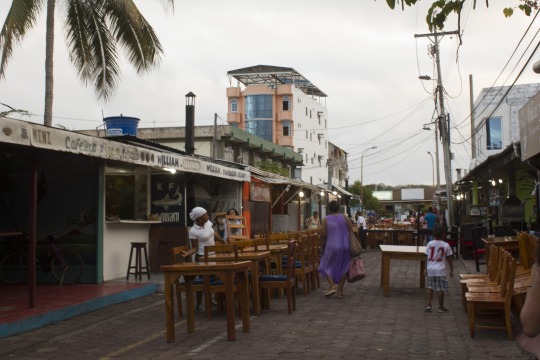

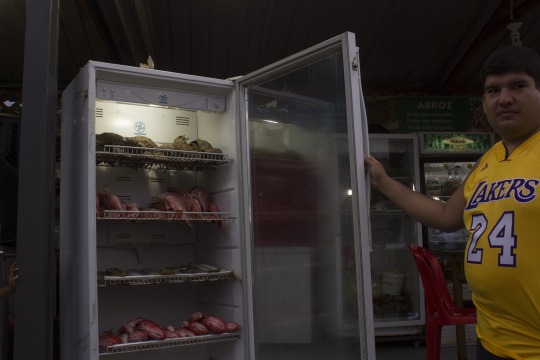
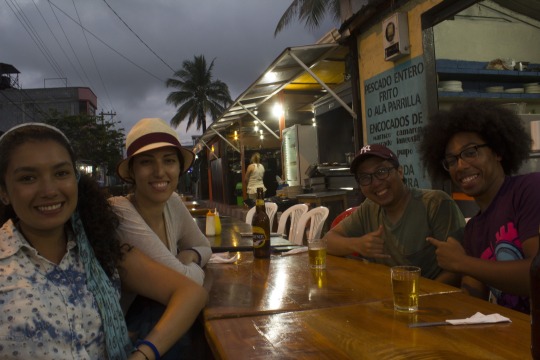
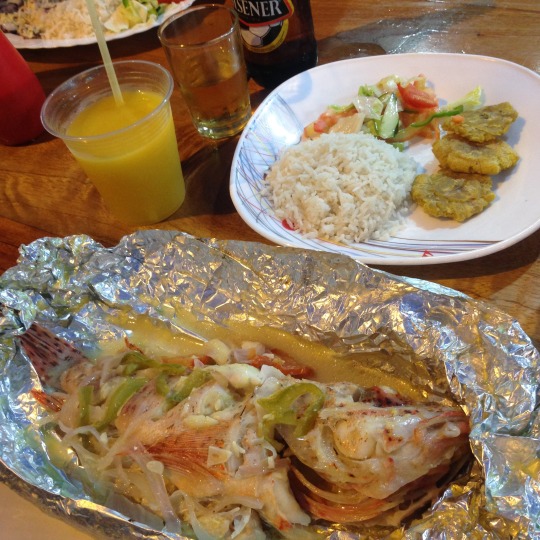
After we ate, we parted ways to get ready for what we expected to be our last night out together, since Clau and Giss would be leaving for Isla Isabela the next morning, and they weren’t sure how much time they would have upon their return to Santa Cruz before heading back to the mainland. Giss ended up having a lot of homework to get done, so Clau joined me, Will, and X at Bongo to share some drinks and celebrate the beautiful bond of friendship that bloomed from our time together. It had only been a few days, but in less than a week, I felt like Claudia knew me at my core, and that in some past life, we had been sisters bound by the light of our souls. There is really nothing more amazing than the realization of how many incredible, loving beings there are roaming this earth waiting to meet you, and who are meant to change you on your journey through this life. Seven months after this trip, Clau and I still keep in touch almost every day and share our magic moments with each other, because I know that she truly understands me.
When we got there, it was so crowded that we had to hunt for a table to free up in the corner of the terrace before we could sit. Once we did, we took turns going to the bar since we didn’t want to give up our spot, but since my birthday was two days away, Will and X kept buying my drinks for me. We were content with just sipping on our drinks and people watching until Clau leaned in to ask, “So, are there any boys here you think are cute?” to which I shook my head at once I scanned the terrace again. Clau wasn’t convinced, “Really?! But it’s your birthday, we should dance! Are you sure?” Doubtfully, I looked around again, but no one caught my eye except for the bartender, who was so busy I never even saw him look up once, so I told Clau, “Well, the bartender.. but he’s the bartender.” I kept glancing at him, glowing under the bright overhead lights behind the bar, an angelic contrast to the dark and humid air hovering over the crowd, but his eyes stayed low, focused on the swift movements of his hands, pouring, mixing, pouring, mixing. Regardless, a lack of cute boys to dance with was not going to stop me from dancing.. especially not when I had my friend Jack Daniels to keep me company.
By the end of the night, I had taken back an unknown number of Jack & Cokes, and an even more mysterious number of Jack on the Rocks. Clau claims that I was speaking Spanish to her flawlessly, and X claims that I was demanding pizza [in Spanish], but somehow they managed to tuck me into bed that night.
7/31, Sunday: DAY 10: SANTA CRUZ
The next morning, we all woke up far too late. After grabbing a quick empanada to start us off, we headed through the small streets in search of a good place to sit down for breakfast and ended up at a lovely little place called Lo & Lo, which was right next to the Galapagos Deli. Still reeking of whiskey and too ashamed to take my sunglasses off just yet, I struggled to figure out what to order while X and Will revelled in making fun of me from the night before. Apparently, after I demanded pizza, X had set out on foot in search of late night snacks, and had been stopped in the street by a man looking for me. Immediately, I pictured the bartender from the night before and secretly hoped it would be him when I asked, “What did he look like?” but when X started describing him, I knew it wasn’t him. Disappointed, I broke into my bolon reluctantly, unable to enjoy its perfection. Suddenly, X exclaimed, “Wait, that’s him!” as a tall, tan, handsome man took a seat at a table with friends. But it wasn’t him. I needed a nap.
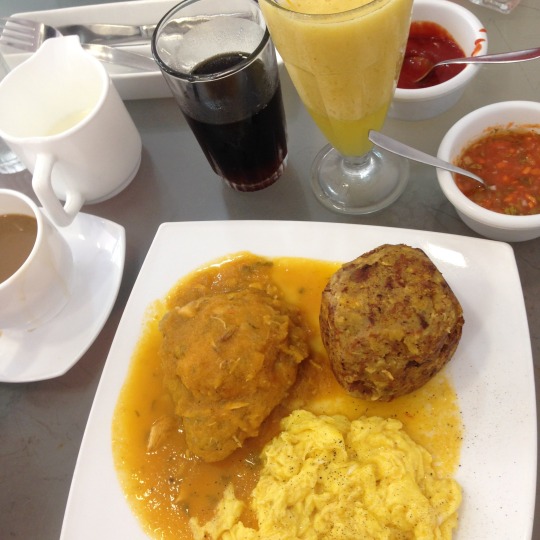
After we ate, we headed back to Galapagos Native to pack and check out before heading to Galapagos Dreams to check in. You may be wondering why, silly Jasmine, would you book two separate hostels within a few blocks’ walking distance of each other? Loyalty, that’s why. I had booked our second location first, knowing that I’d want to go on a tour in search for fur seals. The Galapagos Dreams hostel offered a room and tour package, so we booked this early in the year. Later, when we planned our itinerary and realized we’d be staying in Santa Cruz for longer, we decided that if one of the two hostels turned out to be less than accommodating, at least we would only be staying for a few days at either. Weird logic? Kind of, but the more experiences, the better, right? Change is good! Don’t judge me. Anyway, we had to switch hostels.
Once we settled into Galapagos Dreams (~$30/pp per night for a 3-bed room), which offered a bit more privacy since it’s on a quiet road, we just spent that Sunday afternoon relaxing. Later that day, Will and X were craving pasta, so we headed out for dinner at Café Hernán and some snack & souvenir shopping before calling it a night. Usually, I’m awake when midnight strikes and it’s officially my birthday, but this time, I was knocked out with an open bag of Dorito’s by 10pm.
8/1, Monday: DAY 11: SANTA CRUZ
My 25th birthday started off low-key, with ice cream for breakfast (of course) at il Giardino, one of the cafés on Ave Darwin. After that, X wasn’t feeling very well, so Will and I decided to rent bicycles. In case you don’t know, I never learned how to ride a bike. In fact, both of my brothers and I were never taught, although Jordon has recently learned (yay!). Will took this big brother duty seriously, and decided he wasn’t going to let his lil sis get left out of activities anymore. Unfortunately, after about an hour of learning how to balance in motion, I crashed right into a curb and broke the chain off the rental bike :(
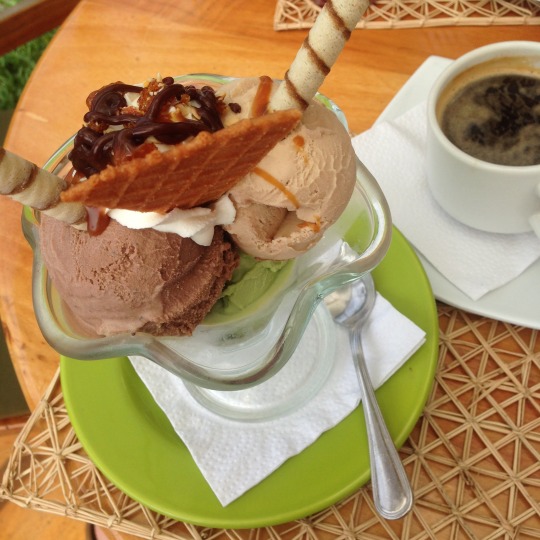
We spent the rest of the day relaxing while X recovered, until dinner when Clau and Giss surprisingly arrived back to Santa Cruz early and were able to meet with us! I was so happy to see them again, and this time they had brought friends! Clau and Giss met Ivan, a Filipino Australian who was traveling solo while visiting Isla Isabela, and then ran into Giss’ cousin with her friend upon returning to Santa Cruz. Suddenly, our little trio turned into a party of eight! Once we all met, we walked around Ave Darwin drinking beers for a bit to decide where to eat. Eventually, we ended up at La Garrapata, the al fresco restaurant right below Bongo, next to La Panga. Ironically, the tall handsome man who had asked X about me was our waiter that night.
I can’t tell you how lucky I felt that night, surrounded by old and new friends, as if the universe was reminding me that the world is full of loving people just waiting to be met. And just as I was relishing in the sweet company surrounding me, the bartender from Bongo came hopping down the stairs, straight to the bar of La Garrapata to pick up a plate of food before disappearing upstairs again. I don’t think anyone else caught me in that moment of delightful surprise other than Clau.
I’m not sure who told the waiter it was my birthday, but after I devoured my delicious ceviche dinner, I was surprised with a slice of chocolate cake and candles. Giss and Clau even got me a present so that I had something to unwrap - and it was the most perfect gift - a stuffed animal sea lion that doubled as a backpack.
After dinner, we decided the only proper way to end the night would be to return to our beloved Bongo. By the time we got upstairs, I was so nervous that I couldn’t even bring myself to the bar to order drinks, let alone look the bartender in the eyes. Instead, I played it off as being tipsy and stole glances of him every now and then. Somehow, news had spread from La Garrapata to Bongo that it was my birthday, as one of the servers brought over a flaming shot for me. Soon, we were taking group shots and I was d-r-u-n-k. We were pretty much the only patrons at the bar since it was a Monday night, but that didn’t stop us from having a great time. I think everyone started to catch on to my crush, because as we were dancing inside, Giss nudged me and nodded behind me as a signal to turn around. Of course, who else would be standing there watching us dance but the dreamy bartender. Still nervous, I quickly turned back around without so much as eye contact.
By the time we were ready to leave, literally every person in our party had offered some kind of encouragement to talk to the bartender. My secret crush was now public news. Too drunk to compose myself, too nervous to strategize a plan, I decided to just walk away. But just as we were descending the stairs, Ivan asked us to wait for him. “Be right back!” he said, and I thought nothing of it, assuming he was running to the bathroom before the walk back to our hostels. A minute later, he returned. With the bartender.
Suddenly, I was face to face with this stranger, but somehow when I looked into his eyes, I felt like I had known him for lifetimes before. “It’s her birthday, and she thinks you’re cute,” someone said - I don’t know who, everything around me was now a blur - “Really? Thank you,” he said with a sweet smile before he asked my name. “Jasmine,” I whispered, as he took my hand, kissed it, and said, “Raúl.” My heart was beating out of my chest.
Pretty soon, we realized that we could hardly speak each other’s languages as we scrambled to find a way to stay in touch. I tried to explain that I was traveling with a phone that didn’t have service on it, so I couldn’t do much. He took his phone out, and I nervously chose Facebook, typing my name in. Never in my life have I ever been more frustrated at how many other Jasmine Chows exist on this planet. Once he realized I was having a hard time finding myself, he just pulled up his phone pad and asked me to put my number in. Foolishly, I did this, and left with a kiss on the cheek… only to realize a block down the road that there would be no way for him to contact me with that number until I returned back to the US. Jasmine, you idiot.
8/2, Tuesday: DAY 12: SANTA CRUZ
A few hours later, we were waking up at the crack of dawn for our last tour in the Galápagos, and my final chance to spot the elusive Galápagos fur seal. Ever since we began planning this trip, I had been on a mission to find the fur seals. I had even coined a jingle called Fur Seal Island with a catchy tune that I caught Will humming along to once. In fact, when we booked this particular tour to Isla Bartolomé with Galapagos Dreams Tours ($175/pp), I had specifically asked if there was a chance we would see fur seals.
I suppose you could say that Pacific Tours in San Cristobal had spoiled us, because we certainly weren’t expecting the large group that joined us on this tour. At exactly 6:00am sharp, a mid-sized bus pulled up in front of our hostel to pick us up, as Jonathan (who owns Galapagos Dreams), handed us our snorkeling gear to take aboard. Not much was explained to us about the tour beforehand, so we were completely unaware that we’d be spending our day with the same people on the crowded bus, which we were last to board onto.
When the bus arrived to the port at Baltra an hour later, we groggily made our way out to join our group at the dock. Soon, we realized that the tour was catered for Spanish-speakers, and we were the only ones who needed the tour guide to translate to English for us. Somehow, I felt like our version was trimmed down a bit, and lacked the jokes and anecdotes that we enjoyed as a group on our San Cristobal tour. Regardless, it was a beautiful sunny day, and I was ready to enjoy the spectacular views from Bartolomé. Will and X, on the other hand, were still exhausted from celebrating the night before and both slept through the entire boat ride.
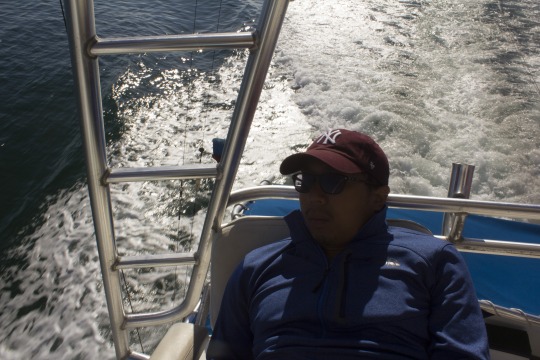

Isla Bartolomé is a volcanic islet just off the east coast Isla Santiago. Although is one of the “younger” islands in the Galápagos archipelago, it is the most visited and photographed of all the islands. With a total land area of just 1.2 square kilometres (0.5 square miles), this island offers some of the most beautiful landscapes in the archipelago, consisting of an extinct volcano and a variety of red, orange, green, and glistening black volcanic formations. Bartolomé is famous for its Pinnacle Rock, a volcanic cone, that was formed when magma was expelled from an underwater volcano; the sea cooled the hot lava, which then exploded, only to come together and form this huge rock made up of many thin layers of basalt. When we arrived, we docked at a small bay opposite Pinnacle Rock and began to climb the 600 meter trail to the 114 meter summit to enjoy views of Pinnacle Rock, the immense black lava flows at Sullivan Bay and the rest of Santiago Island, and Daphne Major and Minor.
(source: Wikipedia & Galapagos Conservancy)
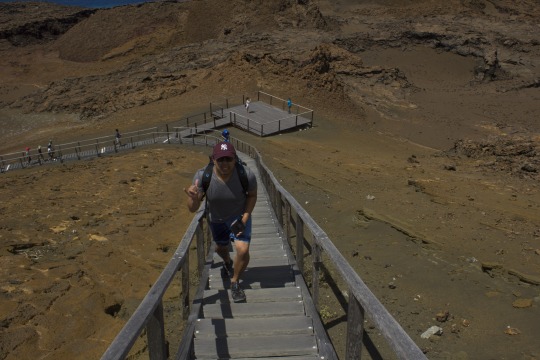
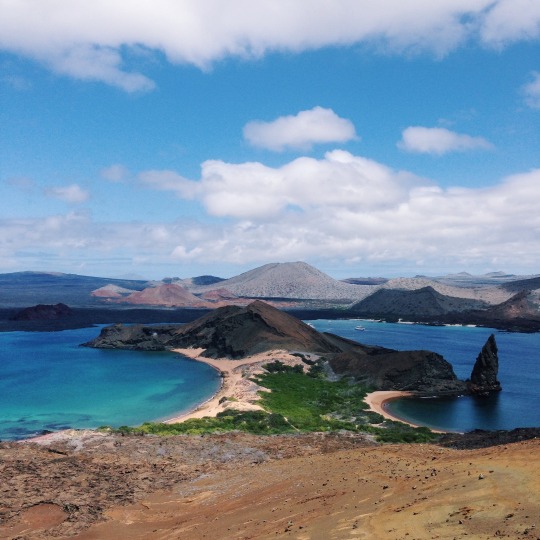
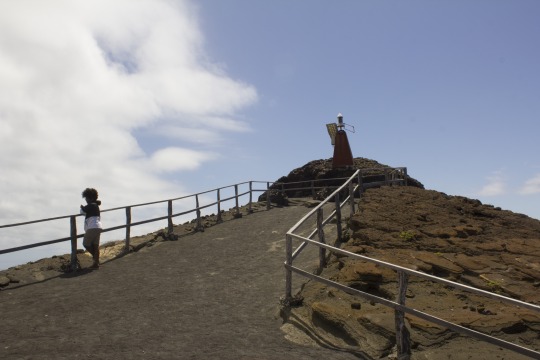
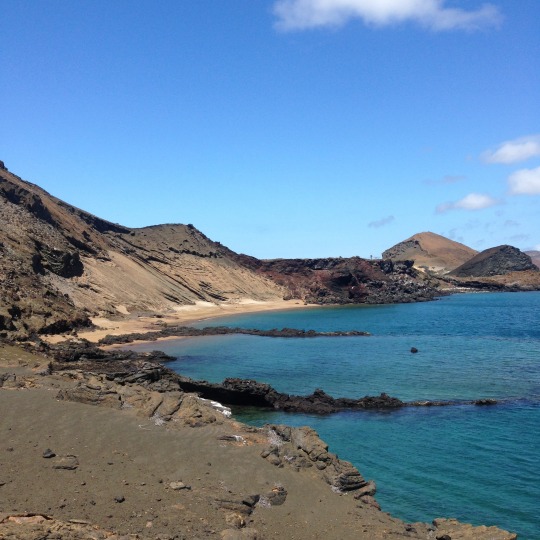
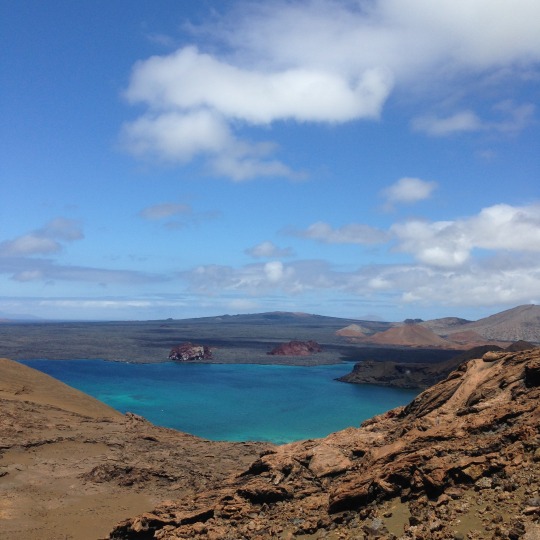
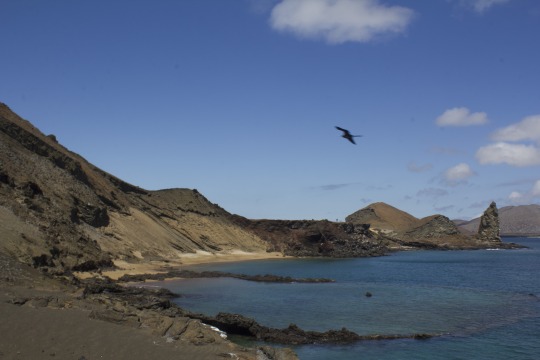
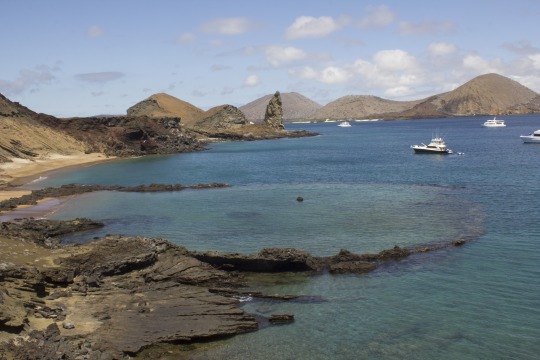
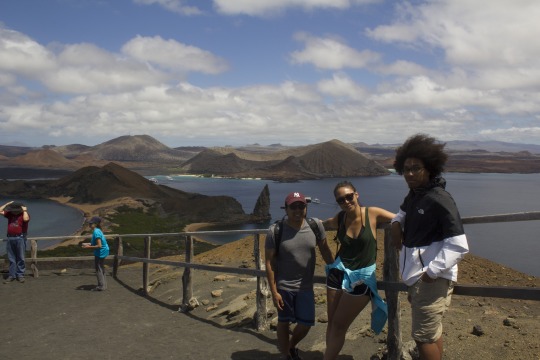
Along the way, I began to talk with a woman who works for IBM and was traveling solo from Venezuela. She was really sweet, and we bonded over our opinions on enjoying life and the little time we have on this earth. After our hike, we headed back down to the boat, which took us to the north beach adjacent to Pinnacle Rock. Here, we were able to snorkel around a particularly active reef, where tons of colorful fish were swimming around. Since it was an overcast day, the water was too cold for most people. X and Will had pretty much determined they were going to spend the entire tour day napping whenever they could, so they took this opportunity to lay on the beach. But for me, it was my last afternoon in the beautiful paradise of the Galápagos Islands, and I wasn’t going to waste any chance I had to jump into the ocean.
I’m not going to lie and say that I wasn’t disappointed when the tour guide told me that fur seals are hardly ever spotted during the day, but I was still glad to swim around the magnificent sea life I was feeling particularly grateful to be surrounded by that day. So there I was, minding my own business, drifting along with the currents and marveling at the beautiful fish, when suddenly a playful sea lion swam out of nowhere and started twirling all around me. Now, I was perfectly aware of the rules - humans are not allowed to touch any animals in the Galápagos, especially sea lions, whose mothers abandon them if they smell the scent of a stranger on their babies. I did my best to avoid bumping straight into this little guy, but he literally bopped his nose right onto the GoPro I was holding onto and proceeded to swim circles around me! By now, the other tourists that had been relaxing on the beach were clamoring to get into the ocean to get a closer look, but once the crowds got in, my playful friend disappeared back into the waves. I like to think that he was a messenger sent by the fur seals to wish me a happy birthday and apologize for their absence.
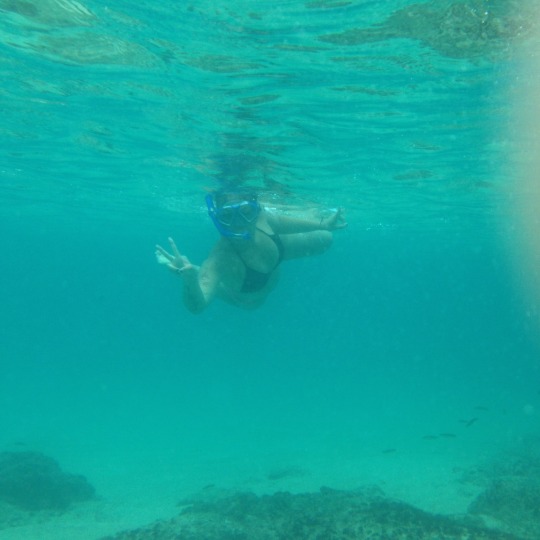
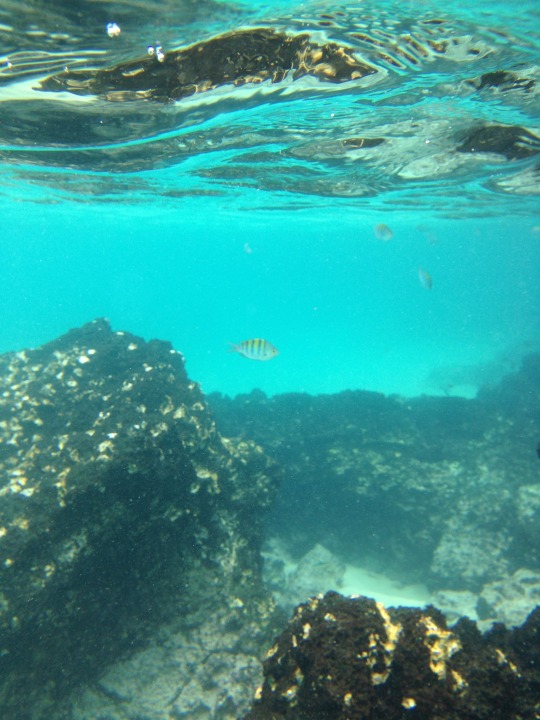
After snorkeling, we boarded the boat again for lunch before embarking back to Santa Cruz. Since this was a much larger tour group, the boat was larger too, and was equipped with a kitchen and dining area below deck. We enjoyed a nice hot meal prepared by the crew before heading back to shore. This time along the way, I chatted with Javier, who was traveling with his wife, parents, and two daughters and their boyfriends from Puerto Rico.
By the time we arrived back to Puerto Ayora, it was late in the afternoon and we were exhausted. We headed back to the hotel, but I realized I didn’t have any more shampoo left, so Will and I set out to walk to the supermarket by the pier. It wasn’t a long walk - only about 10 minutes, but the entire time, I felt like people were looking at me. I get paranoid all the time, so I tried to brush it off, but I couldn’t help but notice eyes from shops and cafes all along Ave Darwin glancing at me, some turning their heads to look. Feeling self conscious, I asked Will if he noticed, but he was busy on his phone. He started to reassure me, “No one is looking at you,” when suddenly, as we passed La Garrapata, he said, “Oh wait, our waiter from your beeday just pointed at you.” I thought this was strange, but had no explanation, so by the time we got to the supermarket, I forgot about it all. That is, until we started on our way back. Hands now full with shampoo and nail polish remover, and the sun already set, we walked along Ave Darwin back towards our hostel. Again, I felt eyes on me, and thought I even caught someone chuckling at me. Now it felt like the Twilight Zone and everyone knew a secret that I wasn’t aware of yet. Then, as if the stars themselves had done this for me, there he was.
I’ll never forget that image of Raúl, with a teal tank top and a backwards burgundy hat on, smiling that dreamy grin that could melt the skin right off of me. He was standing with friends, eating out of a granola foil or candy wrapper. “Hello,” he said. I was literally speechless. All I could do was smile and keep walking. A few strides away, an American couple behind us were giggling. The woman said to me, “Those guys were definitely checking you out.” I couldn’t even bring myself to glance back. Jasmine, you idiot.. after giving him your number, which he can’t even use to contact you, and realizing that you hadn’t activated WhatsApp on your travel phone so you couldn’t even use that with WiFi, you just walked past him? Idiot.
Now we were back at the hostel, and I was baffled at myself. I was desperately trying to connect to WiFi to ask Kellie for advice, but nothing was going through. Feeling defeated again, I took a shower, and we decided to head back to il Giardino for dinner. At dinner, I could hardly eat. I was suddenly feeling so nervous again, and I didn’t know what to do. Will and X insisted that the only thing I could do was to go back to the bar that night. They weren’t going to come with me, but it was the only way I’d get to see Raúl again. So after dinner, I packed all my bags, knowing we would have to leave the next morning at 5:30am to take a taxi to the airport. I didn’t know what time I would be out until, but I wasn’t going to take any chances.
My heart was beating like a drum again as I walked down Ave Darwin. I could feel my heartbeat in my throat as I tried to swallow every breath. I climbed the stairs to Bongo slowly, nervously. When I got to the last step, I stopped. There he was, glowing under the overhead lights just like the first night I saw him, and suddenly a wave of calm washed over me. I took a seat at the bar and asked for a Cuba Libre, and then I watched him - pouring, mixing, like that first night. But this time, he looked up, and there I was - falling in love with him.
I spent the rest of the night sitting on that bar stool until closing, mostly just chatting with the few other patrons, including a frequenter named Chino, and a scuba instructor named Victor who tried to earn a quick $40 to split with me by bringing me over to a table that told him they’d pay him to get my attention (I refused). At one point, Raúl asked to take a photo with me, which I’m pretty sure he then sent to his friends. Coincidentally, shortly after we took the photo, the tall waiter who had served us on my birthday came running up the stairs laughing, to playfully punch Raúl in the arm. They had been friends all along - the guy who, at the beginning of our trip to Santa Cruz, was looking for me, and the guy who, by the end of our trip, I had been looking for.
After he closed the bar, Raúl took me for a walk around Puerto Ayora, and asked me if I was hungry. Instinctively, I said yes (because I’m usually always hungry) but I was still too nervous to eat, so when we sat down and he ordered two enormous identical plates, I’m sure he got the wrong impression of my appetite - after all, he scarfed down his entire plate of chicken, rice, beans, salad, and fries in a few minutes, and all I did was pick at my fries. When he got up to pay, I offered some money, but he refused. Feeling guilty about all the food I was wasting, I asked him if we should wrap it, and he just assured me that it was okay. He was so genuine in the way he said, “it’s ok, you’re full” - all I wanted to do was kiss him.
By the time Raúl walked me back to the hostel, the sun was just about to begin rising, and our taxi truck was already waiting outside. When he hugged me and asked me not to go, something in my heart told me I knew I would be back, so I promised - I’ll be back.
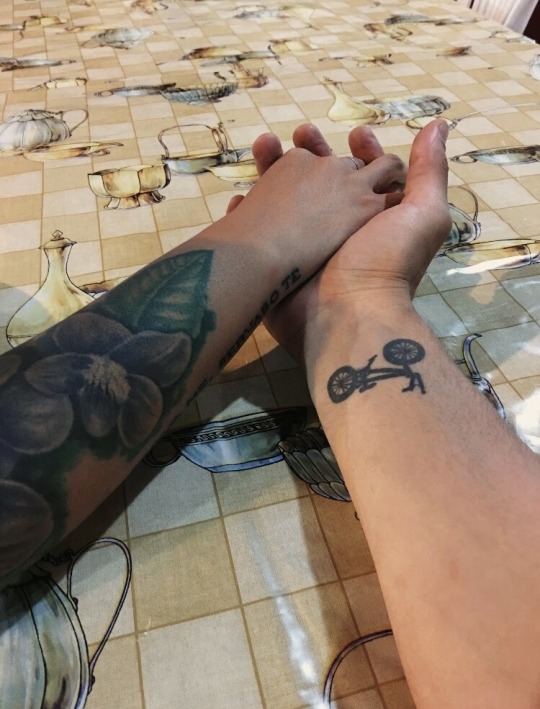
8/3, Wednesday: DAY 13: SANTA CRUZ // QUITO
Still sleepless when we landed in Quito, we stopped for a quick bite inside the airport before hailing a cab to our hostel, Hotel Cuba Vieja (~$25/pp per night for a room with 2 beds & a cot), a beautiful and cozy little place with colonial vibes and the most amazing complimentary breakfast. When we arrived, I immediately fell onto the bed to take a nap. By the time I woke up, it dawned on me the huge difference in WiFi connectivity here in Quito versus in the Galápagos, as messages started spilling in. I was surprised that the boy I met at Leprechaun in Baños had found me on Facebook and messaged me to let me know he had taken a bus to Quito and would be here for a few days with friends.
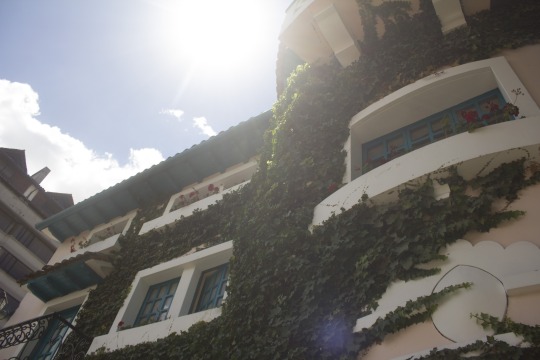
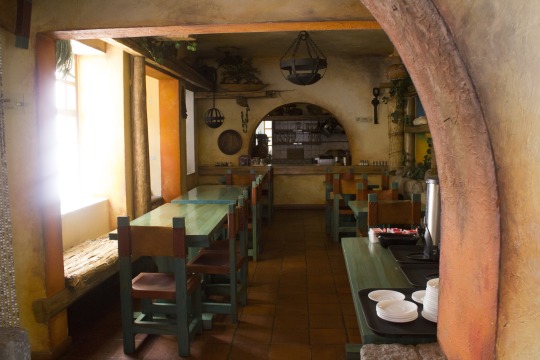
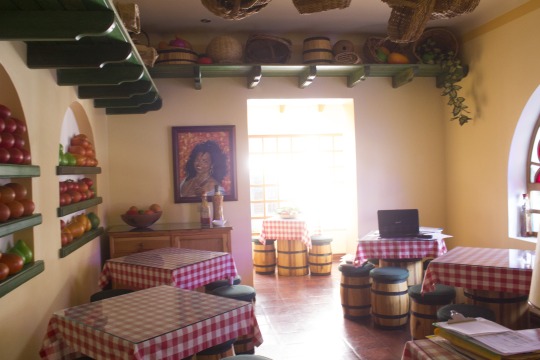
We met up at the Juan Váldez Café at Plaza Foch in La Mariscal Sucre, where he was hanging out with a friend named Iris, a beautiful blonde Russian who spoke perfect Spanish and English too. Little did I know in that short encounter with Iris that she would become one of my closest and dearest friends, who I would return to Ecuador with a few months later.
Later, we met up with Will and X at Azucar Beach just across the street for some drinks. I was feeling extremely tired and congested from the elevation of Quito, so I could barely finish my beer before needing to call it a night.
8/4, Thursday: DAY 14: QUITO
The next morning, we set out early to take a taxi to the TelefériQo ($8.50 round-trip for foreigners), a gondola lift running from the edge of the city centre up the east side of Volcán Pichincha to the Cruz Lom lookout at 4,100 m (13,451 feet). There’s also a path from the Cruz Lom lookout that leads to the summit of Rucu Pichincha, but there have been many reports of robbery and assault at all times of the day, so it isn’t recommended.
It’s actually suggested that visitors spend a few days in Quito to become more acclimated with the altitude before even visiting the TelefériQo, but we were eager to spend the day exploring, since we had initially planned our itinerary to only spend 3 days in Quito and the last 2 days in Otavalo. After we rode the TelefériQo to the top, we took some photos at the lookout and rode it back down. When we were done browsing the souvenir stands at the bottom, we started to head back towards the main road to catch a taxi when I started chatting with a man also headed that way. When he asked us where our next destination was, and I told him we wanted to see the center of the world and visit the Intiñan Solar Museum, he offered to drive us to both, and two additional destinations, for $30 total.
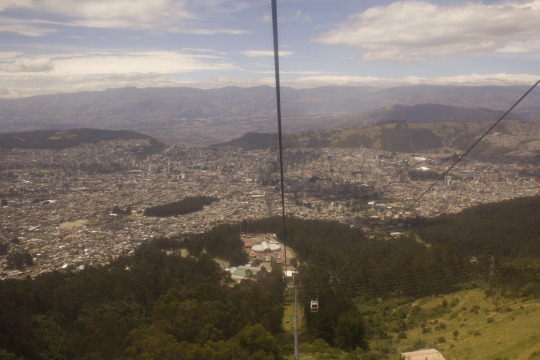
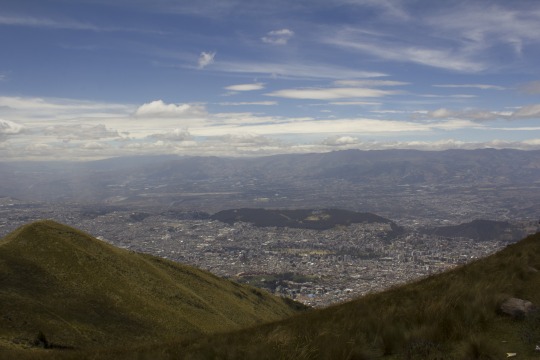
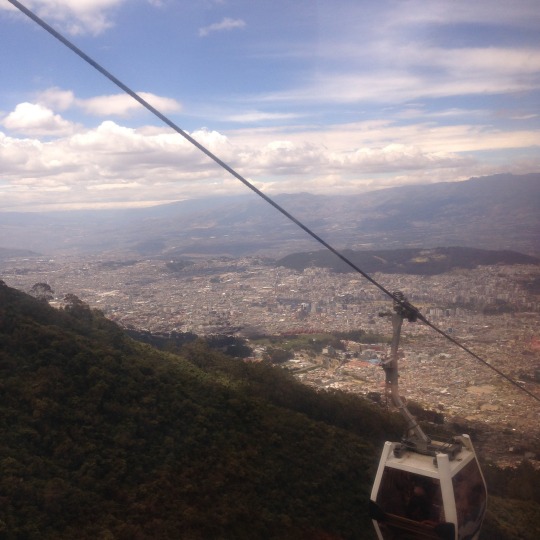
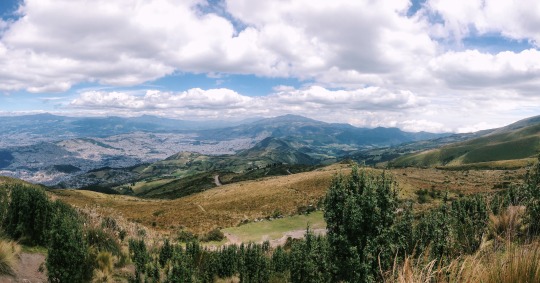
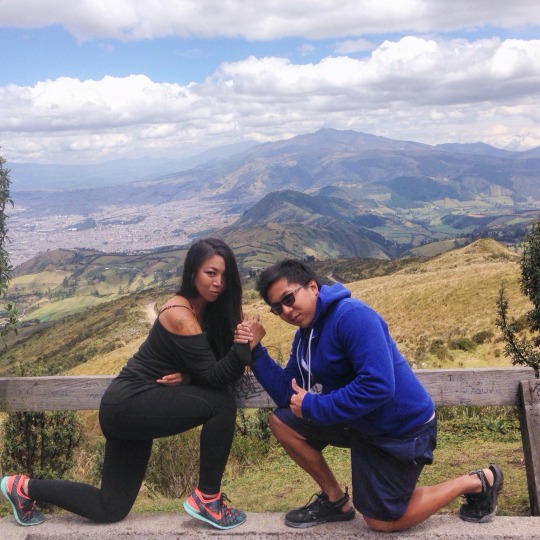
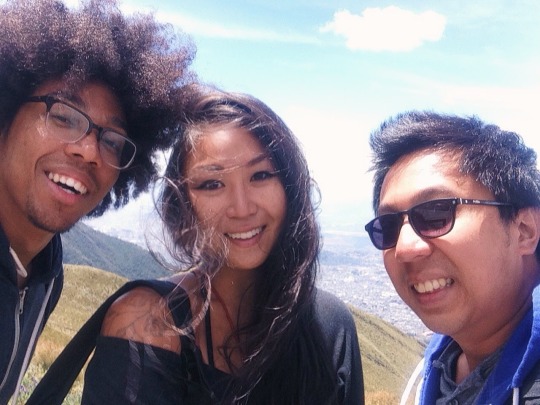
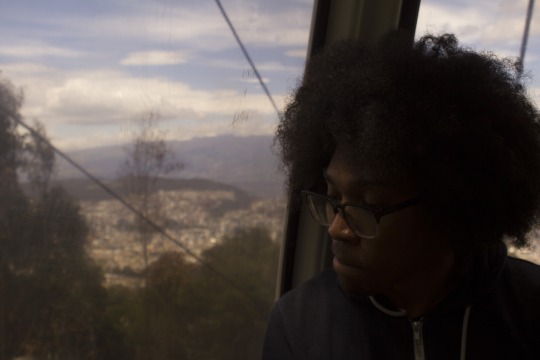
This is the part where I broke the “only take taxis with orange license plates” rule, since his taxi was actually a van. I know what you’re thinking, but it gets even weirder.. because once we got to the end of the winding road that leads up to the TelefériQo, he stopped the van, and opened the door. Then he explained that his brother Jesús would take us from here - his brother was parked in a burgundy 4-door, with his son in the back seat. Then he asked us, “is it ok if his son goes with you too?” Baffled, I nodded, and got into the front seat of the car. I know what you’re thinking. X and Will were thinking it too, as they reluctantly got into the back seat with this boy who couldn’t have been more than 10 years old. As we started to drive, X passed me a note on his phone that read, “this feels sketchy,” but for some reason, I trusted that everything was going to be just fine.
It was a silent hour-long ride to the Museo Solar Inti Ñan (Intiñan Solar Museum), but once we arrived, I think Will and X felt more relieved. Admission to the museum is only $4 for adults, and includes a guided tour in English or Spanish. Our guide was fantastic, as she took us throughout the museum grounds to teach us about the indigenous tribes of the Amazon, the dangerous animals and insects of the jungle, fun physics experiments to prove that we were standing at the center of the earth, and even live guinea pigs. Although the equator line has been remeasured, many people still consider this the true Mitad del Mundo (“Middle of the World”). In fact, if you bring your passport to the Intiñan Museum, you can have it stamped with a Mitad del Mundo stamp.

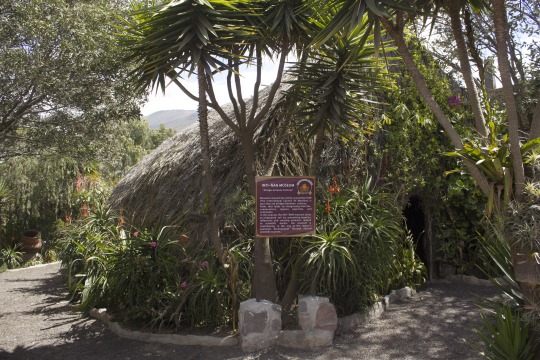
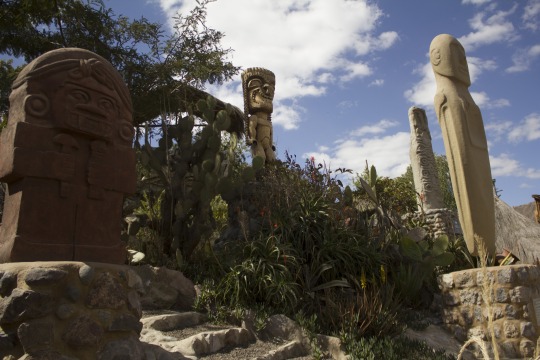
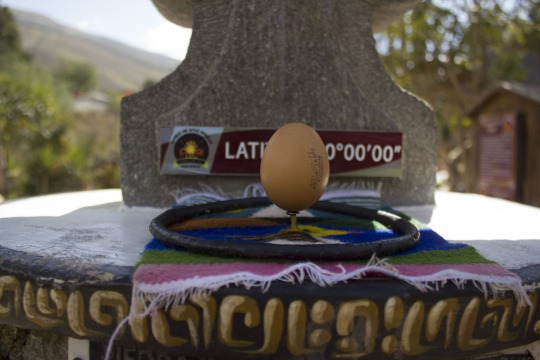
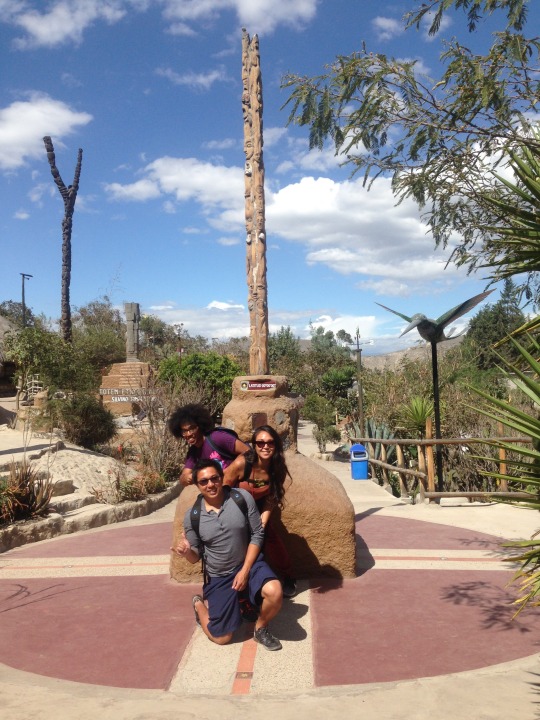
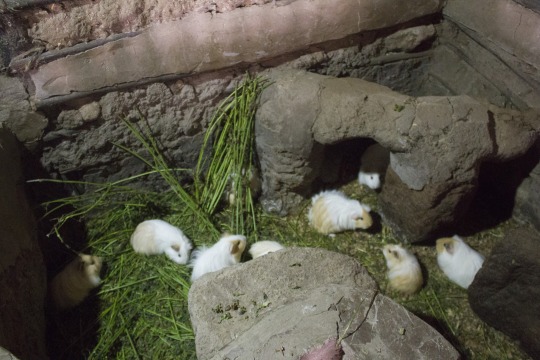
At the end of our tour, we got to learn about the origins of the cacao tree, the cocoa bean, and go through the process of making chocolate - including tasting a fresh cocoa bean taken out of a cocoa pod, and the end product of the dried cocoa bean that results in cocoa butter and cocoa powder. Then, we got to browse the wide assortment of Pacari chocolate, the first single-origin organic chocolate entirely made in Ecuador. The word Pacari means “nature” in Quechua, an indigenous language of the Andean region. I’m usually not a big fan of chocolate (I prefer salty snacks over sweets) but Pacari’s Café Cubierto con Chocolate (chocolate covered espresso beans) has made it into my top 5 favorite treats.
Our next stop was Volcán Pululahua, an inactive volcano in the Pomaqui Valley of the Pichincha Province that erupted 2,500 years ago, leaving a huge volcanic crater that has since grown green and lush. At 34 square kilometers, the volcanic crater is one of the largest in the world, with a lava dome in the middle that rises around 500 meters above the crater floor and is covered in cloud forest vegetation. Believed to be first settled by the Incas, Pululahua is one of the only two inhabited volcanic caldera in the world, and the only one cultivated by its inhabitants. Pululahua is Quichua for “Smoke of Water” or “Cloud of Water” which probably refers to the neblina (fog) which rolls in around midday every day and fills the crater. Because it virtually never rains at Pululahua, the fog is the only real source of water for the crops cultivated here, supporting cloud forests and many species of orchids and fertile farmland. For this reason, Pululahua was declared a Geobotanical Reserve in 1966 and is regulated by Ecuador’s Ministry of the Environment.
(source: ecuadortravelsite.org)
Visitors can descend into the actual crater of Pululahua but we decided to take in the view at El Mirador, the observation terrace near the south west side of the calder, before stopping into the gift shop where we picked up some souvenirs from a nice woman who tied matching woven bracelets onto our wrists (I haven’t taken it off since then). Afterwards, we headed to our last destination of the tour.
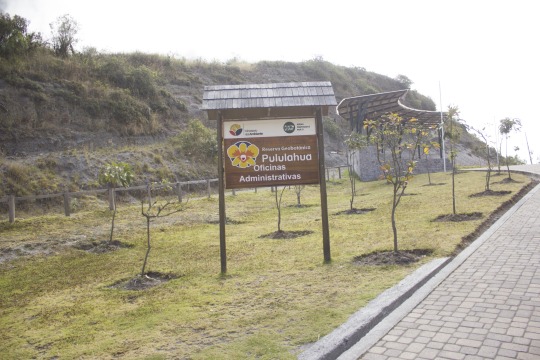
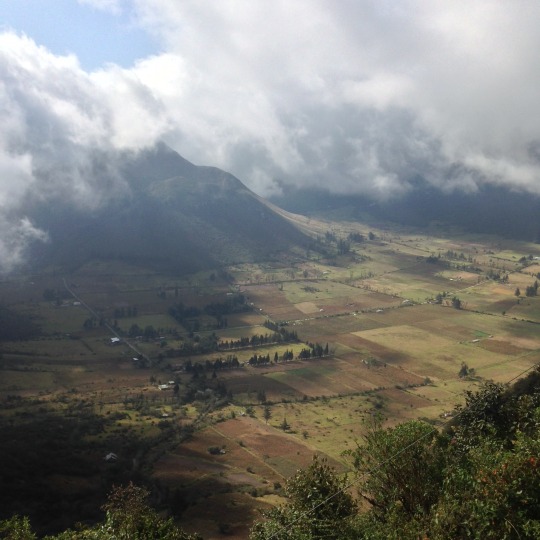
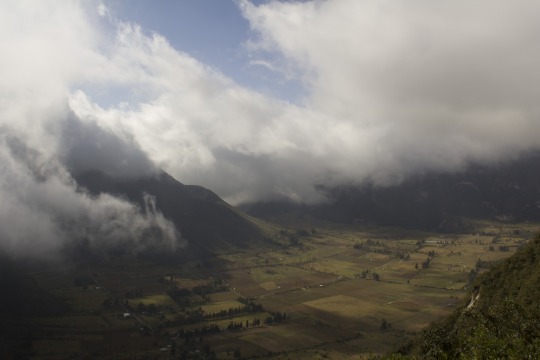
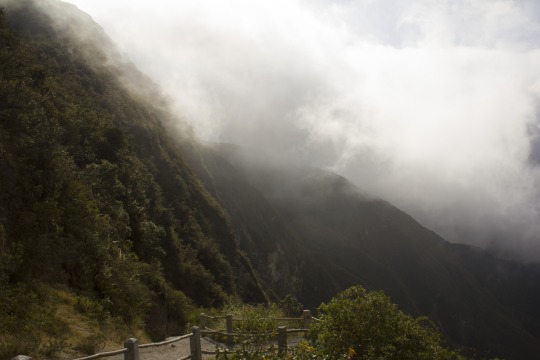
When Jesús pulled up to the curb of Ciudad Mitad del Mundo (“Middle of the World City”), he mentioned to me that since there is a fee ($3 admission) to enter the monument grounds, he and his son would wait for us at the curb. Mind you, I was only 4% fluent in Spanish at best, so most of the time, I could understand the general point of something but miss details. We got out of the car and walked up the steps to the monument entrance, towards the 30-meter-tall polished stone trapezoidal monument topped with a brass globe. The tower was constructed between 1979 and 1982 by Pichincha’s Province Council to replace an older, smaller monument built by Government of Ecuador under the direction of the geographer Luis Tufiño in 1936.
(source: Wikipedia)
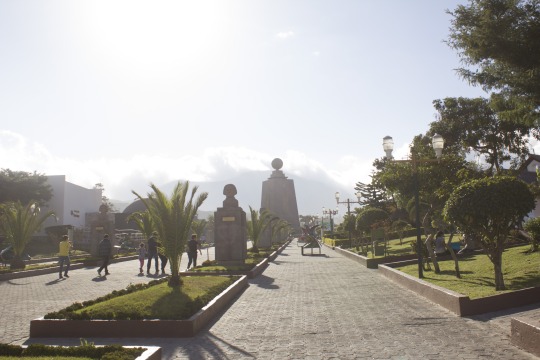
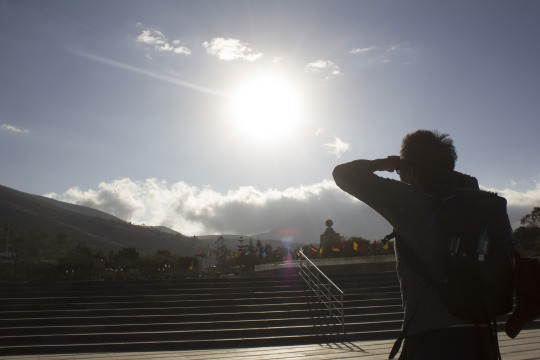
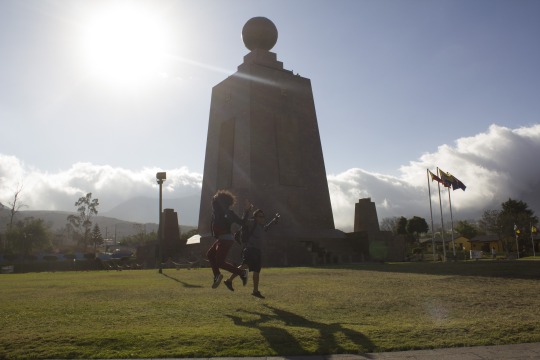
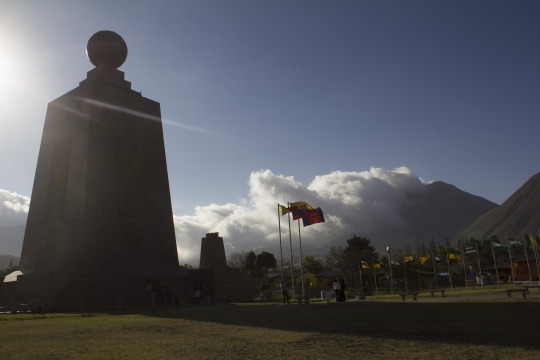
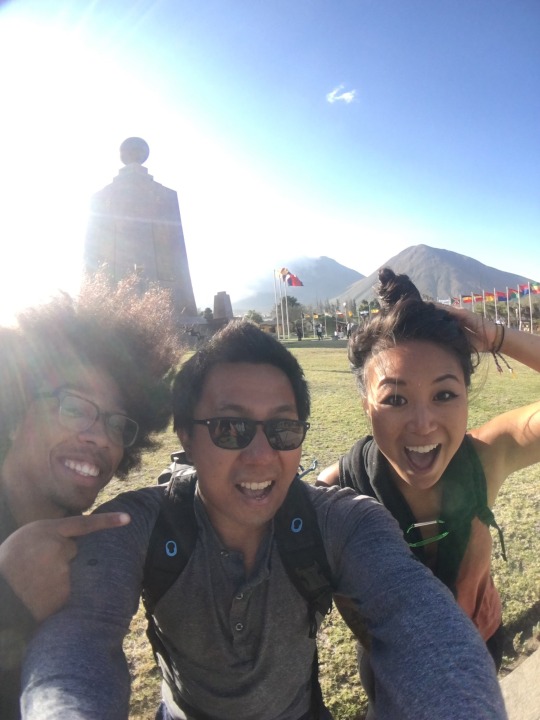
Exhausted from the long day, we headed back quickly after just few photos and a quick lap around the windy grounds, without even bothering to visit the ethnographic museum. But when we returned to the corner of the curb we had been dropped off, we couldn’t find Jesús. X and Will started to panic, thinking that he had driven off with our souvenirs and abandoned us. That didn’t make sense to me, since we hadn’t even paid him the tour fee yet, and we had all of our valuables with us. So we waited, as time crept by. The guys started looking around the parking lot, thinking maybe he decided to park and take his son inside, but the car was nowhere to be found. I started to worry a little too, but then I remembered we only spent about 10 minutes exploring the grounds, which he probably didn’t expect. I reasoned that maybe he took his son to get something to eat, or maybe the kid had to pee (I know I did). Just as the sun began lowering, and we were debating hailing another cab, there he was, pulling around the curb.. the boxy burgundy 4-door that reminded me so much of our old-school Toyota family car from my childhood. When he pulled up, I was ecstatic. I felt like I had just successfully proven that my gut feeling was right all along. When Jesús dropped us off at our hostel, we handed him $40 and some Pacari chocolate for his son. In return, he handed over his business card for Transporte Turistico - turns out he was legit all along. We highly recommend Jesús Guamán (WhatsApp: 0988 178 109, Email: [email protected]).
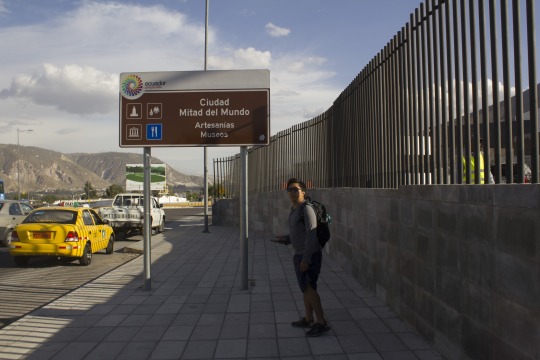
That evening, we met up with Nathan’s friend Sophie, who was born and raised in Quito and studied abroad in Boston where she met my brother on a salsa dance cruise. Luckily, Sophie shared the Chow family affinity for international cuisine and recommended that we try Hasta la Vuelta Señor, a classy sit-down restaurant with amazing authentic dishes from the highlands. We tried the festival de empanaditas, which was like a sampler that included a selection of small corn pancakes stuffed with cheese, two small puff pastries with cheese filling and two small meat filled maize pastries, which were all delicious. We also had the mote con chicharrón, which is boiled white corn with fried pork rind, and a few different drinks including jugo de naranjilla (my favorite) and chicha, a maize beer originating from the Andes.
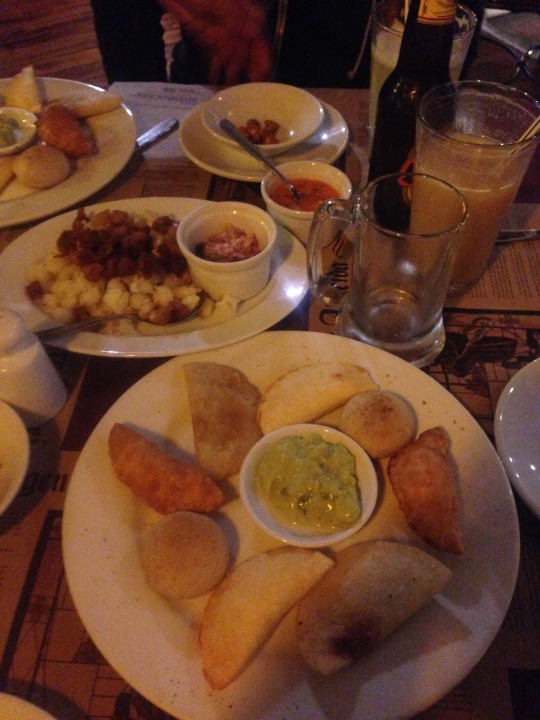
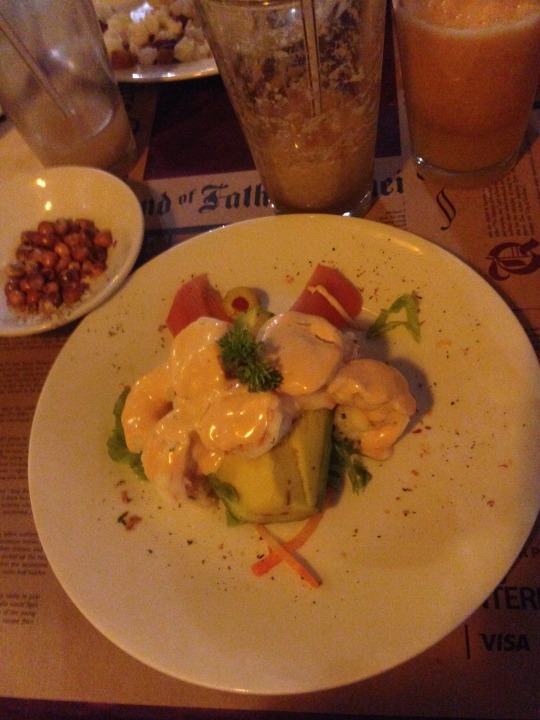
Luckily, our hostel was just a few blocks away from the restaurant, because by the time we left, we were all sleepy and cold. Sophie explained to us that in Quito, a range of seasons happen each day - from a hot sunny day in the afternoon to a chilly autumn night after sunset. Because of its elevation, Quito receives some of the greatest solar radiation in the world, meaning that even though it doesn’t necessarily feel overwhelmingly hot, the sun can easily burn during the day. Like its weather, the city of Quito offers a wide range of culture, from the club district of La Mariscal where we were staying, to the foothills of the Andes mountains. Sophie was born and raised in Quito, and by talking to her, I could tell how much love and pride she has for her city. We were lucky enough to share our experience with a native of the city. In fact, Sophie’s love for Quito was what inspired us to cancel our last leg of the trip to Otavalo and extend our stay in Quito instead.
Quito, formally San Francisco de Quito, is the capital city of Ecuador, and at an elevation of 2,850 metres (9,350 ft) above sea level, it is the highest official capital city in the world and the one which is closest to the equator. It is located in the Guayllabamba river basin, on the eastern slopes of Pichincha, an active stratovolcano in the Andes mountains. With a population of 2,671,191 according to the last census (2014), Quito is the second most populous city in Ecuador, after Guayaquil. In 2008, the city was designated as the headquarters of the Union of South American Nations. The historic center of Quito has one of the largest, least-altered and best-preserved historic centers in the Americas. Quito and Kraków, Poland, were the first World Cultural Heritage Sites declared by UNESCO, in 1978.
(source: Wikipedia)
8/5, Friday: DAY 15: QUITO
The next morning, I met with Ivan at the Juan Váldez Café at Plaza Foch again to explore the cathedrals of Quito. We took a taxi to the northeastern part of the Old Town, where Basílica del Voto Nacional (“Basilica of the National Vow”) looms high on the San Juan hill as the largest neo-Gothic basilica in the Americas. Rather than gargoyles, Ecuadorian animals like tortoises, iguanas, and armadillos protrude from the church’s side, decorating the high towers that visitors can climb after walking a wooden plank inside the main roof. Admission into the church is $1.50, and an additional $2 to access the towers. Inside the sanctuary, beautiful stained glass spills sunlight onto the cold concrete in soft pink hues that also graze fourteen bronze statues that represent eleven apostles and three evangelists. The real prize, however, is seen from the balcony and the rooftops, where we took in spectacular aerial views of the Old City and La Virgen de Quito in the distance.
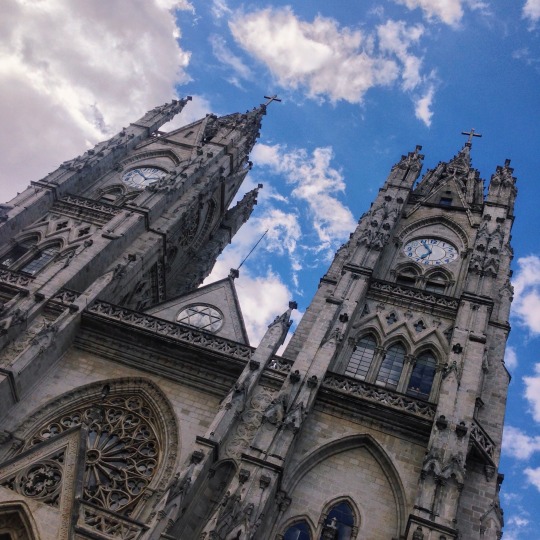
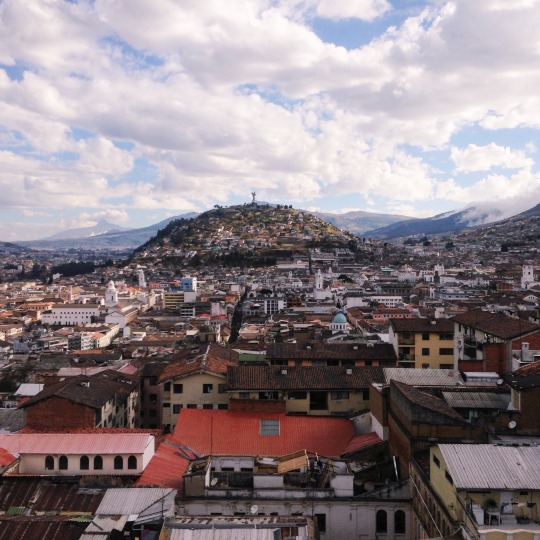
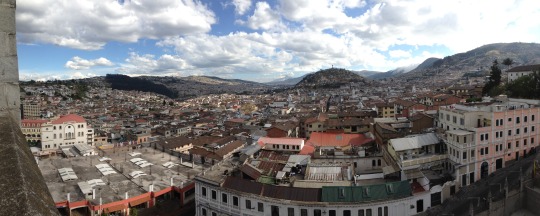
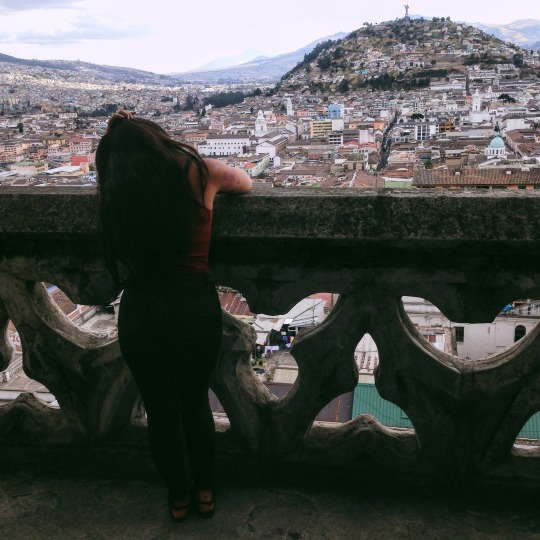
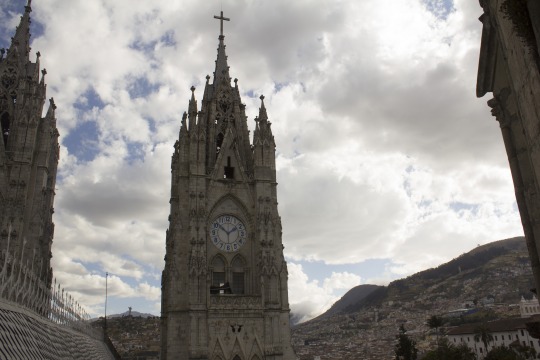
The basilica was proposed in 1883 by Father Julio Matovelle as a monument as a perpetual reminder of the consecration of Ecuador to the Sacred Heart, and by 1884 the president had begun budgeting for the construction. It wasn’t until 1892 that the first stone was placed, and finally by 1909, the Heart of Mary Cathedral was constructed as a religious commitment in the name of the country. The basilica was blessed by Pope John Paul II on January 30, 1985, and it was consecrated and inaugurated on July 12, 1988. The basilica remains technically "unfinished,” sunlight basking on the bare tresses that lead to the rooftop. Local legend says that when the Basílica is completed, the end of the world will come.
(source: Lonely Planet, Frommers & Wikipedia)
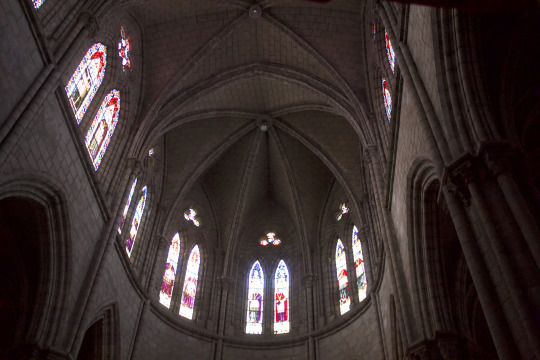
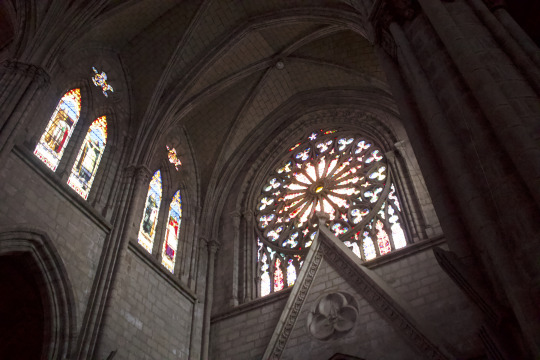
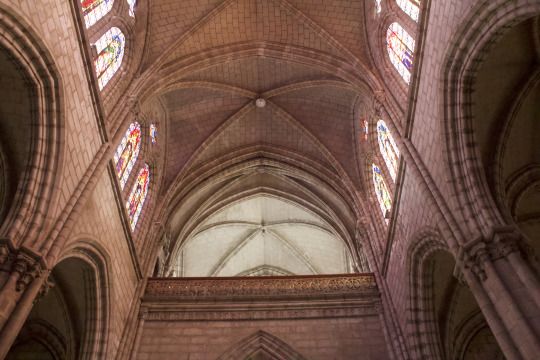
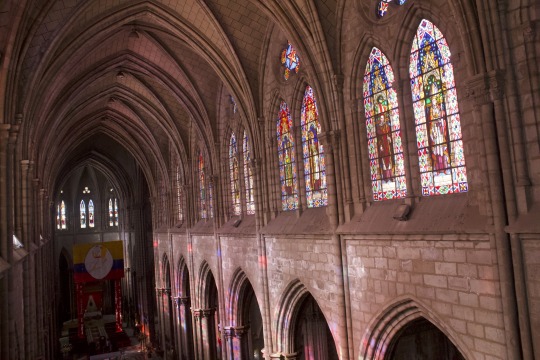
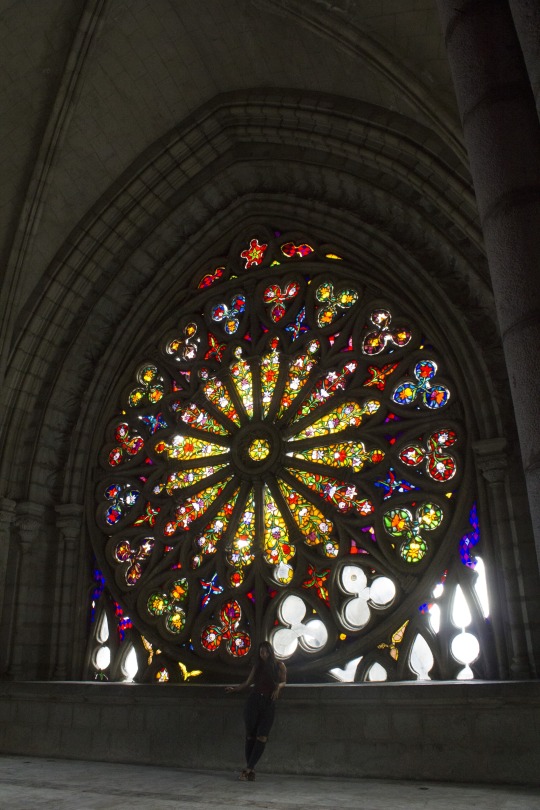
Our next stop was La Iglesia de la Compañía de Jesús (“The Church of the Society of Jesus”), better known as La Compañía ($4 admission). The Jesuit church is one of the most significant works of Spanish Baroque architecture in South America, known for its large central nave, decorated with gold leaf, gilded plaster and wood carvings after 160 years of construction from 1605 to 1765. The floor plan of this beautiful church forms a Latin Cross, creating perfect symmetry with its walls that drip with gold. Photography isn’t permitted, but rules are made to be broken, right? :)
(source: Wikipedia)
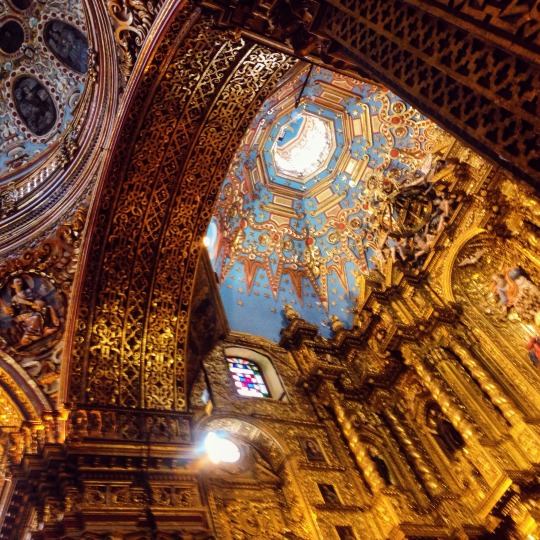
After our day tour around Old Town, we headed back to La Mariscal, where we split ways, and I went to meet Will and X for dinner plans with Sophie and her boyfriend. At first, we planned to meet at the food trucks at the corner of Avenue Mariana de Jesús & Av. Río Amazonas, which was just a short walk away from our hotel. But when we arrived, it was so crowded that there was barely any room to walk between the throngs of people, sitting on the pavement, on the curbs, standing around, framed by a perimeter of food trucks in a dark parking lot lit only by the fluorescent bulbs inside of the trucks. For a moment, I felt nostalgic - like I was in highschool again, going to the Grease Trucks in New Brunswick for the first time.
Once we spotted Sophie and she introduced us to her boyfriend Miguel, they suggested we head to another location with seating. We hopped into their car and headed over to La Platea, a beautiful little food truck stop at Avenue La Coruna. The area was decorated by recycled materials, crafted into adorable crate seating and unique artwork all around. Designed with a great use of space and much better lit than the previous location we tried, this spot felt more like Smorgasburg on a summer night in Coney Island, and it was just as crowded. Long lines stemmed from every single one of the trucks, leading into the central lounge where every seat was taken, whether it was a wooden crate, a bundle of hay, or a vintage stool. After browsing all of the delicious options, Sophie and I placed our orders at Cleto’s Burgers while we scanned the crowds for parties nearing the end of their meals, hoping to eventually poach their table. Finally, we were able to sit down and enjoy our dinner together before Miguel and Sophie drove us back to our hotel.
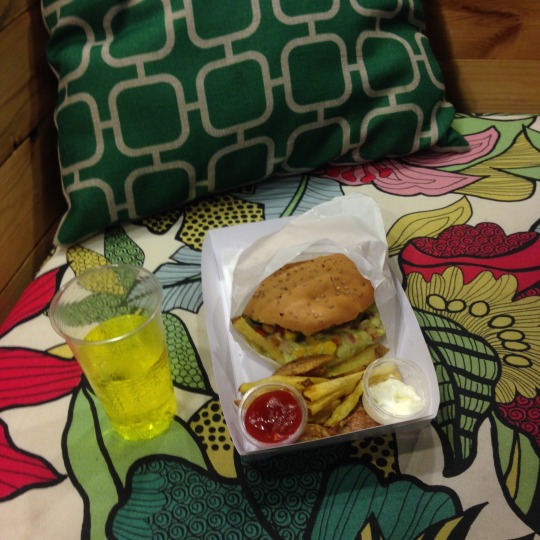
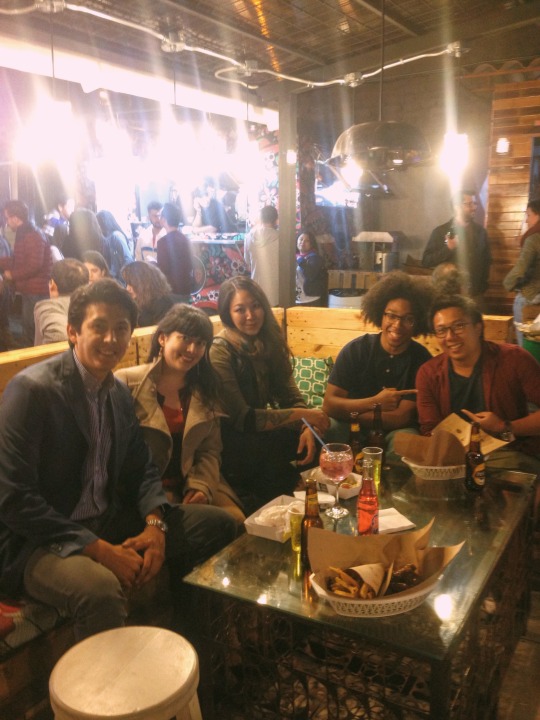
8/6, Saturday: DAY 16: QUITO
The next morning, we woke up just as the sun began to rise for a road trip to Cayambe with Miguel and Sophie. Since Miguel and Sophie live on opposite ends of Quito, Miguel must have woken up in the middle of the night to pick up Sophie before heading over to us. The drive to Cayambe was about an hour and a half northeast from Quito, towards Volcán Cayambe. Sophie and Miguel wanted to share one of their favorite restaurants with us: a place called Café de la Vaca that is well known in Quito for its delicious food, sunny ambiance, and fresh milk. Unfortunately since it was a weekend, it was extremely crowded, so rather than wait hours for a table, we enjoyed the beautiful green landscape surrounding the restaurant, played on the swings, and then headed out on our way to another local restaurant.
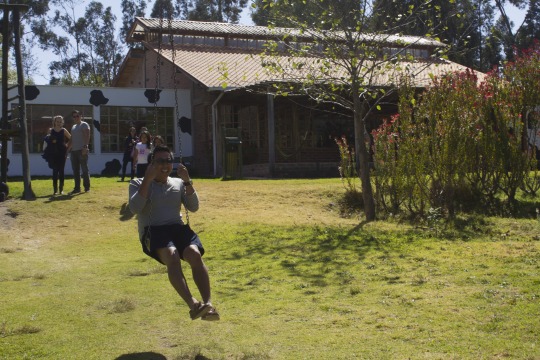
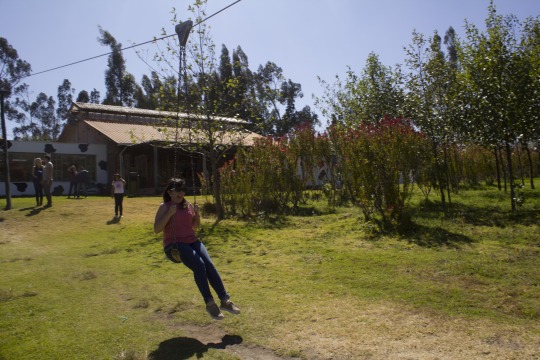
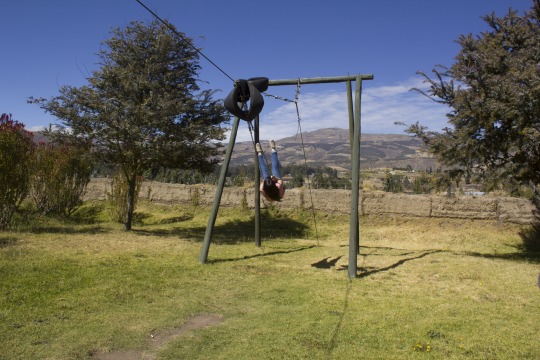
On the way through Cayambe, we stopped at Quitsato Sundial, a giant circular platform of a mosaic with light and dark pebbles drawing an eight-pointed star that indicates the solstices, equinoxes, and intermediate lines pointing to the cardinal directions. In the center of this platform there is a cylindrical orange tube which serves as a gnomon, pointing to the corresponding hours and months of the year in the platform according to the shadow cast by the sun. From here, we could see Volcán Cayambe, the only place where the Equator passes through a glacier and the highest point on the Equator in the world.
(source: Wikipedia)
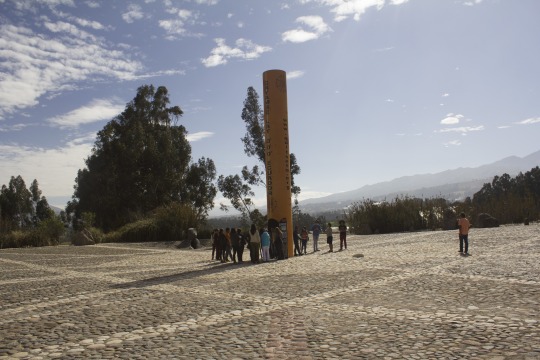
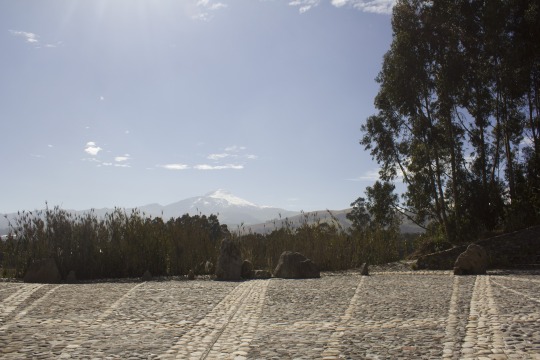
When we got into town, we stopped at Platos A La Carta for breakfast, where we shared queso de hoja and bizcochos (cheese and biscuits), a delicious Cayambe local favorite. We also ordered some other breakfast dishes, which came with drinks. I was so hungry and thirsty that I didn’t even think to smell the drink or ask what it was before taking a sip - which I would soon admit as a mistake when I realized it was pineapple juice. Turns out I’m still allergic to pineapples.
After getting sick, I was feeling exhausted, so we started to head back to Quito. On our way back, though, we spotted a restaurant called Guarango Zero advertising cuy, which Will, X, and I had not tried yet. Cuy is a delicacy in the Andean region where it was first domesticated as early as 5000 BC for food by tribes. The name cuy comes from the the indigenous language of Kichwa, because of the high-pitched bird-like sound the animal makes. In Ecuador, cuy was the main source of meat before cattle were introduced to the country, and became a status symbol because it meant you had enough money to eat meat as a luxury. Later, the animals were brought over to Europe by Spanish, Dutch and English traders in the 16th century and introduced as exotic pets because of their docile nature. Since then, the animals have adopted the name guinea pig, though the exact origin of the name is unclear.
(source: Wikipedia)
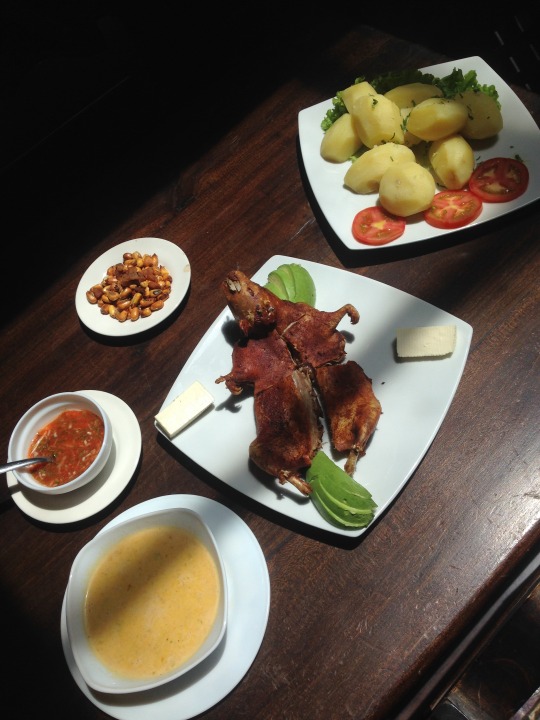
I know what you’re thinking - I’m a monster for eating an adorable little guinea pig. But to be honest, I feel like if you eat any kind of meat, that’s an unfair judgement. To me, all animals are adorable, but I also enjoy the idea of embracing all cultures, including native delicacies. I must admit that I struggled with the idea of dining on our first pet (R.I.P. Guinea) even before I left for our trip, and I still had my hesitations when the whole roasted cuy was placed on the table after an hour of preparation. But when you think about how cute baby chicks or piglets are and then devour nuggets and ribs without guilt, it seems silly to draw the line at an equally cute/edible animal. Anyway, I didn’t really enjoy the taste or texture - it was quite gamey and tough to chew, like dry jerky with a crispy skin. Apparently, the age of the cuy and preparation process plays a big factor into the taste, so I wouldn’t be opposed to trying it again, especially in colonial Cuenca, known as one of the best places for cuy.
Stuffed and sleepy, we headed back to Quito. After Miguel dropped us off, it seemed like we were all thinking the same thing - how incredibly grateful we were to have met Sophie and Miguel, and what amazing human beings they both were. It was so inspiring to explore their city with them, especially because because they love living there so much. We hope to share our home with them when they visit us in Jersey and NYC!
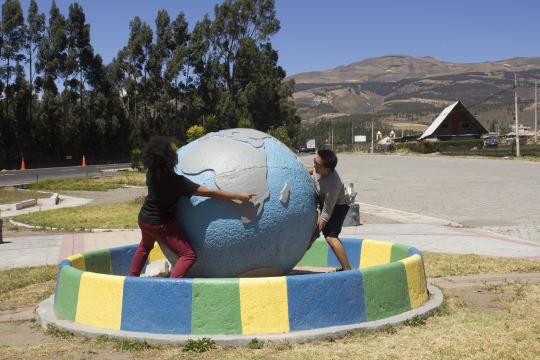
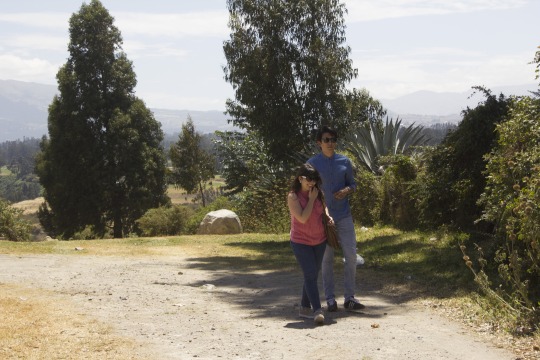
Suddenly it was our last night of the trip, and I was still on the hunt for my ultimate souvenir - a tattoo. I try to commemorate my experience in every country I visit with a tattoo, and if possible, I like to get them done in those places before I leave. Ivan had a friend who worked at Santería Tattoo Shop in Quito, so we headed there from La Foch to see if anyone was available. Leon, who was from Colombia and had been tattooing in Ecuador for years, gave me the most beautiful rose - the national flower of Ecuador - to keep with me as a reminder of my love for this magical place.
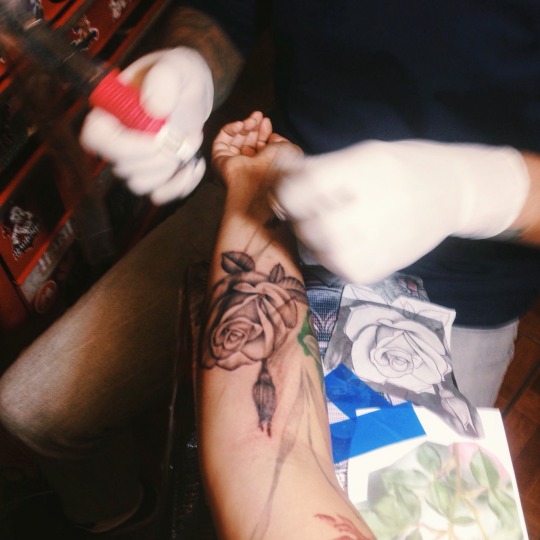
We spent our last night in Ecuador partying through the clubs Mariscal Sucre is known for, hopping from bar to clubs. It was during this evening that I began to talk to Iris more, and we realized how strongly connected we felt to each other, like we had been friends for years already. To this day, Irina is one of my closest friends, my soul sister, and my confidante. It is this feeling, of finding people who seem to be born from the same soul, that makes life so incredibly beautiful.
8/7, Sunday: DAY 17: QUITO
The next morning, we headed to the Mercado Artesanal La Mariscal for souvenir shopping/haggling before checking out of Hotel Cuba Vieja, where the receptionist called a taxi to take us to the airport. It was the end of our adventure in Ecuador, but somehow, I knew I would return soon..
0 notes
Text
MÉXICO: PUNTA MITA + SAYULITA
Hola! This past May 2016, I got the opportunity to travel to Punta Mita de Nayarit in Mexico for a business trip. Despite the long days balancing coordinating on-site event coverage and working remotely from wherever I could connect to WiFi, I still enjoyed every minute of my beautiful surroundings. Every once in a while, I was even told to take a moment to relax - so of course, I answered some more emails from my phone while floating in the lazy river :)
Now for some background information on this picturesque location. Punta Mita is a 1,500-acre beachfront village located on the north end of Banderas Bay in the Mexican state of Nayarit, about 10 miles north of Puerto Vallarta, Jalisco. On the Punta de Mita peninsula, a hilltop archaeological site known as Careers Hill has been dated to circa 800 AD. Punta Mita is surrounded on three sides by nine and a half miles of Pacific Ocean beaches and coves including Litibu Bay.
(source: Wikipedia)


We flew in to Puerto Vallarta, at the Licenciado Gustavo Díaz Ordaz International Airport. Immediately upon getting through security at the airport, I was greeted by the local tour agency we were partnered with, who offered us a basket of snacks - it’s like they knew me already. Then we were escorted into a private SUV to take us to the Four Seasons Resort in Punta Mita. The 45-minute drive to the resort made me feel like I was back in Cebu, driving past little roadside restaurants adorned with plastic tables and chairs covered with a tarp tent roof - mostly branded with Coca-Cola.

There’s a good reason why the Four Seasons Punta Mita is known as the best hotel in Mexico and is rated with 5-stars and accolades for its incredible service; at every corner, there’s a smiling concierge or waitstaff ready to make you feel like royalty (shout out to my dudes Armando, Geraldo, and Antonio!). As a precursor, you should all know by now that I travel on a budget. The only person I know better at traveling on a dime than me is my brother, Nathan, who I learned most of my planning and scheduling tricks from to make the most out of every penny. It’s also important to remember that being a good host to visiting friends is not only super fun, but while you’re showing your homies your hometown, you’re also networking with a bunch of awesome people who will ultimately return the favor when the time comes!




In any case, this was my first ‘resort’ experience, and the fact that it was pre-paid for work made it even more enjoyable. A lot of people ask me how I can be content with a career that basically takes up my time 24/7, and is often times extremely stressful. The answer is simple - my personality and the fast-paced, high-stress creative industry fit hand in hand. I crave the unpredictable, and my flighty tendencies often call for the need to travel to new places. So while I can be overly managing and super organized, my restless mind can’t handle repetition for too long, and this just worked out perfectly. I’m happier than I’ve ever been now that I can wake up excited to live every single second of every day!
Alright, enough deep stuffing. Here’s a brief recap of my week in Punta Mita, starting with a dip in the infinity pool overlooking the Pacific Ocean. Also important to note that regardless of how many tacos I consumed while in Mexico, siempre quiero más tacos.







After a few days of working on-site at the resort and many late-night room service tacos, I took one of the off-site activity trips to a small town about an hour away. Sayulita, otherwise known as Pueblo Magico or “magic town,” is a village about 25 miles north of downtown Puerto Vallarta. It’s a sleepy little beach town that now teems with tourists and merchants in its adorable little streets lined with outdoor souvenir vendors, leather shops, art galleries, coconut stands, and cafe/bars.
Known for its consistent river mouth surf break, Sayulita was "discovered" by roving surfers in the late 1960s with the construction of Mexican Highway 200. Today, Sayulita is a prosperous growing village. Sayulita is the crown jewel in the newly designated "Riviera Nayarit," the coastal corridor from Litibu to San Blas. With a growing ecological awareness and stricter zoning enforcement, development is being regulated to help safeguard the environment and quality of life of the community.
(source: Wikipedia)
As I waited for our photographer to arrive to capture beauty shots of the town and event participants shopping, I took a stroll around the streets to haggle for some souvenirs of my own, and a sweet uniquely hand-made leather satchel for less than $20. Of course, I had to add my own touch to it, so I also got a little neon pom-pom rope and colorful silk tassel to add to the side. Some other goodies included some woven coin pouches, a brass ring featuring a beautiful moonstone that reflects shades of purple and blue, and thread friendship bracelets. I also got myself a tasty & refreshing coconut too!













Our last evening was spent on the island of Caletas, about an hour boat ride from the Punta Mita port, where we had our last dinner and watched the impressive Rhythms of the Night performance with fire-dancers, ballerinas, acrobats, and music. On the way back, I sat near the captain who showed me how to read the GPS and steer, when suddenly dolphins began jumping up from the water, basked by the glow of the full moon that night.





It was a short, sweet, and exhausting trip, but some of the highlights that I’ll never forget are the daily breathtaking sunsets evolving through ranges of the spectrum in cotton candy palettes and fiery warm tones, the delicious fresh seafood I ate every day, the warm and inviting Four Seasons family, the beautiful coral-filled beach on the Pacific Ocean, and basking in my favorite weather - hot and sunny - all day long. I’ll miss the home-made chilaquiles at desayuno, eggs that taste as if Jesus had laid them himself, the fresh-caught red snapper that melts on your tongue before you can even chew, huge sweet oysters, pescado tacos, camarón tacos, chorizo tacos, carne tacos, pollo tacos, asador tacos, al pastor tacos..all the tacos. Gracias por un tiempo hermoso, México!





0 notes
Text
JAPAN
Konnichiwa! So once again, I’ve fallen far far behind on keeping properly updated on sharing my photos and experiences in my travels. Better late than never though, right? Hopefully. Anyway, last summer, I traveled to Japan with two of my oldest friends - Will & X. While X has always dreamed of visiting (and eventually living in) Japan, the three of us started planning this trip together early in the year, meeting on weekends like a study group in the bookstore to plan every detail. Even so, there were lots of surprises that came up, and in the end, the trip was a lot more improvised than we expected.
Here’s my recap of our trip to Japan from July 25 to August 9, 2015.



7/25, DAY 1: TOKYO /// CHIYODA //AKIHABARA
Japan Airlines is hands down the best airline I’ve ever flown with so far - with double the leg room, delicious bento box meals, a wide selection of Japanese snacks and juices, and friendly attendants - I feel like I could advertise for them. Before we even boarded, a very friendly gentleman who works for Japan Airlines named Jerome welcomed us to Japan. Little would Jerome know that his kindness would set the tone for our entire trip, and we made sure to pay homage to our new friend by tagging all of our pictures with #jeromeinjapan (seriously - that was our live-feed gallery from our trip).

Once we landed in Narita Airport, the three of us set out to navigate the trains, subways, and streets of Tokyo (東京 Tōkyō; 東 tō "east", and 京 kyō "capital") with NO WIFI or phone service *gasp* in order to get to our first hostel. Immediately, we began to stumble across the plethora of vending machines that we’d soon realize are a staple all across Japan in every city and prefecture. To be honest, I wish I had taken more pictures of them just to show you the sheer breadth of the variety these machines offer. Let’s be clear - not only are there machines on almost every single block, platform, and train station, the machines themselves aren’t just standard like they are in good ol’ Murica (water, Coke, Sprite, Gatorade, meh). In Japan, there are extensive selections of soda machines, coffee machines, BEER machines, ice cream machines, toy machines, even ramen machines! (more on that last one later). You really can’t go thirsty in Japan as long as you have ¥100 on you.




It took us an hour or two to make it to our hostel once we got off the above-ground bullet train and transferred to the underground subway train. The way the ticket system works in Japan subways is due to the fact that there are so many lines and stops. If we weren’t using our JR (Japan Rail) Train Pass [for tourists], we had to read a map that had all of the stops illustrated, figure out the corresponding cost to get our destination, and purchase a ticket of that amount. This allows the machine interaction to be quick - rather than having to stand there looking for your stop amongst 1,000 other stops, you just pick the cost of your ticket. If you get it wrong, you just have to pay extra when you get to your stop. If you paid more, your loss. Whatever, the Japanese are really efficient and accurate with everything they do. They even have a little ledge for your belongings at every ticket machine, so you never have to plop your shopping bags on the ground while you rummage through your purse for money. When we got off the train, we walked for a bit trying to figure out which direction to go (since all the street signs were in Japanese).

After a while of lugging our bags around the hot streets of Tokyo, we found a 7/11 to stop into to make use of their WiFi and grab our first beers in Japan. First of all, let me just regale you of the magic that is Japanese 7/11s. Secondly, convenience stores in general in Japan are amazing, but 7/11 is by far #1 on the list of a few we frequented throughout our trip - including FamilyMart, Lawson, and SunKus. 7/11s in Japan are unlike any 7/11 I’ve ever been to. They are a sanctuary, a safe haven, a widely-spread and guaranteed destination with everything you could possibly need as you walk the streets of Japan. Not only do they blast their air conditioning, boast clean bathrooms that include elaborate toilets with bidets and buttons that play music or ‘flushing noise’ to mask the sounds of mother nature, but they also have a wondrous assortment of snacks, drinks, ice cream, beer, liquor, hot foods, you name it! One of my favorite snacks to grab from convenience stores was O-nigiri (お握り or 御握り; おにぎり), also known as o-musubi (お結び; おむすび), nigirimeshi (握り飯; にぎりめし), a snack made from white rice formed into triangular or cylinder shapes and often wrapped in nori (seaweed). Traditionally, an onigiri is filled with pickled salt plums, salted salmon, jerky, fish roe, or any other salty or sour ingredient as a natural preservative. Because of the popularity of onigiri in Japan, most convenience stores stock their onigiri with various fillings and flavors, so I made an attempt to try them all, despite not being able to read the labels. I favored the ones from 7/11 most because they had little pictures on the wrappings to clue me in on the filling, versus the ones from Lawson and FamilyMart that only had text on the wrappings. The ones from 7/11 were also filled more generously than the others. Once we grabbed our snacks and beers, we used the 7/11 WiFi to get back on track to head to our hostel.





Eventually, we made it to our first hostel, GRIDS. By the time we got there, we were all soaked in sweat. This was due in part to trekking around Tokyo carrying everything we brought for the next two weeks in huge hiking backpacks, and the fact that our entire time in Japan was painted with the haze of their hottest summer in years - I’m talking “heat index of 109 degrees Fahrenheit with up to 80% humidity” every. single. day. One of my favorite parts about the cities in Japan were their smart advertising tactics in response to the heat. Here in NYC, it’s not uncommon for someone to shove a flier towards you in hopes that you’ll grab one. Most people walk by without even so much as a glance, or worse, take the flier then drop it to the ground as litter. In Japan, though, the advertisements are often printed on small plastic fans that are handed out at street corners. I collected these fans whenever I could, and put them to good use fanning my sweating face all the way through our trip in Japan, starting in Akihabara.


Akihabara (秋葉原) is a district in the Chiyoda ward of Tokyo. The name Akihabara is a shortening of Akibagahara (秋葉が原, "autumn leaf field"), which ultimately comes from Akiba (秋葉), named after a fire-controlling deity for a firefighting shrine built after the area was destroyed by a fire in 1869. Akihabara gained the nickname Akihabara Electric Town (秋葉原電気街 Akihabara Denki Gai) shortly after World War II for being a major shopping center for household electronic goods and the post-war black market. Nowadays, Akihabara is considered by many to be an otaku cultural center and a shopping district for video games, anime, manga, and computer goods.
(source: Wikipedia)






As my first hostel experience, Grids will always hold a very special place in my heart. Given that the word ‘hostel’ has always held a certain expectation, I was beyond pleasantly surprised when we walked into Grids. For starters, the lobby area led to a bar with additional seating which more resembled a high-end, exclusive lounge somewhere in downtown Manhattan than what I had pictured my first hostel. We received our room key cards, which we tapped on our floor entrance door to enter. That little pod of mine felt more luxurious and comfortable than most hotels I’ve ever stayed in. For the next few days during our stay, we would find sanctuary in Grids, where the AC was always blasting and we could stop for a mid-day shower for some brief relief from the constant sweating.






Once we got settled in, we stopped for a quick sushi dinner at Yamato (矢まと 秋葉原店), a local restaurant. We ran into a little issue when we opened the menus and realized everything was in Japanese and there no pictures. The owner spoke Japanese but not English, and we spoke English but not Japanese. This was resolved when he recognized the Chinese characters tattooed on my back and asked me, in perfect Cantonese, if I understood. I want to be able to describe the sushi in actual words, but I honestly think the best way to sum it up is that sushi here has never tasted the same again.


When we finished dinner, we hopped back onto the JR train, which we’d quickly become accustomed to. Most of our destinations within Tokyo would run along the Yamanote Line, which we ended up using daily.




7/25, NIGHT 1: TOKYO /// SHIBUYA
Our first night began when we met Taishi at the Hachikō statue right by Shibuya Crossing, known as the busiest intersection in the world. Hachikō was an Akita dog that came to Shibuya Station everyday to meet his master, a professor, returning from work (Mom, this is the movie with Richard Gere in it that you got really emotional about). The story became legend and a small bronze statue was erected in the dog’s memory. Taishi and I were introduced through Facebook by my good friend and Jersey City roommate Dani. We also met X’s friend Dixon, who was born and raised in China, and went to school in NYC with X. I guess at first, Taishi and Dixon figured we’d want to go to the bars that all the other Americans and Europeans frequent when they visit - places that are owned by foreigners and make visitors feel ‘at home.’ But this was the opposite of what we wanted to experience - we wanted to see Japan like the locals. So Taishi took us to one of his favorite chicken spots and then an underground dance club. Sidebar: Japanese fried chicken is the best fried chicken. Seriously. Regardless of whether you order it at a restaurant or get it on a stick at your corner 7/11, it’s impeccable every time.








The combination of jet lag and adrenaline from the excitement of finally being in Japan kept us going all night, and we ended up staying out at Gaspanic until sunrise. At this point, Taishi informed us that the subways stop running from around midnight to 5am, so we decided the best thing to do would be to get breakfast at McDonald’s while we waited. It’s important to note that because of this period where the trains stop running, it’s not uncommon to find people taking naps along the sidewalks nearby the train station. While this sounds like an absolutely disgusting and unsafe thing to even consider in New York, the conditions in Japan are vastly different. The streets are so clean and unlittered that you could easily find a spot to sit or lay without questioning whether the sticky stuff you’re sitting on is gum or something worse. To top it off, Japan is the safest country in the world. Meaning, you could leave your wallet out right next to you as you napped, and the chances of it being stolen would be slim to none. In fact, if you accidentally left your wallet somewhere, you could almost guarantee that it would be untouched even hours later when you returned for it. By the time we got back to Akihabara, the sun was casting its morning light onto the streets that now seemed so empty compared to the night before.






7/26, DAY 2: TOKYO /// CHIYODA //AKIHABARA /// TOSHIMA //IKEBUKURO
Our second day in Tokyo began with an adventure to Ikebukuro (池袋), where we visited a - drumroll please - Bunny Cafe! When we first arrived, we had to wait outside (in the scorching heat, even in the shade) for a little while. It was like making a restaurant reservation - but to pet bunnies. I don’t want to harp on the heat, but I think it’s essential to convey the true experience we had in Japan. There were days where we had to stop inside convenience stores during our walk just to feel some cool air and rehydrate (thank goodness for the abundant vending machines too). Anyway, after sweating our buns off, we were welcomed inside to a whole bunch of adorable bun buns!! I will let the photos speak for this.






After a good half hour of petting the softest of furs, we headed out to meet Dixon to go to the Pokémon Center of Tokyo. It was a fun-filled day packed with excitement, fulfilling all of my cravings for cuteness.




7/26, NIGHT 2: TOKYO /// SHINJUKU /// CHIYODA //AKIHABARA
That night, Dixon took us out to Shinjuku for dinner. This was my first time having tsukemen (つけ麺), which is a popular way to eat ramen. It’s essentially the broth in one bowl, noodles in another bowl, and a side of your choice. When your set is placed in front of you, you can either combine all of the noodles into the broth immediately, or place the noodles in the broth as you eat. When the noodles are gone, people will pour hot tea into their broth to dilute its thickness a bit before finishing the bowl. It’s very rude to leave any uneaten food in your bowl or on your plate. Also related to this topic - in Japan, you should never pour your own drink when eating with others; instead, you should pour the drinks of everyone else, and someone of the party should pour yours. Before beginning your meal, it’s common to say itadakimasu, which translates to “I humbly receive,” and is said to give thanks to the plants and animals that gave their lives for the meal, and thanks to those involved in the preparation, from the farmer to the chef.







When we got back to Akihabara after dinner, we decided to just walk around. Most places were already closed since it was a weekday, so we ended up exploring and skating around on Dixon’s longboard. Along the way, we came across a group of girls at the park gleefully setting off fireworks, letting off streams of colorful light and smoke, laughing with pure joy. It was a really beautiful candid moment to witness.









7/27, DAY 3: TOKYO /// CHIYODA //AKIHABARA /// SHIBUYA /// MEIJI SHRINE /// HARAJUKU
The next day, we woke up early for a jam-packed day. We started off by exploring more of Akihabara during the daytime, stopping inside shops and arcades. Then we made our way back to Shibuya, and walked all the way through to Yoyogi Park, which was a lot less impressive than we expected. It was basically a lot of dead grass, a pond with a fountain, and some crows. Eventually, we arrived at the Meiji Shrine.










The Meiji Shrine, or 明治神宮 Meiji Jingū, is a Shinto shrine dedicated to the deified spirits of Emperor Meiji and his wife, Empress Shōken. During his reign, Emperor Meiji led the industrial growth and modernization of Japan by encouraging industries and supporting technological development. Each year, huge barrels of sake are offered from all over Japan as offerings to show their respect for the souls of Emperor Meiji and Empress Shōken. These barrels are wrapped in straw and hand-painted, then displayed at the Meiji Shrine complex along the pathway leading up to the temples. The shrine is located in an evergreen forest that covers an area of 70 hectares (170 acres).
(source: Wikipedia)
Before entering the grounds of the main shrine buildings, there is a temizuya, a water basin to ‘cleanse’ your hands and mouth. People crowd around to spoon ladles of the sacred water on their hands and scoop a handful into their mouth before entering to the the main shrine building proper - the Honden, or the inner-most sanctuary of the shrine. When we arrived to the main shrine grounds, I wrote my prayers onto a piece of paper, placed it in an envelope, and put the envelope inside of a box along with a few yen as an offering. Then I approached the Honden, rang the bell, bowed twice, clapped twice, and bowed again to show respect.















After we left the shrine drenched in sweat, I treated myself to a green tea ice cream cone before we continued on to Harajuku, where we immersed ourselves in cuteness abound at the Kiddyland store. There were entire floors dedicated to Hello Kitty, Rilakkuma Bear, Snoopy & the Peanuts characters, and Star Wars. Take a wild guess at which floor I spent the most time on!









7/27, NIGHT 3: TOKYO /// SHINJUKU /// CHIYODA //AKIHABRA
That night, we made an honest attempt to experience the infamous Robot Restaurant in Shinjuku but arrived too late to make a reservation. Instead, we ended up stumbling through Shinjuku’s red light district Kabukichō (歌舞伎町), where host & hostess club promoters will hound anyone who looks like a foreigner.






By the time we arrived back to Akihabara, we were starving but it was late, so we decided to be spontaneous and try out the ramen vending machine. Before you question my decision, allow me to elaborate on the process. Outside, there was a vending machine; each button had a number on it. Next to the buttons, there was a list with the dish descriptions and corresponding numbers. The only problem was - we couldn’t read Japanese, and there were no pictures. So we each chose a random number (I chose 8), and the machine dispensed a ticket. We each took our tickets into the small restaurant, which had its entrance adjacent to the machine. Once inside, we handed the ticket to the chef and took a seat. There were only about 7 seats in the restaurant, each facing the chef much like a sushi bar. We waited anxiously for our surprise meals to arrive. To this day, I still have no idea what I was actually eating, but you know me - I’ll eat anything. After dinner, we headed back to the hostel to play a few intense games of an Uno/Jenga hybrid.



7/28, NIGHT 4: TOKYO /// CHIYODA //AKIHABRA /// SHIBUYA
On our fourth day in Tokyo, I finally decided to take it easy and get some rest during the scorching hot day. When I woke up, we headed out with Dixon for a quick dinner in Akihabara at Yoinotiki. We shared a bunch of dishes and tried all the flavors of shōchū (焼酎). After that, we met up with Taishi again in Shibuya, and he led us to Golden Gai (新 宿ゴールデン街), a famous network of six narrow alleys connected by even narrower passageways which are just wide enough for a single person to pass through. These little alleyways are full of over 200 tiny bars, clubs, and eateries; each with just enough seating for about 5 people. Bars in Golden Gai are known for their artistic affinities, as the patrons are mostly musicians, artists, directors, writers, and actors. We chose one bar at random, and it was there that we met Reiya, a sweet Japanese girl who started as our bartender and soon became our friend. Reiya spoke a little bit of English, and complimented us when we first walked in, saying that we looked “funky,” which we found was the chosen word for eccentric. While we were there, the only other patron was an older gentlemen, who although didn’t speak much English at all, was very friendly and adorably laughed with us whenever we laughed. I think I remember him pulling out his Michael Kors wallet and we all exclaimed that he was fancy, though he had no idea what that meant, and we all found that amusing. Together, we all spent some time enjoying drinks and each others’ company, despite the language barrier (Taishi translated for us for the most part).










7/29, DAY 5: TOKYO /// CHUO //TSUKIJI MARKET
The next day, we all woke up really early to head over to the infamous Tsukiji market in Chūō (中央区, Chūō-ku, "Central Ward"). Unfortunately for us, we started off hopeful and lost a little more hope the farther we wandered into what was supposed to be an extremely crowded area. Eventually, we were faced with the map that indicated we were standing exactly where the bustle was supposed to be. Luckily for us, a family was walking right by at the time, and we managed to string together some Japanese words mixed with English to ask where we could go to see the fish market (and by “we,” I mean X). At first, one of the two daughters stepped up and opened her mouth, then closed it again as she pondered how to respond; in the meantime, the other daughter stood behind her, as her father nudged her. Initially, I thought the father was trying to indicate that they shouldn’t speak to strangers, but it was quite the opposite. Once the shy daughter stepped forward, she said in perfectly enunciated English, “Are you looking for the Fish Market? Today is Wednesday. The market is closed on Wednesday.” Mind you, other than our two friends Taishi and Dixon, and the little bit of English that Reiya spoke, this was our first time since the beginning of our trip we heard any Japanese native speak English. We thanked her profusely and bowed in respect as she beamed with pride (sadly, her sister looked sorely disappointed that she missed her opportunity to practice her English).
Since we missed the Fish Market, we wandered around a bit more to a nearby temple - the Tsukiji Hongwanji Buddhist Temple. Afterwards, we headed to Odaiba. Odaiba (お台場) is a large artificial island in Tokyo Bay, Japan, across the Rainbow Bridge from central Tokyo.








7/29, DAY 5: TOKYO /// MINATO //ODAIBA
We took a train across the bridge to get to Odaiba, which was eerily empty when we arrived. It kind of felt like an abandoned theme park at first, with barely any pedestrians walking around or cars passing by. Until we walked closer to the beach, it was almost silent - no traffic noises, no people chatter. Then as we edged closer to the beach, the overwhelming sound of cicadas took over. There were only a few people on the beach since it was the middle of the afternoon on an overcast weekday, so we had plenty of room to wander and take in the cityscape from the shore.





Afterwards, we headed to Aqua City, the giant mall in Odaiba. First order of business was filling our tummies at the food court. When I tell you that the Japanese thought of everything, it sometimes seems so obvious that it makes me wonder why the US hasn’t implemented the small details the Japanese are considerate enough to provide in public spaces. Spaced throughout the food court are little stations that, in addition to having napkins, utensils, and condiments, also have little sinks and paper cups for drinking water, liquid hand sanitizer, and disposable hand sanitizer wipes. The bathrooms are also more extensive - not only are their Male & Female bathrooms, there are also Family and Children bathrooms. Anyway, after we settled in, we chose a ramen and tempura vendor to get food from.
We spent the rest of the afternoon strolling around the mall. This is where we discovered our favorite store in Japan - WeGo - a hip clothing store that played awesome music all the time. After we were done shopping, X and I stopped for a fish pedicure. I’ve always wanted to try this, but it’s way too expensive of a luxury in American spas (which I’ve actually never gone to), and I’m pretty sure it’s banned in the state of NY. The garra rufa fish or “doctor fish” are tiny little fish that feed on dead skin, and the less you move, the more they attract. It was such an odd sensation - at first it tickled so much that I couldn’t keep still. One little girl nearby was squealing and screaming the whole time. Eventually, once I got used to the feeling, I was able to relax and let the fish do their job.







7/29, NIGHT 5: TOKYO /// CHIYODA //AKIHABARA
Alas, it was our last night in our beloved Akihabara. Since our attempt to eat out at a restaurant was unsuccessful given that most restaurants close fairly early, we settled for some local food.





7/30, DAY 6: SHIROISHIZAO /// MIYAGI ZAO FOX VILLAGE
After our experience in Tokyo, I took on a solo pilgrimage to the Miyagi Zao Fox Village. That morning, I packed my bags and headed out to Akihabara Station and took the Yamanote line to Tokyo Station, then transferred onto the Shinkansen line to Shiroishizao Station. Even though the Shinkansen (新幹線) train goes up to 200 mph, the trip took about 3 and a half hours, including my transfer at Tokyo Station. It was surreal, watching the city pass by so quickly, then the suburbs, then farmland. It felt like I was in a Neko bus in My Neighbor Totoro, whizzing through Japan. Japanese trains are glorious, I tell you. There’s enough legroom to stretch all the way out, and the ledge along the windows are wide enough to place your drinks upon. On top of that, next to each seat is an outlet to charge your electronics (take notes, America!), and every so often, a train stewardess comes by with a cart of snacks and beverages. You can even get beer! And coffeeeeee!





Finally, I arrived at Shiroishizao Station. Since I was outside of the city area, any of the little English signs that were sprinkled through Tokyo were now completely gone. Everything was only in Japanese. This was particularly difficult for me, since I was alone, barely knew any words in Japanese except for hello, excuse me, and thank you. I did my research, though, and I knew that once I arrived at Shiroishizao, I just needed to find the exit to hail a cab, and I knew what the fare would be. Luckily for me, my driver was the sweetest elderly woman named Mitsui Satou who made every effort to ensure I was comfortable. Despite the language barrier, she had printed out charts to help herself translate from Japanese to English, and had cards that were printed in English to communicate with me. When she dropped me off, she showed me the train schedule chart for departing trains so I could choose which one I planned to take to my next destination. Based off of that, she calculated how much time I would need to make the train on time, and wrote down on a slip of paper what time she would arrive to pick me up, and a phone number in case I needed to reach her. I found this consideration so endearing, and realized how rare it would be for a tourist to experience that same hospitality in New York. This realization made me sad, and now I find myself making an extra effort to provide a helping hand or a small act of kindness here whenever I can.

When I arrived to the Fox Village, I didn’t know what to expect. There was a really large King Kong statue arching over the entrance, and that confused me. I gingerly made my way in, sweating from both the heat and excitement. Once I purchased my ticket, I walked into the general area where baby foxes and sick foxes were housed in big cages. I didn’t spend much time here because I was too anxious to get to the place I’d been waiting my whole life to arrive at - which was right behind a wooden door. Behind that door, foxes roamed free. There were signs warning in Japanese and English that “fox bite,” and I had read precautions beforehand to keep all bags zipped up and not allow any clothing to hang loose. Foxes are notorious for quickly stealing things and then running off to bury their treasures.



I wish I could put into words how magical the next two hours were. It felt like a dream - everything was happening in slow motion, but time flew by. There were barely any other people there besides me, so for the most part it felt like it was just me alone with the foxes. I’ve never felt more at home in the ‘wilderness.’ After I got comfortable, I started really hanging out with my favorites of the bunch, and naming them of course. Roscoe was a mischievous one; I first found this big, floofy, matted fox sleeping alone, but when I got up close, he opened one eye and darted away - but only about 10 feet away behind a tree. A few seconds later, he peeked behind the tree with a sly smile on his face, and I started walking towards him. As I approached, he came forward from behind the tree closer to me, right up until we were about an arm's’ length apart. The moment I reached out, he darted away again to hide nearby, and again, slowly stretched his head out with a smile on. This went on a few more times before he finally let me pet him lightly on the head, and thereafter guided me around, periodically looking back at me to make sure I was still following. If I wasn’t 100% certain that attempting to bring him home would surely get me locked up abroad, I would have at least tried. Some other notable characters were Jerome, the peppery-fured fox who came up from behind me and bit my skirt, trying to run away with it while I took photos of Jasper, the sleepy fox taking a nap inside a log. I also fed a group of foxes (they like beef jerky) from a little balcony. I can’t speak for how the foxes are treated when there aren’t any patrons around, and I wouldn’t be able to tell you if they’re healthy or well-cared for. I wish I could, and it hurts to think about the possibility of anyone mistreating them at all, but what I know is that the ones I encountered that day seemed genuinely happy, and I hope they know they made my dreams come true that day.
















Now a little background history on foxes in Japanese culture. Kitsune (狐, キツネ) is the Japanese word for fox. Foxes are a common subject of Japanese folklore, with stories depicting them as intelligent beings and as possessing magical abilities that increase with their age and wisdom. According to Japanese folklore folklore, all foxes have the ability to shapeshift into men or women. While some folktales speak of kitsune employing this ability to trick others, other stories portray them as faithful guardians, friends, lovers, and wives. Foxes and human beings lived close together in ancient Japan; this companionship gave rise to legends about the creatures. Kitsune have become closely associated with Inari, a Shinto kami or spirit, and serve as its messengers. This role has reinforced the fox's supernatural significance. The more tails a kitsune has—they may have as many as nine—the older, wiser, and more powerful it is. Because of their potential power and influence, some people make offerings to them as to a deity. Japanese fox myths had its origins in Chinese mythology. Chinese folk tales tell of fox spirits called huli jing that may have up to nine tails (Kyūbi no Kitsune in Japanese). Many of the earliest surviving stories are recorded in the Konjaku Monogatarishū, an 11th-century collection of Chinese, Indian, and Japanese narratives. The nine-tailed foxes came to be adapted as a motif from Chinese mythology to Japanese mythology.
(source: Wikipedia)













7/30, NIGHT 6: OSAKA /// FUKUSHIMA
After my adventure at the Fox Village, my taxi driver arrived right on time, just as she promised. She drove me back to Shiroishizao Station, where I boarded to take the Shinkansen bullet train back to Tokyo Station. This time, I accidentally got onto the wrong train car, which I didn’t realize until the conductor came around to check tickets and gestured with his card that these seats were reservation only. Rather than kick me off or ask me to travel between cars to the non-reserved seats, he checked his card to see which seats were vacant and guided me there. I was so blown away by how nice everyone I encountered was, I couldn’t help but wonder if it was just a general difference in culture or if I just looked sad and lonely enough to take pity on.



When I arrived to Osaka, the sun was just setting. As I exited the train station, I was surprised that although no one was speaking English, I could suddenly understand the chatter around me - there was so much Cantonese conversation! Anyway, unrelated to that: my first impression of Osaka was just how different the vibe was from Tokyo. If Tokyo had the energy of New York City, Osaka was more like Boston. I walked to meet X and Will who were already settled in at our next hostel, the Drop Inn Osaka. Once I arrived, we headed out to grab some pizza before a much needed sleep.










7/31, DAY 7: OSAKA /// MINATO //OSAKA AQUARIUM KAIYUKAN
Our first day in Osaka was spent at the Osaka Aquarium, which was structured like a spiral surrounding one large, central cylindrical tank. I thought this was genius, since every ‘level’ provided a different perspective and the experience of being further submerged, while maintaining a singular, cohesive environment for the community of sea life without the need to capture an abundance of animals to exhibit.




































Right outside of the aquarium entrance was a Milky ice cream shop, which we stopped at before and after the aquarium. People were crowding into the small [barely] air conditioned shop to eat their ice cream because once you stepped out into the heat, it was guaranteed to melt. While we were eating, we witnessed an adorable exchange between two Australian tourists and the girl working at the shop alone, happily taking orders from the long line of patrons and making friendly conversation with each person. One of the Australian guys handed her a magnet from Australia, and told her she’d have to visit one day. After we finished our second round of ice cream, we explored around the Tempozan Harbor Village in the Osaka Bay Area.





7/31, NIGHT 7: NISHINOMIYA /// HYOGO //KOSHIEN STADIUM & OSAKA //NAMBA
That night, we made our first of two attempts to go to a Hanshin Tigers baseball game. Here in America, it’s not uncommon for people to show up to a baseball game late, and tone for the majority of the time is generally calm and laidback. In Japan, however, people line up to purchase tickets to games days, sometimes weeks in advance, and as usual, they are punctual. After a few train transfers and too many miles of walking, we made it to the stadium only to find out all the ticket booths closed. But even from a mile away, we could already hear the loud cheers and chants of the fans inside - which was alarming, given that everywhere else, people had been quiet and kept to themselves. We made a quick stop into the Hanshin Tigers official gift shop, and headed back to the hostel. After taking a short nap, Will and X took me out for my birthday in Namba. We started out at a sports bar to play darts and pool before heading to karaoke, where I sang Kanye classics (duh) and recited Ignition.












8/1, DAY 8: OSAKA /// KITA
The next day, Will and X took me out for a birthday lunch at Muten Kura Zushi - conveyor belt sushi!!! There were so many options, and so many buttons (all in Japanese), that we got overwhelmed and decided to just try everything. We figured out the basic protocol by watching other people and looking at the illustrations on the menu cards. Essentially, the restaurant was set up as seats surrounding a central bar, which obviously had a conveyor belt running along the top of the bar. Each seat was equipped with a screen above the bar and a seat number. You could order anything off of the screen (including sushi, hot plates, noodles, drinks, and desserts), and when it arrived to your seat, the light on your screen would flash to notify you to take your dish. You could also grab any of the non-custom orders that the chefs placed onto the conveyor belt for anyone to take. There was only one caveat to the dishes (each only ¥100), as there was a special trick to releasing the moving dish from its protective bubble. Sometimes, if we missed it, we’d have to wait patiently for it to come all the way back around. We never quite figured out how the light signal worked, since it didn’t appear that the dishes themselves had sensors of any sort. We figured maybe there was someone watching and operating, which only made us more nervous. Regardless, we stuffed ourselves silly with yummy and affordable sushi (averaging about 16 plates per person - I’ll let you guess who had the most).





8/1, NIGHT 8: OSAKA /// CHUO //NAMBA
That night, we went back to Namba (難波 Nanba) to explore the crowded streets and try Osaka’s famous takoyaki (たこ焼き or 蛸焼). Takoyaki are savory ball-shaped pancakes filled with minced or diced octopus (tako), tempura scraps (tenkasu), pickled ginger, and scallion, then topped with a sweet sauce, mayonnaise, and sprinkled with bonito flakes (katsuobushi) - they are cooked in a special takoyaki pan and fried to perfection, usually served in a little boat dish with a toothpick or small wooden 1 or 2 pronged fork. They are widely available in Japan now, but the most authentic way to experience takoyaki is from a yatai street food stall in Osaka, where it originated in 1935 by a street vendor named Tomekichi Endo. Takoyaki is just one of many foods that are specifically associated with Osaka and Kuidaore (食い倒れ), a Japanese word meaning roughly “to ruin oneself by extravagance in food,” something I am most familiar with. Of course, once I got my takoyaki, I had to take photos of it with the famous street backdrop. Most people walked past to avoid getting into my shot, but one particularly enthusiastic man decided to photobomb me then give me a high-five. He must have been a fellow tourist, since Japanese people are known to be reserved when it comes to strangers.



After we ate our delicious (and steaming hot) takoyaki balls, we wandered around Dōtonbori (道頓堀) to explore. Dōtonbori is a popular tourist destination, and runs along the Dōtonbori canal from Dōtonboribashi Bridge to Nipponbashi Bridge. Some of the most famous images of Osaka, including the giant LED (in the past, it was neon) billboard of the running Glico man, the Kani Dōraku crab, and the Blowfish lantern of Zubora-ya are located around the Dōtonbori canal in Namba. Historically a theater district, it’s now a popular nightlife and entertainment area characterized by its eccentric atmosphere. Dōtonbori traces its history back to 1612, when a local entrepreneur, Yasui Dōton, began expanding the tiny Umezu River, which ran east to west, hoping to increase commerce in the region by connecting the two branches of the Yokobori River, which ran north to south, with a canal. In 1621, when the Tokugawa Shogunate instituted urban planning, Dōtonbori was designated as the entertainment district of Osaka. By 1662 the avenue boasted six Kabuki theatres and five Bunraku theatres, as well as the unique Takeda Karakuri mechanical puppet theatre. Many restaurants and cafes were built to cater to the flood of tourists and entertainment-seekers pouring nightly into Dōtonbori. Over the years, declining interest in traditional forms of entertainment led to the closing of most of Dōtonbori's original attractions. Its five remaining theatres were bombed and destroyed during World War II.
(source: Wikipedia)













8/2, DAY 9: KOYASAN
The next day, we checked out of Drop Inn Osaka and boarded the train heading to Kōyasan, in the Wakayama Prefecture to the south of Osaka. Mount Kōya (高野山, Kōyasan) is the center of Shingon Buddhism, an important Buddhist sect which was introduced to Japan in 805 by Kobo Daishi (also known as Kūkai), one of Japan's most significant religious figures. After years of wandering the country in search of a suitable place to center his religion, Kobo Daishi began construction on the original Garan temple complex in 826, in Kōyasan’s 800-meter high wooded valley amid the eight peaks of the mountain, which is said to resemble a lotus plant. Since then, the original monastery has developed into the small, secluded temple town of Kōya, which features a university dedicated to religious studies and over 120 temples. The most important among them are Kongōbu-ji (金剛峯寺), the head temple of the Kōyasan Shingon Buddhism, and Okunoin (奥の院), the site of Kobo Daishi's mausoleum. Kōyasan is also the start and end point of the Shikoku 88 Temple Pilgrimage.
In 2004, UNESCO designated Mt. Kōya, along with two other locations on the Kii Peninsula, Yoshino and Omine; and Kumano Sanzan, as World Heritage Sites "Sacred Sites and Pilgrimage Routes in the Kii Mountain Range.”
(source: Japan Guide & Wikipedia)







Kōyasan is also one of the best places to experience an overnight stay at a temple lodging (shukubo) where you can get a taste of a monk's lifestyle, eating vegan monk's cuisine (shōjin ryōri) and attending the morning prayers. Around fifty temples offer this service to both pilgrims and visitors, including the one we stayed at - the Fukuchiin Temple (高野山温泉 福智院). In order to get to Fukuchiin, we had to ride on a cable car constructed on a diagonal that ran from Gokurakubashi Station at the base of the mountain up the steep track to the top of Mt. Kōya.


It’s with a very heavy, yet grateful heart that I share my experience in Kōyasan, given the news that I found out during our train ride from Osaka to the temple. After nothing but sunny days and celebration in the cities of Japan, I was told that on the morning of my birthday in New Jersey, my highschool boyfriend and close friend of mine had passed in a motorcycle accident. It was during this train ride, as I reflected on our relationship and how deeply I had loved him, that the skies went dark and began pouring rain. This may be narcissistic for me to think, but I thought it was fateful how it seemed like Kyle wanted me to have had the opportunity to celebrate my birthday in bliss, twelve hours ahead in another timezone, before leaving the city for Kōyasan, where I’d be surrounded by nature and have time to find peace in tranquil solitude and contemplation.

When we arrived to Fukuchiin Temple, we checked in and set our bags down before setting out to explore in the gloomy post-rain mist. We headed to Danjogaran (壇上伽藍), the heartland of Mt. Kōya, where Konpon Daitō (根本大塔) stands, a pagoda that according to Shingon doctrine represents the central point of a rare three-dimensional mandala covering not only Mt. Kōya but all of Japan. Once again, before entering the temple grounds, we stopped at the temizuya water basin to cleanse our hands and mouth. We only had about an hour to walk around before having to head back to the Fukuchiin temple we were staying for dinner.




















Upon our official arrival, we were given a brief tour of the temple grounds and led to our room, where there was already tea and cookies awaiting us on the shokutaku (食卓、しょくたく) the short-legged dining table used in traditional Japanese homes, surrounded by tatami mats for us to sit on. We were also given our yukata (浴衣), which literally means “bathing clothes.” Yukata are a traditional garment, similar in style to kimono (きもの/着物) but lighter, more casual, and made of cotton. Yukata are worn by both men and women, made with straight seams and wide sleeves, traditionally wrapped left over right, and tied in the back with an obi sash. We were free to roam the shukubo grounds in our yukata, but were told specifically not to wear these when we entered the temple for prayer.
















Once we were dressed, dinner was served. Shōjin ryōri (精進料理) or “devotion cuisine” is completely plant-based to pay respect to the strictures of Buddhist precepts. An extravagant array of dishes on multiple trays were arranged in front of us, as we each poured each others tea and served each others rice. Since Will and X didn’t like most of the dishes, I ended up eating triple the amount of the already abundant food, as it is against Buddhist culture to waste anything.









After dinner, I wanted to experience the Japanese traditional onsen (温泉), or “hot spring,” though the term is often used to describe bathing facilities and inns around the hot springs. Onsen come in many types and shapes, including outdoor (露天風呂 or 野天風呂 roten-buro or noten-buro) and indoor baths. Traditionally, onsen were located outdoors, although a large number of inns have now built indoor bathing facilities as well. Onsen by definition use naturally hot water from geothermally heated springs. The legal definition of an onsen includes that its water must contain at least one of 19 designated chemical elements, including such minerals as iron, sulfur, and metabolic acid and be 25 °C or warmer before being reheated and used in the bathing area utaseyu (打たせ湯). At an onsen, all guests are expected to wash their bodies and rinse themselves thoroughly before entering the hot water, and bathers are not allowed to wear swimsuits in the baths. Bathing stations are equipped with stools, faucets, wooden buckets, and toiletries such as soap and shampoo. Entering the onsen while still dirty or with traces of soap on the body is socially unacceptable.
(source: Wikipedia)
When I arrived at the onsen in our shukubo, I was pretty nervous. Firstly, most onsen strictly ban bathers with tattoos (even small ones) since in Japanese society, tattoos are recognized as a symbol of criminality - Yakuza gang members traditionally have elaborate tattoos. However, upon checking into our room, I inquired about participating in the onsen and morning prayer, and was instructed that they would make an exception for me, so long as I made an effort to keep my tattoos covered with a towel and out of sight from others. This was especially challenging given that my tattoos are large and cover the better part of my back and right arm, and towels are prohibited from touching the onsen bath water. Onsen guests generally bring a small towel with them to provide a modicum of modesty when walking between the washing area and the baths. It is usually against the rules to immerse or dip towels in the onsen bath water, since this can be considered unclean, so people normally set their towels off to the side of the water or place their folded towels on top of their heads. For me, I was left with the option of keeping my back against a wall, and my right arm covered with a towel but awkwardly hanging over the edge of the bath as if I was saying, “how you doin’?”
But before I could even get to this ultra awkward position, I was faced with the complicated task of bathing myself in front of a mirrored wall, between other naked women bathing themselves as well. This was weird because there were no partitions between bathing stations, and the mirror made it particularly difficult to ignore any peripheral movement, and it’s rude to even glance at other bathers. I mainly kept my head down the entire time and ended up getting some shampoo in my eye but whatever. Once I cleansed myself, I showered down the bathing stool I was sitting on, then dipped into the indoor bath to get my body accustomed to the water temperature before heading to the outdoor onsen bath. It took a while to clear my mind of body insecurities, my awkward creep position, and the sheer fact that I was surrounded by women who could very well have been talking about me in Japanese to my ignorance, but once I started to let go and relax, the tranquility set in and I was able to enjoy the experience. It was meditative. And after the news I had received that morning, it was just what I needed - time alone with my emotions.

8/3, DAY 10: KOYASAN
The next morning, I woke up at sunrise to join the morning prayer. Even though we had risen early, we wandered around the shukubo before we could find the temple, secluded at the opposite end of the lodging quarters. When we arrived, it was so crowded that we barely had a clear view of the monks chanting prayer at the altar, where devotees could light incense and say their prayers as well. I couldn’t understand a word of the prayers, but I was enchanted by the wave of calmness the sounds of the chants brought over me. After prayer, as I neared the entrance back to our room, I started to remove the long-sleeve flannel I had worn to prayer to keep my tattoos covered out of respect. Surprisingly, one of the monks approached me, and enunciated slowly, “you have very beautiful tattoos,” with the softest smile, kindest eyes, and genuine joy in his voice. That immediately warmed my heart and allowed me to leave Kōyasan feeling more peaceful than I had arrived.





8/3, NIGHT 10: KYOTO
After we left Kōyasan, we headed to Kyoto (京都, Kyōto), where we checked into Khaosan Kyoto Guest House Hostel (カオサン京都ゲストハウス) and headed out to join X’s friend Phil for dinner at a restaurant called Donguri. Phil introduced us to some of his international friends, who were all studying Japanese at the Osaka International University. Some of them were from Taiwan, some from China, Sweden, Amsterdam, Australia, and a few other places. We all sat together in a private room at a low table with a grill in the center, where we could grill our own okonomiyaki when we ordered it to arrive at the table. Okonomiyaki (お好み焼き) is a Japanese savoury pancake containing a variety of ingredients. The name is derived from the word okonomi, meaning "what you like" or "what you want,” and yaki meaning "grilled" or "cooked.” It is also referred to as “Japanese pizza” or “Osaka soul food,” since the dish is said to have originated in Osaka (remember - Osaka loves fried food, and it’s also the place where Kuidaore - “to ruin oneself by extravagance in food,” originated from). After dinner, we walked to a nearby bar where they served beer towers and cups of Doritos.


8/4, DAY 11: KYOTO
Our second day in Kyoto was spent sightseeing at the famous landmarks of the city. Unfortunately, since there are so many and we only had one full day to spend, we had to be selective. I’m still really glad we got to see what we did, though, and hope to return again someday to visit the other sites we didn’t have time for - like the Arashiyama bamboo garden, the picturesque Tō-ji temple, the Ryōan-ji Zen garden, and the statues of Sanjūsangen-dō.





The first stop we made that morning was the Bape store, where I picked up some gifts for my friends before we boarded the crowded bus to the Fushimi Inari Shrine (伏見稲荷大社, Fushimi Inari Taisha), famous for its thousands of vermilion torii gates, which straddle a network of trails behind its main buildings. The trails lead into the wooded forest of the sacred Mount Inari, which stands at 233 meters and belongs to the shrine grounds. Fushimi Inari is the most important of several thousands of shrines dedicated to Inari, the Shinto god of rice. Foxes are thought to be Inari's messengers, resulting in many fox statues across the shrine grounds. Fushimi Inari Shrine has ancient origins, predating the capital's move to Kyoto in 794. At the very back of the shrine's main grounds is the entrance to the torii gate covered hiking trail, which starts with two dense, parallel rows of gates called Senbon Torii ("thousands of torii gates").
(source: Japan Guide)









Our next stop was the Temple of the Golden Pavilion. Kinkaku-ji (金閣寺), officially named Rokuon-ji (鹿 苑寺), is a Zen Buddhist temple, designated as a National Special Historic Site and a National Special Landscape, and it is one of 17 locations comprising the Historic Monuments of Ancient Kyoto World Heritage Site. Kinkaku-ji's history dates to 1397, when the villa was purchased from the Saionji family by Shogun Ashikaga Yoshimitsu, and transformed into the Kinkaku-ji complex. When Yoshimitsu died, the building was converted into a Zen temple by his son, according to his wishes. During the Onin war (1467-1477), all of the buildings in the complex aside from the pavilion were burned down. On July 2, 1950, the pavilion was burned down by a young novice monk, Hayashi Yoken, who then attempted suicide on the Daimon-ji hill behind the building. He survived, and was subsequently taken into custody. The present pavilion structure dates from 1955, when it was rebuilt.
(source: Wikipedia)




After viewing Kinkakuji from across the pond, the path once again passes by Kinkakuji from behind then leads through the temple's gardens which hold a few other areas of interest including Anmintaku Pond that is said to never dry up, and statues that people throw coins at for luck. There are actually a few different spots to try your luck at tossing coins into the bowls, but I sadly never made any coins in. To my defense, Japanese coins are much lighter than US currency coins - the ¥1 coin is 100% aluminum and can float on water.




As a further testament to my bad luck, I got a written fortune called an Omikuji (おみくじ) before leaving the temple grounds. Omikuji are fortune telling paper slips found at many shrines and temples. Randomly drawn, they contain predictions ranging from daikichi (大吉, "great good luck") to daikyo (大凶, "great bad luck"). By tying the piece of paper around a tree's branch, good fortune will come true or bad fortune can be averted. While Will and X both received “very good” fortunes, I only received one that was “quite good,” which meant that I shouldn’t keep it, and instead should tie it around the strings of other fortunes before exiting the temple grounds. This is what my fortune read:
There appear a group of clouds in the unexpected direction, and the full moon hides himself in them for a short time. Take your time. You are now in bad luck, and it’s hard to get it over. Your time will surely come. Be patient. Keep working honestly, be faithful, and you’ll become happy.
Wish: It seems hard to realize now, but afterwards will be realized spontaneously
Expected Visitor: He will write to you, saying that he won’t come
Missing Thing: You can find it, but it takes a long time to find it
Travel: Take care of yourself and your belongings
Business: It will give you little profit
Study: Work hard, or you won’t be successful
Speculation: Change your view
Game & Match: It’s hard to win, stay away from such a thing
Love: He/she is the very person you should follow
Removal: Take your time
Childbirth: Easy birth
Illness: It’s serious, you have to consult a doctor
Marriage Proposal: It seems to be settled, but it won’t go well; leave it to someone, and it will go well
I’m not really sure what most of these mean, or how to interpret any of it. All I know is that I’ve had a pretty rough time in the past year, but working hard has felt really rewarding and fulfilling despite all of that, and really it’s all about perspective anyway.
When we left the temple grounds, we stopped at a little food truck right by the bus stop for Kyoto Style Pizza. We went with the one that had lotus, cod roe, and seaweed. ‘Twas delicious. After that, we boarded the bus heading to the Fushimi Inari Shrine (伏見稲荷大社, Fushimi Inari Taisha), an important Shinto shrine in southern Kyoto which sits at the base of the sacred Inari mountain. It is famous for its thousands of vermilion torii gates, which straddle a network of trails behind its main buildings. Fushimi Inari is the most important of several thousands of shrines dedicated to Inari, the Shinto god of rice. Foxes are thought to be Inari's messengers, resulting in many fox statues across the shrine grounds. Fushimi Inari Shrine has ancient origins, predating the capital's move to Kyoto in 794.
(source: Japan Guide)



That evening, we decided to relax for a bit since the next day, we’d be departing for Fujinomiya to start our climb. We started off by talking a walk around the bustling shopping streets around our hostel. Right in the middle of downtown Kyoto, two streets form the heart of Kyoto’s main shopping district. The eastern street, known as Shinkyogoku, is filled with souvenir shops, and the western street, known as Teramachi, is a more refined place, with a variety of art galleries, bookshops, and clothing shops. These shops are a holdover from the 16th century, when the warlord Toyotomi Hideyoshi moved many of the city’s temples to Teramachi Street in an effort to control the clergy (the name of the street, Teramachi, literally means “temple town”).
After two days of passing by the same vintage sukajan jacket shop called the B.S.C. Gallery and eyeing a particular embroidered satin jacket every time we headed to and from the hostel, I finally stepped into the quiet shop. It was here that I met Kojiro, who had a full body covered with tattoos but was wearing long sleeves to cover them. When he lifted part of his sleeve up to show me, he mentioned that around here in Japan, tattoos are frowned upon because of the affiliation with the Yakuza. Then he suggested a friend’s (Irezumi Horiai) tattoo shop for me to visit, which we unfortunately didn’t have time for. I gleefully tried on a few different sukajan jackets, but eventually settled on the one I had my eye on right from the start. After that, I met X and Will for dinner at Kani Doraku, the infamous crab restaurant, where we treated ourselves to an extravagant meal before getting a good night’s rest in preparation for our Mount Fuji climb.




8/5, DAY 12: KYOTO TO FUJINOMIYA
The morning before our climb, we checked out of the Kyoto Khaosan Hostel and stocked up heavily on snacks, energy bars, energy drinks, and water. By then, I had accumulated enough souvenirs and clothing that with the additional weight of snacks and liters of water, I was struggling to lug around my backpack and duffel bag in the scorching heat and just couldn’t wait to get to Fujinomiya where it would be a little bit cooler. Fujinomiya (富士宮市 Fujinomiya-shi) is located in central Shizuoka Prefecture on an upland plateau on the foothills and lower slopes of Mount Fuji. Much of the city lies within the borders of the Fuji-Hakone-Izu National Park, and it is known as one of the basic starting points for climbing trips to Mount Fuji, the summit of which is partly within the borders of the city.
In between our few train transfers to Fujinomiya, we stashed some of our bags in lockers at one of the connecting train stations (take notes, NYC) and only packed our climbing necessities into our hiking backpacks to take on the mountain. When we arrived at the Shin Fuji station, we walked over to the bus stop to purchase our tickets and were given climbing brochures that listed important safety information and maps of the different trails. There are actually four different official trails on Mount Fuji. During the climbing season, the Yoshida, Subashiri, Gotemba, and Fujinomiya Trails are open to the public. At 2,400 meters above sea level, the Fujinomiya 5th Station is the highest of the fifth stations, and the Fujinomiya (富士宮) Trail, is the shortest route, but also the steepest, up Mount Fuji. It is the only route that is not split into separate ascending and descending trails, and does not offer views of the sunrise until you reach the summit. A number of signs at the mountain huts refers to the Fujinomiya Route as "Omoteguchi." As it turns out, since ancient times, the Fujinomiya Route (富士宮ルート) has been referred to as the "front entrance (表口)" to Mt. Fuji due in part to the way it has been depicted historically in countless poems & literature, as well as artwork such as Katsushika Hokusai's (葛飾 北斎) woodblock print series "Thirty-six Views of Mount Fuji (富嶽三十六景)."

The bus ride up to the Fifth station from Shin Fuji took about an hour. The windy road to the 5th station, called the Fujisan Skyline, used to be a toll road, but it is now free to use. However, the road is closed to private vehicles during the entirety of the official climbing season (July 10 to September 10, 2015) when shuttle buses instead operate to nearby parking lots and train stations. The road is also closed during winter from late November to late April. By the time we arrived to the Fifth station, the sun had already set and it was completely dark outside. We took some time to get dressed in layers, put our headlamps on, and get accumulated to the change in altitude before starting our climb.
8/5, NIGHT 12: FUJINOMIYA
When we started our climb, I had no idea what kind of terrain to expect on our trail. Before our trip, each one of us had been responsible for researching segments/locations of our trip, so Fuji was in the hands of Will. X and I basically trusted Will to guide us entirely, and prior to our trip, he had reassured us that we’d be climbing up the Yoshida Trail, which is the most popular trail on Mount Fuji, and a great fit for beginners because of its zig-zag ascent up the mountain.
Little did we know, by the time our bus arrived to the base at 8PM, Will realized that the only way to make it up to the summit for the sunrise was to take the Fujinomiya trail. Between the Fifth Station and New Sixth Station, the trail was exactly what we had expected - a dirt trail, with only the slightest incline, much like the hiking trails in New Jersey I’d done hundreds of times. Then slowly, the dirt trail turned into gravel between the New Sixth Station and the Sixth Station. The hike between the Sixth Station and New Seventh Station was increasingly more difficult, as the altitude began to affect us, and the gravel became medium-sized rocks (think grapefruit-sized) that we had to overcome by focusing on our footing. We stopped at the New Seventh Station for a short snack break as we leaned against the hut (it was still closed), and to take in the view of the clouds and city lights below us. I felt so lucky that we got to experience our climb on such a clear night; since it had rained the day before and even continued to drizzle as the rain died down on our bus ride through the Fujisan Skyline, the sky had cleared up by the time we started climbing.

The next segment of our climb got much more intense, as the trail became steeper and the rocks larger. In some areas between the New Seventh Station, the Seventh Station, and our next stop at the Eighth Station, we were scaling the mountain with our hands and feet to catch the best footing on the rocky trail. At this point, the altitude change was so overwhelming that we were struggling to breathe every few yards and making stops along the sides of the trail, shutting off our headlamps to take in the night sky.


Our last rest stop before the summit was at the Ninth Station, where we warmed up with a bowl of soup and for the first time all night, finally had a place to rest indoors for a few minutes. After that, there was only one more station - the 9.5 Station - to climb through before reaching the summit. This was the steepest part of the climb, and by then, the sun was beginning to rise and visibility became more clear. Once I could see just how far up we were, I began to panic and had a hard time breathing. Luckily, Will had purchased an oxygen canister at the Ninth Station, and handed it to me to help me breathe as he pushed me forward with a very stern and encouraging pep talk. I was feeling exhausted, terrified, and anxious all at once, but we could almost see the top of the mountain. As the sun began to rise, we knew we had to beat the clock and take less breaks in order to make it to the peak before the sun took its place in the sky. On the way up, we passed a long snowfield known as Mannenyuki (萬年雪), Japanese for "10,000 year snow.” Even though we tried not to take any more breaks, I couldn’t help but pause to enjoy the breath-taking waves of color that began to wash over the mountain - vibrant hues of magenta, orange, and violet blending into the broad blues.





When we finally reached the peak, I started sobbing as I hiked through the torii gate leading to the summit, letting the overwhelming feelings of exhaustion break into relief, pride, and bittersweet accomplishment, realizing how challenging and awe-inspiring this experience turned out to be. I grieved for Kyle, remembering how he supported me in my toughest times and challenged me at my weakest, and suddenly I felt his presence in the clouds. In the midst of my emotional breakdown, a mountain guide approached me, and after speaking in what seemed like 5 different languages (I detected Japanese first, then Chinese, I think Spanish was in there too?) in a string of hurried words in a concerned tone, asked in English, “are you okay?” as he reached out to console me. I reassured him with a smile, letting him know they were tears of happiness. I couldn’t find the words to describe what I was feeling, or why I couldn’t stop the tears from streaming down my face.










8/6, DAY 13: FUJINOMIYA
Once we took a quick hike around the summit to enjoy the view, our bodies gave in to exhaustion so we took a rest inside of the summit mountain hut for some hot udon soup and to wrap ourselves in emergency blankets before finding a place to rest. I barely ate my soup and instead used it to warm my face before taking a nap. By the time I got up about a half hour later, a quarter of the summit was lined with people napping in sleeping bags or emergency blankets like a sea of human burritos.


The sun was fully up by now and above the clouds, the rays were shining right down on us. By then, I was so tired that all I wanted to do was make it back down. Unfortunately, after resting, I had lost the rush of adrenaline that was keeping me from fully comprehending the condition my body was in at that point. Mostly, my flat feet were aching immensely like sharp shots of pain with every step down the mountain. Not only that, but as we descended past the rocky heights of the top, we reached the looser gravel declines that became a game of balance and sliding sideways as gravity took you. The more I resisted the natural force taking me down these steep patches, the more I jammed my feet into the front of my boots. Eventually, whenever I would stop to rest, my hooves would literally spasm and shake from the sheer agony I was subjecting my body to. At one point, as X and I were sitting on the bench outside of one of the mountain huts, we met a father and his daughter headed up the mountain, who shared some of their menthol towelettes with us to cool down our necks from the beating sun. He told us that we was a triathalon athlete, and he was shocked when we told him we climbed to the peak overnight and was heading down in the same day.



I began sweating so much that I shed some of my layers and made my way down in my tank top, hat, and gloves to protect my hands when bracing falls onto the volcanic rock and as I clutched my wooden walking stick I had purchased at the peak of the mountain. Most people get theirs at the bottom before climbing and have them branded at every station as they work their way up. Instead, I knew that climbing up I would want both hands free to find handles and footing on the steeper terrain. I knew that coming down would be more difficult to hold balance when the declines were more drastic, so in the end, it was a good choice. A poor choice, however, was taking off my jacket and not applying sunscreen, because by the time I reached the bottom of the mountain, I realized that I was severely sunburnt from the shoulders to my wrists - leaving a very, very distinct line between my new lobster shell and the skin on my hands.
Will had abandoned X and I long ago, at around the ninth station when he realized he just wanted to get down the quickest way possible and decided to essentially sprint/hop down the mountain - in about 2 hours. Even without Will, though, X and I met a few other characters during our journey to the bus. A few times, we ended up nearby an elderly lady whom we nicknamed “homegirl,” who would fall every now and then, then laugh at herself and pick right back up to continue a slow and steady decline. Another time, we ran into a man who remarked at X’s hair and my tattoos, marveling at us like we were the most fascinating people he’d ever met. We eventually bumped into him again towards the bottom, and he was so happy when he saw us, he giggled with joy and talked to us in Japanese as if we were old friends. The whole way down, though, we kept encountering fellow climbers passing us on their way up who would simply say, “ja,” which I think was an abbreviation to “konnichiwa” but we never actually figured that one out. Towards the bottom of the mountain, we passed by a whole long line of high-school aged kids who all greeted us with “ja” (mostly the guys) and “konnichiwa” (only the girls).


By the time we reached the end of the trail, it felt like it would never end. For some reason, I had forgotten that even after we reached the base hut, we still needed to walk about a half mile more down another path that led to the parking lot. Once we got there, we searched around for Will, but with no way to contact him, we figured he had already boarded a bus back to the station where we had left our extra bags. Luckily for us, he had been waiting on a delayed bus and came out to greet us - after he had waited about 5 hours for X and I to make it down the mountain. In my defense, the bone spurs in my feet seriously felt like there were actual knives stuck in my soles and each step pushed the blades further in. So at this point, all I wanted to do was collapse.
As fate would have it, the bus we boarded was not like the bus we took to get to the mountain at all. It was not a big coach bus with plenty of plush seats and room to relax. It was like the buses at Rutgers - small, crowded, and limited with hard seats and narrow standing room.. and all of the seats were full when we boarded. I ended up just plopping my butt right onto the ground nearest the driver, with no regard for how rude I must have seemed to Japanese natives and locals. Up until this point, I had been very conscious about my manners and did my best to keep as polite and demure as possible. But I had no energy left to care about anything other than resting. Needless to say, the bus ride back to Shin Fuji felt like the longest bus ride I had ever been on.
8/6, NIGHT 13: TOKYO /// TAITO //ASAKUSA
After a blur of transfers from Shin Fuji, we finally arrived in Taitō (台東区 Taitō-ku), a ward in Tokyo, where we made our way back on the familiar Yamanote line to the Asakusa district. When we got out of the train station, we walked a few blocks before giving up in desperation and asking a taxi driver to take us to our hostel after struggling to find it on the map. We were surprised after several attempts and a few frustrated taxi drivers who refused to take us, when finally we walked into another hostel in hopes of communicating with someone in English. When the concierge showed us the few turns within two blocks we needed to make to arrive to our destination, the taxi drivers’ reactions made sense.
That night, we checked into our final hostel, the Khaosan Tokyo Samurai Capsule (東京都 台東区). After taking a long, hot shower, I took a short nap and woke up starving. Of course, Will and X wanted to go to McDonald’s (pronounced Micka-donaldos), and since it was just a short walk away, we headed there for a quick meal before our post-hike hibernation. Let’s keep in mind that while McDonald’s may not be the most ideal choice after hiking Mount Fuji, McDonald’s in Japan PUTS AVOCADO ON THEIR SANDWICHES! So, not a bad choice after all.




8/7, DAY 14: TOKYO /// CHUO //GINZA
The next morning, we checked out of Khaosan Sumurai Hostel and made our way to check in at the Mitsui Garden Hotel Ginza Premier, a five-star luxury hotel in Tokyo and our first stay in an actual hotel in Japan. Immediately upon checking in, I felt slightly out of place - still extremely sunburned and exhausted from our hike. The woman who checked us in was very friendly and impressed by our feat, asking about our adventure as she helped us get all of our bags onto a dolly cart and escorted us up to our room. The room was beautiful, stocked with amenities and with a gorgeous view overlooking Tokyo. Strangely enough, though, the bed in open space opposed to the hostel’s enclosed capsules I had become accustomed to, felt somewhat less comfortable.




Once we settled in, we headed out to Odaiba for our last round of souvenir shopping. One of the items on the top of my list was Tokyo Banana, which my friend Victoria suggested. It’s a little pastry cake filled with custard that is highly sought after in Japan. Most of the time, any of the places that carried it had throngs of people buzzing around the colorful boxes, snagging as many as they could. It was worth the effort though, because all 3 flavors we tried were delicious, and I even got some boxes to take home and share with family & friends!

When we got back, we took a nap and then dined locally at a small udon noodle spot nearby, where you have to stand while you eat - better for your digestive system? That night, we headed back to Shibuya to meet with Dixon for drinks and the world’s best ramen.



8/8, NIGHT 15: TOKYO /// CHUO //GINZA
Our final day in Japan was mostly spent sleeping; still recovering from our Fuji hike and hiding from the heavy humidity and heat outside. That night, we traveled to Chiba to meet our friends Dixon, Miho, Jaoquin and their buddies, at an outdoor festival that included drinks, barbecue, singing and dancing. It was a nice way to have fun before heading back to the hotel in preparation for our flight the next day.
When we got back to the hotel, Will and I decided to head out for food. Mostly everything was closed, except for a nearby Denny’s, which resembled more of a high-class restaurant than the Denny’s back home. Alas, our trip was ending, and it was time to fly back home the next day.







8/9, DAY 16: DEPARTURE FROM NARITA AIRPORT
The day we left Japan was bittersweet - I couldn’t wait to stop sweating profusely, but every experience had been absolutely magical. For the rest of my life, Japan will always hold a very special place in my heart, and I’m really glad I got to spend it with two of my closest friends.
During our flight home, we were surprised with an extra treat! When we had stayed in Kyoto, one of the places we kept trying to find was called MosBurger, but gave up after walking back and forth a few times in the scorching heat with no avail. Lucky for us, MosBurgers were served on the flight back, complete with a package of their special burger sauce (yum).

1 note
·
View note
Text
PHILIPPINES: PINTUYAN, TUBURAN, BALAMBAN + CEBU
Mabuhay! I can’t believe that my time here in the Philippines will be over in a week. It seems like just yesterday that I landed in Mactan, nervous and homesick. For the past four months, Cebu City, known as the Queen City of the South, and the oldest city in the Philippines, has become my home. I have met some of the most incredible people from around the world here that I am lucky to call my friends. I’m so thankful to have experienced this journey! Despite a rough start, I have never been happier or more grateful for all of the blessings in my life. I’m excited to come home with a new perspective on what has always seemed like routine; I’ve learned that every day is a new adventure!
Since my last post, the Philippines was devastated by Typhoon Yolanda / Haiyan. The reason I haven’t been able to update this blog is because I’m still not able to access wifi on my laptop at our apartment. I’m very grateful that the city of Cebu survived the storm with little damage. At most, we experienced some structural damages to large buildings (none at our apartment), fallen trees, and loss of power and running water for a week. Even now, every few days we lose power for a few hours at a time, and it’s difficult to access wifi. But this is nothing compared to the damage in Tacloban, a once beautiful and thriving city in the island of Leyte, right next to Cebu. A month after the storm, friends of ours are still waiting to hear from their families that were separated from them during the typhoon. It has been heartbreaking to know how difficult it has become for so many of the good people in the Philippines. I strongly encourage anyone who can make a donation to please do so. It’s not too late, and your blessings will surely be received by grateful hearts.
LEYTE
After Ray’s birthday, we made a trip to southern Leyte to visit his grandma and family in Pintuyan. We took a ferry from Cebu to the Port of Hilongos, which took about 5 hours. Actually, we arrived to the ferry at 7:30 PM to ensure we could purchase bus tickets for the ride to Pintuyan once the ferry docked, but we didn’t start moving until 11 PM and arrived at the port at 4 AM. The ferry was huge, with different sections of bunkbeds depending on the class of ticket you purchased, and it even had a restaurant/bar!

(bunk beds in the tourist class of the ferry)
When we arrived to Hilongos, it was raining. We looked for our bus to Pintuyan, and when we boarded, we were seated in our assigned seats by ticket number. The bus itself was probably built with the intention to fit about 27 people, but there were more than 50 squeezed onto the bus, with 3 people in 2-seaters, 2 in 1-seaters, and passengers lining the aisles, standing up and holding the seats for balance. Apparently this is quite common, but for a three hour bus ride, when everyone was wet from the rain and also sweating from the heat, it was a pretty unique experience.
Once we arrived to Pintuyan, we were greeted by Ray’s Lola (grandma) Helen and his Mama (aunt) Amy, as well as two live-in assistants of the home. This was the home Ray’s mother and 5 siblings were raised in, a beautiful house surrounded by Lola Helen’s gardens and a mini jungle in the backyard. In addition to the house, which has two balconies on the second floor overlooking the gardens, is a lodging house that is rented out by travelers and vacationers. The lodging house is named after Ray’s cousin, Chad.

(Ray's grandma's house)

(Lola Helen in her backyard)

(the backyard filled with beautiful gardens)

(some of the many orchids Lola Helen grows in her garden)

(Chad's lodging house in the backyard)
After being served breakfast, Mama Amy took Ray and I around the small town of Pintuyan, where everyone knows each other by name. We visited the colorful church, another guesthouse by the water owned by the family, and sat by the ocean to watch the sunset. We were also introduced to some of the village kids, who I brought toys, games, and art supplies for. Since we had a long night of traveling, we ended our day early. When we returned from touring Pintuyan, we discovered that the entire island of Leyte still had no power since the typhoon. After sunset, the town is completely dark aside from a few places with generators and the dim light from candles in everyone’s homes. Since the typhoon, there has been an 8PM curfew instilled to ensure the safety of the citizens. Typhoon Yolanda damaged Tacloban so badly that a prison containing 6,000 prisoners was breached and an unknown number of prisoners had made it out, some even all the way to Cebu. We spent the night before going to bed playing cards and reading books by candlelight on the balcony.

(Pintuyan's colorful church)

(fog above the mountains in Pintuyan)

(the shore in Pintuyan)


The next morning, we were woken up early by the loud calls of animals outside. First, we rode a motorbike to Busay waterfalls, accompanied by Mama Amy and Laden, one of the kids that though isn’t blood-related to Ray, is considered his cousin. We had a short hike down to the waterfall, and spent the morning swimming in its cool, clear waters. Ray and Laden swung from a natural rope hanging from a tree in front of the waterfall. Because of the many goldmines in the mountains in southern Leyte, there is an abundance of gold dust that can be found in the sediment around the waterfall.

(views of the mountains when riding up to Busay waterfall)

(the hike to the waterfall)

(Busay falls)

(Laden ropeswinging)

(Ray and Mama Amy)

(Laden and Ray)

(leaving the falls)
Afterwards, we rode the motorbike again to 6 A’s Point, the beach resort owned by Ray’s family. There, we swam in the ocean and ate lunch in the bungalow. The views were absolutely breathtaking. When we returned back, my phone was out of battery and had to be taken to a family friend’s home to be charged by their generator. Ironically, in the few hours without my phone/camera, Ray and I witnessed the most unreal sunset I had ever seen. There were so many vibrant colors, the clouds in perfect harmonious formations, with each shade of bright pinks, oranges, purples, and blues drifting into and fading out of each other. The water calmly rippled and reflected the colors with specks of light dancing on the surface. I’ll never forget that sunset.

(Ray in the bungalow at 6 A's Point)

(view from 6 A's Point)

(view from 6 A's Point)

(waterfall into the ocean)

(waterfalls at 6 A's Point)
The next day, the weekend came to an end and we had to return back to Cebu. We boarded the bus early in the morning and had lunch at the Port of Hilongos before getting on the ferry. This time during the ride, we spent most of the time in the restaurant/bar watching the Pacquiao fight on TV, surrounded by a crowd of fans. To watch Manny Pacquiao win a boxing match on a ferry full of Filipinos was a lot of fun.

(view of the ocean from the ferry)
OSLOB
Two weeks ago, I organized a trip based off of the advice from one of our friends here. The Philippines is a common place for whale shark sightings, though they only visit during two short periods in the year, neither which occurred during my visit here. Luckily, our friend Dani suggested we visit Oslob, where a group there protects and feeds whale sharks daily, and thus keeps them coming back all year round! Together with four of our friends, Khen, April, Ben, and Will, we took a three hour bus ride from the South Bus terminal to Oslob.
The whale shark, or Rhincodon typus, is a slow-moving filter feeding shark and the largest known fish species, originating 60 million years ago. They are the largest living non-mammalian vertebrate, and rival many of the largest dinosaurs in weight. Despite their large size and 300-350 rows of (tiny) teeth, whale sharks are harmless to humans.
When we arrived to George’s whale shark watching, we were greeted by a friendly older man who even offered to charge us the local price of 500 peso per person. We were helped onto a narrow boat on the beach that took us a bit further down the beach, where we were briefed on rules and safety. Then we were given our lifejackets and snorkeling gear, but unfortunately a less friendly employee noticed our tickets labeled for locals and refused to let us on the boat until we agreed to pay the 1000 peso tourist price. Womp. We argued for a while and even had two of the girls speak to them in Bisaya, but eventually we gave in and boarded the boat.

(George's Whale Shark Watching)
As soon as we got off the coast, we started spotting the magnificent whale sharks. We were told there were 16 of the friendly beasts with us that morning. Ray was of course the first to jump in the water, followed by Ben and then me, and then the rest of the group. We had paid an underwater photographer an extra 100 peso each to take our photos, but I also had my handy-dandy Lifeproof case protecting my iPhone, so I took my phone in with me too. After snapping a few photos, though, I just wanted to enjoy the moment and I left my phone and lifejacket on the boat to swim freely with the whale sharks. Every so often, one of them would graze by me or bump me with their huge tails. They were so beautiful that I couldn’t think of anything but swimming after them forever and ever. Luckily we had the crew with us, because at one point, I was so focused on following one of the sharks that I hadn’t noticed another one coming up behind me swimming towards the feeders. While swimming underwater, the crewmen pointed me upwards before I had the chance to get sucked into the whale shark’s gigantic mouth. We got to swim around for half an hour before being brought onto the boat and back to the shore. Amazing day.

(Ray, April, Khen, Will, me, and Ben on the boat)

(Ray diving in next to a whale shark)

(whale shark! taken with my iPhone)

(another whale shark! taken with my iPhone)

(ermahgehrd so many whale sharks! taken with my iPhone)

(me swimming with the sharks - taken by the photographer)

(Ray with a shark - taken by the photographer)

(I love whale sharks - taken by the photographer)
After we got back to the welcome center and paying the extra 500 peso, we realized we only had enough money for our bus tickets back. Luckily, April knew of a beach close by that required no entrance fee. We rode another bus to Alcoy beach, where we spent the rest of the morning tanning, swimming, and eating the snacks we brought with us. I gathered some seashells and coral while I was there and soaked up as much sun as I could. It was a great way to relax after all the adrenaline and excitement of swimming with the sharks.

(a perfect day at Alcoy beach)

(Will enjoying the clear waters)

(a whale shark shaped piece of coral)
TUBURAN
This weekend, we were invited by our friend Dani to join him and a few friends to Tuburan in Northern Cebu. We met Dani a few weeks ago, found out we shared mutual friends and instantly knew he was a great person to hang out with. Dani is Filipino but he is from Hong Kong. He’s a skater and a talented videographer, currently in film school at University of San Carlos.
On Saturday afternoon, Ray and I met up with Dani by his house, which is right down the street from ours. We packed into his Honda with three other guys, Bryan (BMac) and Cliff, who are also skaters, and Piero, a pretty famous actor here in the Philippines. On the way to Tuburan, we stopped on the mountainside in Busay so BMac and Cliff could skate the highway with the scenic view from the mountains surrounding us. At one point of the steep drive up, we thought it had gotten really foggy, but then as we passed through, we realized that we had driven through a cloud.

(view from the top of the mountain in Busay)

(BMac skating the highway while Dani photographs mountainside)

(Cliff, BMac, Ray, Piero, and Dani on an abandoned bridge)
When we arrived in Tuburan, we stopped at Cliff’s family’s home, where we were welcomed with a huge feast of fresh local shrimp, pork, and pineapple rice. Dani is allergic to shrimp, but that didn’t stop him from champing through a bucket of shrimp and forming a mountain of shells comparable to the mountains we drove through earlier.

(Dani with his mountain of shrimp shells)
After we were full of delicious food, we headed to Vidar Family Resort, where we rented a house on the beach for 2000 peso. The entire resort was decorated with painted murals of sea life on all of the walls and exteriors of the homes. When we settled in, we all changed and jumped into the outdoor pool.

(one of Vidar's many murals)

(our house!)

(all of us on the balcony of our house - taken by Dani)

(the pool)

(Ray getting eaten by a shark)

(sunset in Tuburan)



That night, Cliff invited us to join his family in celebrating his sister’s 18th birthday. Gwen’s debut was much like a sweet 16, with her friends, family, teachers and classmates there to dine on the buffet banquet. We weren’t really prepared for the party’s dress code, so our table looked like a bunch of skater misfits. If that wasn’t enough to attract attention, fans wanting to take a picture with Piero constantly crowded him. Either way, we had a great time joining Cliff’s hospitable and welcoming family.
After the party, we headed back to the house and spent the night around a bonfire on the beach. The sky was clear that night, so I spent a long time just looking up at the stars in the awe. I’ve never seen so many stars in the sky before in my life.
The next morning, we checked out and drove to another resort built around a natural spring next to the beach. We settled in one of the outdoor cabanas and sang karaoke for a bit before jumping into the freezing spring water. It was a refreshing contrast to the sunny beach the spring is right next to.

(Vidar beach on Sunday morning before checking out)

(Ray relaxing at Molobolo Spring)

(the beach next to Molobolo Spring)

(my sandals broke after trekking 3 countries and many summers)
Our three hour drive home turned into a roadtrip adventure when Dani’s car started heating up unexpectedly on the mountain. We ended up having to stop every 15 to 30 minutes to fill up water bottles in lieu of coolant, and eventually having to stop for a mechanic in Balamban to fix the fan belt.
The detour was worth it though, because Balamban is known to have the best liempo (crispy roasted pork belly) in the entire world. While we waited for the car to cool down, we got to enjoy authentic street food and liempo in an outdoor cafeteria next to the street vendors.
Best weekend everrrrrr!

(street food in Balamban)
IN OTHER NEWS
Aside from these very exciting trips, I’ve been trying to spend as much time with our friends here as possible before my trip ends. In the past few weeks, we have also gone go-kart racing at KartZone and bowling at the SM Mall. Ray and I have gone out to some nice dinners; one for Korean BBQ, where we had an actual octopus in our spicy seafood stew, and one recommended by our friend Dani, a place called BucketShrimps, where you get real dirty eating with no utensils or plates (just a piece of wax paper on butcher paper and a roll of paper towels).
Dani and Cliff introduced Ray and I to our first balut experience from a street vendor. Balut is duck egg that is allowed to mature for 18 days, so the embryo is formed inside. For 16 peso an egg, we cracked them, drank the juice inside, added salt and vinegar, and ate the egg. At first I was afraid of trying it, after hearing from other friends about how gross it is, but it was surprisingly delicious! Since I tried it for the first time, I've had at least 10 more.
I also got my hair cut and for the first time ever, I didn’t cry afterwards! I’m making huge leaps here. During my 12 hour layover in Hong Kong, I will be meeting one of Dani's friends who will show me around the city before I fly to Jersey. Cheers to adventure! See you all very soon!

(our KartZone adventure)

(bowling)


(Korean BBQ - octopus stew)


(before & after of BucketShrimps)

(leche flan)


(Ayala mall decorated for Christmas)

(nerdy buns)

(Stubbs)

(my haircut)

(our backyard)

(a flower Ray brought home for me)

(Fox hugging his friend Aldous - the tiger I got Ray for his beeday)
#philippines#cebu#cebucity#leyte#pintuyan#oslob#busayfalls#molobolospring#whaleshark#whalesharks#swimmingwithsharks#balamban#tuburuan#busay#alcoy#beach#beaches#beautifulbeach#travel#adventure
0 notes
Text
PHILIPPINES: DAANBANTAYAN + CEBU
Since my last post in October, we have had an earthquake, a tornado, and we are expecting a "super" typhoon tomorrow. Ray and I had planned to take a ferry to the island of Leyte when his semester break began a few weeks ago, but our trip was delayed due to the Bohol earthquake. Because Typhoon Yolanda is expected to be the strongest typhoon to hit the Philippines this year, we have delayed our trip once again after his grandma & family advised us to stay put.
The 7.2 earthquake that occurred on October 15 was the deadliest earthquake in the Philippines in 23 years, affecting the whole Central Visayas region, especially Bohol and Cebu. According to official reports, 222 were reported dead, 8 were missing, and 976 people were injured. In all, nearly 69,000 structures were damaged or destroyed. Weeks after the earthquake, many of the affected households are still without adequate drinking water, power, and shelter. If you are able to make a donation, I know that the good people of the Philippines would greatly appreciate it and send you their thanks and good wishes in prayer.
Fortunately, our neighborhood survived the earthquake with little damage. The initial tremor lasted about 5 minutes, and was intense enough that we moved all of the glass in our apartment so that nothing would fall and break. We lost power for a few hours and I couldn't contact home because we didn't have WiFi. Though it's been weeks since the earthquake, we still experience aftershocks every once in a while. Although we are thankful for our health and home, our hearts are with those affected by the earthquake, and we plan on making as many contributions as our budget can afford.
Today, as we were grocery shopping, we noticed how packed the supermarkets were and how quickly supplies were flying off of the shelves. The intensity of Typhoon Yolanda is now suspected to be equivalent to a powerful Category 5 hurricane. It took us about an hour to check out our groceries and wait in line for a taxi back home. We were told that our power is going to be shut off on Friday, so if I am out of touch for the next week, don't worry - I'll get in contact with you as soon as I can!
And now: an update on what I have been up to this past month. Since Ray has been on semester break, we have been spending a lot of time together and with his friends / my new friends. We were happy to be invited by one of Ray's schoolmates, Carlos, to a trip to Daanbantayan. We took a 4 hour bus ride from Cebu City's North Bus Terminal to Daanbantayan, a municipality at the northern most tip of Cebu. The drive there during the day was wonderful, full of amazing landscapes and colorful homes, especially in Catmon. When we arrived, we were greeted at Carlos' friend's home, who welcomed us all with a delicious lunch of rice, chicken, and fish. After we ate, we rode a habal-habal to the beach for only 10 pesos per person. A habal-habal is a motorcycle modified to fit more than 2 people; the one we rode had a cart attached and transported 7 people including the driver.

(landscapes in Catmon on our drive to Daanbantayan)

(our friendly habal-habal driver)
We spent the rest of the day and the night at the beach. It was so beautiful to watch the sunset in the water, and it was especially surreal because of the low tide. When the tide is low enough, you can walk about half a mile from the shore into the water and still be able to stand in ankle-deep water. We walked out and sat down at what felt like the middle of the sea, on soft blue sand, surrounded by clear waters. Ray found a starfish while we were out there, and we held him before returning him to his home and walking back to shore, where I collected lots of colorful shells and pieces of coral. When it started to get dark, we made a bonfire on the beach and played charades. One of the boys lived a short walk from where we had set up camp on the beach, so we all went over to his house for dinner, where his uncle cooked rice and liempo (grilled pork belly) for us.

(Daanbantayan beach)

(arriving at the beach)

(a little bungalow on the beach)

(STARFISH LUVS U!!!)

(me, Carlos, CherylAnn, Michelle, Khen, Bryan)

(Ray walking out into the sea)

(standing in the middle of the sea)

(clear water & soft blue sand)

(sunset at Daanbantayan)

(Ray)

(liempo & rice)

(bonfire on the beach)
After taking a short nap on the beach under the moonlight, we headed back to the main road and waited for a bus back to the city. The first bus we rode coming to the beach had deported from the terminal, so it was a nice bus with cushion seats, air conditioning - basically a standard American bus. But the bus back... was different. It was more of a school bus from the early 90's, with no air conditioning and tattered seats. Even though it was 3 AM and everyone else we were traveling with was sleeping on the bus, I couldn't fall asleep. Why, you ask? Well because the bus driver was going about 90mph on a narrow, barely paved road on the side of a mountain. Did I mention that the door to the bus was located in the middle of the bus, and was open the entire time? I was terrified for the ticket guy, who was walking up and down the aisles, past this open door, on this swerving bus going 90mph. When we finally arrived in the city, I was so relieved that everyone made it alive. Ray tried to reassure me that the driver was experienced and probably does that all of the time. It didn't really make me feel better about it.

(the bus of my nightmares)
This week, we also had our first spa experience. Since spas are very common here, massages are usually fairly cheap compared to prices in the US. We didn't want to go to a seedy spa though, so we did our research first and found The Spa of Cebu. We signed up for a couple's deal, and for $40 total, we each got an hour full-body massage with hot oil, and our own steam room! 'Twas glorious, I tell you.

(entrance to The Spa of Cebu in Banilad)

(our spa room)
Today, we visited Cebu's Taoist Temple. Built in 1972 by Cebu's Chinese community, the temple is located in Beverly Hills Subdivision. With an elevation of 300 meters above sea level, the temple is a towering, multi-tiered, multi-hued attraction accessible by three separate winding routes. The 81 steps to the temple represent the 81 chapters of Taoism scriptures, and entrance to the temple is a replica of the Great Wall of China. The temple includes a chapel, a library, a souvenir shop and a wishing well. The spacious balconies offer a scenic view of the downtown Cebu.

(temple entrance)

(view from the temple)

(Ray on the temple steps)

(fisherman fishing for koi)

(prayer room at the temple)

(wishing pond)

(Ray & I)







Since paint is hard to come by here, I needed to find an alternative outlet for artmaking. One afternoon, my friend Violet and I were picking flowers when I decided to make something out of what we collected. I arranged the foliage in different ways, took pictures, and then gathered them into bouquets to hand out. Violet has been such a great friend. A few weeks ago, she took me to Colon Street, a crowded street in downtown Cebu city that is often called the oldest and the shortest national road in the Philippines. It is named after Christopher Columbus, but it traces its origins to the town plan by Miguel Lopez de Legazpi, the Spanish conquistador who arrived in the Philippines to establish a colony in 1565. Colon is known for its shopping, so we took the day to shop for kids' games, toys, and art supplies to deliver to the children in Pintuyan, the village in Southern Leyte where Ray's grandma lives. Violet also took Ray and I to a local sports club with an outdoor pool, and we spent the day swimming and lounging by the water.

(one of my arrangements)

(Sandtrap Liesureland Sports Center)

(Violet and Ray in the pool)
Before I left for the Philippines, a Filipino friend of mine who now lives in New Jersey made me promise that I would try halo-halo. It is a popular Filipino dessert that is a mixture of shaved ice and evaporated milk to which are added various boiled sweet beans and fruits, and served in a tall glass or bowl.

(halo-halo at the Dessert Factory in Ayala Terraces)
And now, some random photos:

(the happiest of buns at BreadTalk)

(view from our backyard)

(someone left their goat outside of 7-Eleven)

(dinner at a local restaurant, Julia's Restobar)

(Stubbs the kitten)

(a fancy sushi dinner at Chibori)

(mm, yes)

(ingredients for the Shabu-Shabu hot pot)

(bam! the whole spread at Chibori)

("LIVE, don't just exist" street art)

(a humorous sign)

(Ray, Kaiser, Khen, Joe, Cezanne)

(Ray as a fish)

(BBQ Boss is one of our favorite places we frequent, it's only about a 10 minute walk down the street and it is a large open-space hut decorated with star lanterns and glass bottles with lights inside. The waitstaff there know us by now and are very friendly! The food is delicious and cheap.)

(sometimes we take our BBQ Boss home as takeout since it's so close by; here are their famous pork BBQ sticks, 6 peso each, vegetables, garlic rice, and a small hot pepper and calamansi for flavor)

(another local place we really like is Silogan, which is actually a small franchise here; for about $2, you can get an order that includes rice, egg, and whatever side you choose)

(porkchop silog at Silogan)

(we decided to make our own silog at home - garlic rice, fried egg, corned beef with chives)

(Thai food)

(dinner at Irie in IT Park)

(live band playing at Irie)

(Stubbs playing with her red ball)

(Stubbs curiously climbing Ray as he plays guitar)

(sun setting at our street, Nasipit)

(Halloween at Krispy Kreme)

(Halloween is definitely not as commercialized or celebrated here, but Fox loves to dress up, so we let him spend the night as Batman)
2 notes
·
View notes
Text
RECAPTURING CUBA: HAVANA, ALAMAR, LAS TERRAZAS + MATANZAS
Hello, friends & family! Now that I have much more free time on my hands than I could have ever hoped for while I was in college, I thought about all the things I wished I had a little more time for. One that topped the list was sharing my experience in Cuba, which I hardly even had any time to write about for myself. Now that I have the opportunity to share this with you, I hope you'll enjoy reading about it as much as I will remembering it.
I traveled to Cuba in March 2013 for ten days with fellow undergraduate and graduate students from Rutgers University (all campuses). The trip itself was for a business course. Most of the graduate students on the trip were business majors learning about how international business was conducted, while many of the undergraduate students were there to learn about Cuban history and current policies. I was there to do research for my senior thesis project, which included a total of 4 paintings. Three of the paintings were based on certain locations we visited in Cuba, and the final, large painting was meant to reflect the entire experience I had while visiting.

Flying over the Caribbean waters was like a dream. I stared at the different blues the entire flight, wishing I could breathe them in to keep forever. We arrived at the José Martí International Airport early in the afternoon. It was shocking at first, because the airport was so small compared to the huge Miami airport we had flown in from. Crowds of people herded towards the luggage belts, as we waited anxiously for hours before our bags arrived. I started to feel nervous being in a place where I didn't speak the language, and had not yet made any friends or knew anyone on the trip prior to embarking on our adventure. As soon as we all received our luggage, we made our way out of the airport to meet our guide for the trip. His name was Raul, a middle-aged tour guide with the energy of a child and a smile as bright as the sun itself. His counterpart, our bus driver, was named JC, who although spoke little English, made us feel so welcome in his country. On rainy days, JC would play Michael Jackson music videos on the bus television and sing happily along. Raul, and a few students on the trip who were fluent in Spanish, would act as translators between JC and the rest of us, so even with a language barrier, friendships were formed among all of us.
After we met Raul, he led us to a teller where we could exchange some of our American dollars for CUC. Cuba uses two forms of currency - the CUC (Cuban Convertible Peso) and the CUP (Cuban Peso). CUC is usually used for tourism and luxury items, while CUP is the traditional currency that Cubans are paid in, and is used for staples and non-luxury items. 1 CUC is equivalent to 24 CUP, so sometimes locals will try to scam tourists who are not aware of the difference (this happened to a few of the students on the trip, who paid for street food in CUC, unaware of the price difference when conversion was considered). When we had finished exchanging currency, we boarded the bus and headed to our hotel. Park View hotel is located on a small street called Calle Colón, off of a main road, Paseo del Prado, which divides Centro Habana (Central Havana) and La Habana Vieja (Old Havana). El Prado was the first paved street in Havana, lined with beautiful buildings that were built imitating styles from Madrid, Paris, and Vienna. Although some buildings have been renovated to their classically beautiful styles, many of them have deteriorated since the revolution. Still, even the crumbling stone buildings were magnificent in their vibrant colors and delicate art deco designs. Along the middle of El Prado stretches a promenade walkway that is lined with trees, streetlamps, marble benches, and statues of lions.

(the front of Park View Hotel)

(some of the many beautiful neoclassical, baroque, and art deco buildings that are decaying along El Prado)
When we arrived at the hotel, we were greeted with welcome drinks. Almost every place we visited on our trip welcomed us with a beverage. At our hotel, we were introduced to an authentic Cuba Libre - a cocktail combining rum, coke, and lime/lemon juice. Although most of us were already exhausted, a group of us decided to take a short walk around the neighborhood of our hotel before heading to dinner with the entire class. We soon discovered that we were only a few minutes' walk away from the breathtaking views of the Malecón, the esplanade / roadway / seawall that stretches 4 miles along the coast of Havana, which runs perpendicular to El Prado. By the time we arrived to the Malecón, the sun was just beginning to set. As we soaked in the view, street musicians began to play. We sat along the wall, with the sun setting into the sea to the right of us, and the grand historical San Salvador de la Punta Fortress on the left, which was built to protect the western entrance to the Havana Bay.

(a picturesque sunset viewed from the Malecón)

(San Salvador de la Punta Fortress in the background)

(street musicians playing for my new friends Ela & Evie as they sat along the wall)
After a brief but perfect view of the sunset, we headed back to the hotel to board the bus to dinner. That night, we dined at El Aljibe, which is located in the ward of Miramar (the city of Havana is divided into 15 municipalities, which are subdivided into 105 different wards). The restaurant was built like a gigantic hut, so that there was a clear walkway entrance from outside. The hut ceiling was very high, and although the restaurant was packed, it felt very spacious. Before dinner was served, Raul toasted to our new friendships, and taught us that in Cuba, cheers is said as, "Salud - to your health, because beauty is abundant." Dinner was served family-style - coconut rice, black beans, chicken, plantains, fries, and raw vegetables. I also had mango juice as my choice of drink. After our meals, we were served small cups of strong coffee, and the best ice cream I have ever had in my entire life. The ice cream was interesting because it consisted of 3 different flavors that although were combined, danced on your palette in an order of flavors before melting together on your tongue. At first it tasted like coconut, then mango, then orange, and then I just wanted more.

(mouth-watering dish of food)

(from my seat at the end of the table, I could see right out of the entrance walkway to El Aljibe)
After dinner, we all crowded into a small cigar shop next door to the restaurant, where the owner talked to us briefly about the history of Cuban cigars. Even though I was stuffed and utterly exhausted, the excitement of being in Havana kept us all up and in high spirits. That first night, many of us met at a local bar on the corner of Colon y Prado, across from our hotel. As we sipped mojitos at the few tables outside, musicians played for patrons who salsa danced nearby. After that, my friend Ela and I took our first ride in a bike taxi. We sat in a cart attached to a bicycle that a sweet, old man rode expertly through small side streets, some unpaved and filled with potholes - exciting, but it must have been excruciating for him, so we tipped him well. He charged us a fare of 5 CUP (equivalent to about $1.25) for a ride that took about 20 minutes through at least 12 blocks of narrow streets, so when we paid him 5 CUC (knowingly, because Ela speaks fluent Spanish), he was grateful and happy. Luckily our first encounter was with an honest man, because after that first bike ride, many of the younger drivers would try to scam us for short rides, knowing we were tourists.
Ela and I arrived at El Floridita, located at the end of Calle Obispo, a popular street in La Habana Vieja (Old Havana). El Floridita opened in 1817, an establishment known for its daquiris, decor, and having been one of the favorite hangouts of Ernest Hemingway. When we arrived, the beautiful red interior was bustling with the energy of its many patrons, as a gorgeous woman in a long red gown sang into a microphone at the front of the bar. The famous daquiris were a bit of a surprise. I can only describe it as a frozen mojito in a martini glass, called a daquiri. We shared ours over great conversation with music and chatter in the background.

(the only picture I was able to take in the crowded El Floridita)

(a small painting of El Floridita's exterior that I bought later in the trip)
After Ela and I returned from El Floridita, we were surprised to find that even after such a long day, many of the students were still sitting at the tables outside of the hotel chatting. That first night was the beginning of many friendships for me, ones that I will cherish for a lifetime. One of my new friends was our doorman, Silvio, who although spoke very little English, made a mutual effort to communicate. He first approached me when I was drawing in my sketchbook with my set of colored pencils. At first he made suggestions for which colors to select as I was drawing the sunset at the Malecón we had witnessed earlier. Soon enough, we were collaborating on the drawing together and I discovered that he had once been a painter himself. For the rest of the week, whenever Silvio was working at the hotel, I would share with him pictures of the art I had seen around Havana, and he would teach me little bits of Spanish and how to pronounce words correctly.

(Silvio signed the drawing we worked on together)

(Silvio & I outside of Park View)
The next day started early, as we met on the top floor of the hotel for a breakfast buffet. Every morning, the buffet was stocked with an assortment of food and drink - fresh fruits, meats, eggs, potatoes, pancakes, fruit juice, coffee, pastries, and more. From the windows of the top floor, you could see as far as the bay and into the city.

(I usually don't eat very much for breakfast, but how could I resist?)

(the view from one window, facing the city of Old Havana)

(the view from another window, facing the bay)

(beautiful stained glass at the entrace of our hotel's rooftop restaurant)
When we had finished rushing through breakfast to board the bus on time, we headed towards Old Havana. First we started at the Oficina del Historiador de la Ciudad de La Habana (Office of the City Historian of Havana), located in the Plaza de Armas, a main square where Havana was allegedly founded in 1516. Within the square, there was an outdoor book market. Here, I purchased a beautiful leather-bound book of José Martí's work, and happened upon a statue of José Martí. This is about the time that I noticed how abundant stray dogs and cats are in Cuba. They wander around by themselves, sometimes in groups, but they are never leashed. We walked around Calle Obispo, and made a short visit to the CDR (Committee of the Defense of the Revolution) Museum. I started to wonder whether those who openly support the revolution genuinely feel that way, and whether the speakers' opinions were truly their own (or were they just afraid to answer our questions honestly?).

(outdoor book market in Plaza de Armas in Old Havana)

(statue of José Martí in a small park, with the flag of Cuba in the background)

(one of many stray dogs basking in the sunlight)

(some of the vibrantly colored buildings in Old Havana)

(Cuban flag waving on Obispo Street)

(one of the many colorful classic cars that decorate and pollute Havana)

(Calle San Ignacio leading towards the Plaza de la Catedral)

(Catedral de la Virgen María de la Concepción Inmaculada de La Habana / Cathedral of The Virgin Mary of the Immaculate Conception in the Plaza de la Catedral)
Our next stop of the day was Havana's Callejón de Hamel, a block-long alley in Centro Habana that was started in 1990 by Camagüey artist Salvador González Escalona. The alley is decorated with murals, sculptures, and various art installations that express the traditions of Afro-Cuban culture. When we arrived, we were given a background on the religious significance of the small artistic neighborhood and its dedication to the religion of Santería and the orishas (African dieties). Then we paid a short visit into Salvador's studio, which still acts as his artistic headquarter despite his various exhibitions and murals worldwide. Today, his studio appears to be more than just a traditional workspace, fused with a shrine to Santería, with the atmosphere of a temple. Salvador describes his work as a mix of surrealism, cubism, and abstract art. When Salvador began this project, he used scrap objects like bathtubs, hand pumps, pin wheels and tires for his sculptures, and any kind of available paint, including car enamel, for his murals. Now, Callejón de Hamel has expanded into a small neighborhood for the Afro-Cuban community and provides entertainment for visitors, including Rumba music that fills the street with song and dance every Sunday.

(the colorful entrance to Callejón de Hamel)

(murals lining the alley walls, shaded by overhead vines)

(entrance to Salvador's studio)

(Santería shrine in Salvador's studio)

(more murals)

(I snapped this gem by accident, believe it or not)
After we left Callejón de Hamel, we stopped at a nearby restaurant for lunch and walked around before boarding the bus towards our next destination. While we walked, we noticed in the distance a grand building past a line of trees. This building was the Hotel Nacional de Cuba, a historic luxury hotel located on the Malecón in the middle of Vedado, Havana. It stands on Taganana Hill right by the sea, and offers a view of Havana Harbor, the seawall and the city. It opened in 1930, and hosted guests such as Frank Sinatra, Mickey Mantle, John Wayne, Marlon Brando, Ernest Hemingway, Winston Churchill, Lucky Luciano and Meyer Lansky.

(The Hotel Nacional de Cuba)
The next destination was the Museo de la Revolución (Museum of the Revolution) in Old Havana, only a block behind our hotel. The museum is housed in what was the Presidential Palace of all Cuban presidents from Mario García Menocal to Fulgencio Batista. It became the Museum of the Revolution during the years following the Cuban Revolution. The museum's exhibits are mostly devoted to the period of the revolutionary war of the 1950s and to the country's post-1959 history. Behind the building lies the Granma Memorial, a large glass enclosure which houses the Granma, the yacht which took Fidel Castro and his revolutionaries from Mexico to Cuba for the revolution. Around the Granma is an SA-2 missile, the type that shot down a U.S. spyplane during the Cuban Missile Crisis, and the engine of the U-2 airplane is displayed. There are also various vehicles and tanks used in the revolution displayed. Near the museum is an SU-100, a Soviet tank destroyer.

(The Museo de la Revolución's decorated ceilings)

(inside the Museo de la Revolución's courtyard)

(The Palace Ballroom: with high, painted ceilings and mirrors on the walls)

(some anti-American / pro-Revolutionary propaganda in the Museo de la Revolución)

(the Granma Memorial behind the Museo de la Revolución)
Since the Museo de la Revolución was only a block away from the hotel, it was a short walk back to finally rest. When I arrived back to my room, which I shared with my roommate Keyna, a bubbly graduate student who now works for the Peace Corps, I found a pleasant surprise. I was used to the standard practice of American hotels, where a housekeeper you might never run into during your stay would replenish whatever necessities were provided. Instead, I walked into my room to find that our housekeeper had not only neatly folded our clothes and organized the mess of knicknacks I had left on my nightstand, but had also folded a towel into a swan and left a note welcoming us, signed "your friend, Mainelys." For the rest of our stay, Keyna & I would leave drawings and notes in response to Mainelys' daily notes decorated with stickers, handwritten and addressed to our names. One day, after I had left her a note with a small tip and a handful of guava candies I had brought from home, Mainelys responded with a note, a new towel animal, and two fresh guavas.

(the first of many pleasant surprises Mainelys left for us)

(a neat, well-decorated bed paired with a note & two fresh guava fruits)
We began the next day with a visit to the Monumento a José Martí (José Martí Memorial), a memorial to the national hero of Cuba, located on the northern side of the Plaza de la Revolución (Revolution Square) in the Vedado area of Havana. It consists of a star-shaped tower, a statue of Martí surrounded by six columns, and gardens. Construction of the tower began in 1953 on the 100th anniversary of José Martí's birth, and was finally completed in 1958 during the final days of Batista's leadership. 567 steps (or a ride up the elevator), will lead you to an observation deck, the highest point in Havana, that provides astounding views over the city in all directions. Housed on the ground floor of the tower which overlooks the city, the memorial features two rooms of correspondence, writings and items from the life of José Martí and displays relating his life story. A third room illustrates the history of the Plaza de la Revolución, and a fourth room is used for displays of contemporary art. The center of the tower features walls decorated with quotes from Martí, made out of mosaic tiles, some embellished in gold leaf. Outside, facing over the plaza and towards the mural of Che Guevara on the Ministry of the Interior on the opposite side of the square, is an 59 ft white marble statue of Martí surrounded by six half-height marble columns. The platform where the statue is located is used as a podium when rallies take place in the Plaza de la Revolución.

(Monumento a José Martí)

(view from the observation deck towards the Ministry of the Interior)


(more views of the city of Havana)

(mosaic compass on the observation deck floor)

(mosaic walls decorating the inside of the memorial)

(art gallery inside of the memorial)
Lunch that day was held in the Casa de la Amistad (House of Friendship), located in the residential neighborhood of Vedado, on the Central Paseo Avenue. The Italian Renaissance-style mansion was built in 1926, when wealthy landowner Juan Pedro Baró ordered a large house to be built for his lover, Catalina de Laza. He met her at a society ball, but the beautiful woman was already married to the influential son of Cuba's then vice president, Mr. Estévez. However, love was stronger than conventionality; Baró and Catalina took off on a ship to France. The story is that Catalina's divorce from Laza had to be authorized by the Supreme Pontiff in Rome.

(Casa de la Amistad)
Our next stop was a surprise, to Parque John Lennon (John Lennon Park) in Vedado. On one of the benches of the park, nearer the corner of streets 17th and 6th, there is a bronze sculpture of the former Beatles member John Lennon, seated on the bench's right half. On a marble tile at the foot of the bench there is an inscription reading, Dirás que soy un soñador pero no soy el único, which is a Spanish translation of the English lyrics, "You may say I'm a dreamer, but I'm not the only one." During the day, a security guard can be found sitting next to the bench, and he will place Lennon's glasses on the statue if there is a request.

(Parque John Lennon)
After we arrived back at the hotel, we were given the remainder of the day free to explore. Ela, Evie, and I decided to spend the rest of the afternoon relaxing, so we headed to the pools on the roof of the Hotel Iberostar Parque Central, just a short walk from our hotel. The rooftop is surrounded by clear glass walls to allow for an unhindered view of the city all around.


(magnificent views from the rooftop of Hotel Parque Central)

(enjoying a cocktail in the pool)
The next day was a very rainy one. We started at the Fundación Antonio Núñez Jiménez de la Naturaleza y el Hombre (Antonio Núñez Jiménez Foundation for Nature and Man), which payed homage to the Cuban intellectual and anthropologist it is named after. The museum includes one of Cuba's largest photography collections, books written by Nuñez Jiménez, the famous Fidel portrait by Guayasamín, and glass cases containing all kinds of ephemera from the founder's life. It also includes the canoe Nuñez Jiménez used in an expedition in the Amazon from 1987 to 1988, along with other artifacts from the trip.

(the "Hatuey" - the canoe Antonio Núñez Jiménez used on his expedition)
While on the trip, I made many new friends, and I will always cherish the time I got to spend with them and the conversations we shared. One of those friends is José, who was born and raised in Cuba as a child. As we were driving to lunch that rainy day, we passed through José's childhood neighborhood of Marianao, and got to witness a sweet reunion of old friends.

Lunch was held at El Rapido, a popular fast-food restaurant in Havana. The service was quick, the menu was cheap, and the food was a pleasant surprise to those of us who ordered the chicken and rice with plantain chips - apparently, the pizza was less impressive.

On the same block as the restaurant happened to be our bus driver JC's house. Since some of us finished eating earlier than others, JC welcomed us into his home to meet his wife, parents, and their dog Lennon. They were happy to share pictures of their family with us, and we learned that JC's niece is a dancer in the Ballet Nacional de Cuba (Cuban National Ballet), a beautiful young girl who travels worldwide to perform.

(Big Mike, JC, Lennon, me, Ela, and Evie in front of JC's home)
Our next stop was the Universidad de La Habana (University of Havana), founded in 1728. We were taken to the Aula Magna (Great Hall) building at the main university in Vedado, Havana. Originally a religious institution, today the University of Havana has 15 faculties (colleges) at its Havana campus and distance learning centers throughout Cuba. The interiors of the building were decorated by Armando Menocal. The seven frescoes represent medicine, science, art, thought, liberal arts, literature, and law.

(courtyard of Universidad de La Habana)

(our tour guide, Raul, with students of the university, Alex and Néstor in front of Menocal's frescoes in the Aula Magna)

(a single military tank in the university courtyard)
After we left the university, we had the evening free. One of the best parts about our hotel's location was that it was literally a two minute walk away from the Museo Nacional de Bellas Artes de La Habana (National Museum of Fine Arts of Havana). Since José and I arrived to the museum at around 4 PM and the museum closed at 5 PM, the woman at the ticketing booth assured us that we could bring our ticket stubs back the following day to view the exhibitions we wouldn't have time for that day. I was ecstatic about this, because the museum had originally been listed on our group itinerary but was removed due to time constraints, and it was the one thing I was looking forward to most. Photography is not permitted inside of the museum, but I was able to sneak a few shots throughout my multiple visits.

(front entrance to the museum)

(mosaic wall on the interior of the front entrance)

(courtyard in the middle of the museum)
Later that evening, I joined a group of students in exploring the crowded street of Opisbo and its surrounding streets. We shopped for souvenirs and stopped for dinner at El Coco, where I had a plate of ropa vieja with black beans and rice, fried plantains, and a small salad (all for $3!). Afterwards, as we were walking back to the hotel, I stopped inside of a small gallery where I met the painter of amazing hyper realistic landscapes.

(a group of us dining at El Coco on Obispo)

(ropa vieja, black beans and rice, fried plantains, salad, and a cuba libre)

(the artist at work in his gallery / studio on Calle Empedrado)
Our 5th day started at Organopónico Vivero Alamar, a farm located in Alamar, a large barrio just outside of Havana. Founded in 1997 by Miguel Salcines, a former agronomist for the Ministry of Agriculture, along with three others, the farm developed as a way to feed the surrounding neighborhood. Vivero Alamar is just one of many organopónicos (organic urban farms) that have emerged since the early 1990s. It has become one of the most well-known such farms, both in Cuba and around the world. Originally a small vegetable garden, the farm has grown to over 25 acres and includes animals, fruits, herbs and products like vinegars and spices. Vivero Alamar sells its produce to nearly 50,000 people every year. Prior to its existence, fresh produce was much more difficult to obtain. Today, the farm plants three million seedlings and harvests 300 tons of vegetables annually.
After the collapse of the Soviet Union, Cuba’s primary economic partner, the country struggled to reinvent itself. Without an outside source to provide farm equipment, tools, fertilizer or chemicals, the country’s farms became organic by default. Cubans embraced this new way of farming. Today, organopónicos like Vivero Alamar are completely sustainable and organic. They are constantly innovating and finding ways to nurture and harvest crops to provide nutritious, fresh food to their communities. Very little Vivero Alamar does is outsourced, and the farm takes recycling and reusing seriously, with everything having a specific purpose.
(source: farmcuba.org)

(sunlight beaming through the hut's roof on the farm)

(a friendly little farm cat)

(two farmers working together to collect fresh coconuts)

(drinking fresh coconut in front of a tri-colored flower tree)

(great views of the colorful farm)

(friendly farmers taking a break to pose for our photo requests)

(technically, as US citizens traveling on student visas, we weren't permitted to travel outside of the city, so we had to make sure we didn't declare that we had visited a farm - and clean our shoes of the red soil)

(friendly farmers! and myself)

(all of the food from lunch that day was grown and cooked on the farm, and aside from the eggs, no animal products were served - all vegetarian, all delicious!)

(fresh fruit & vegetables, cooked veggies, eggs, fresh guava juice)
Later that day, José and I returned to the Museo Nacional de Bellas Artes de La Habana (National Museum of Fine Arts of Havana) to finish viewing the exhibitions we had missed the day before. Pranav joined us this time, and afterwards, we decided to explore deeper into Centro Habana, where there would be less tourists and more locals. Although it is a smaller municipality of Havana, it has the highest population density. We enjoyed pastries and other treats being sold by the many street vendors, as Pranav hunted for the perfect fresh mango.
After we walked past El Capitolio (the National Capitol Building of Havana), which was under construction, we happened upon the neighborhood of Barrio Chino, Havana's Chinatown. Chinese immigration to Cuba started in 1847 when Cantonese contract workers were brought to work in the sugar fields. Hundreds of thousands of Chinese workers were brought in from Hong Kong, Macau, and Taiwan. Barrio Chino de La Habana is one of the oldest Chinatowns in Latin America. Some 5,000 immigrants from the U.S. came to Cuba during the late 19th century to escape the discrimination present at the time. A small wave of Chinese immigrants also arrived during the early 20th century to escape the political chaos in China. When the new revolutionary government led by Fidel Castro came to power in 1959, the economic and political situation changed. Many Chinese grocery store owners, having had their properties expropriated by the new government, left Cuba. During our visit, as we scoped out options for dinner that evening, we only saw a few Chinese people in Barrio Chino.

(view from the Museo Nacional de Bellas Artes de La Habana, before setting out on our adventure into Centro Habana)

(Pranav the mango-hunter)

(some of the amazingly vibrant buildings in Centro Habana)

(a delicious fried / sweet pastry for only a few Cuban pesos)

(on the Paseo de Martí by the El Capitolio building, a street well known for the many vintage cars that are parked along the street daily)

(the El Capitolio building)

(entering Barrio Chino)

(entrance to Calle Dragones, the main street in the core of Barrio Chino)

(a look down Calle Dragones, where we would dine later that night)

(a Chinese dragon sculpture at the end of Calle Dragones)

(the sun setting along Paseo de Martí on our walk back to the hotel)

(Pranav took this photo of me sitting on one of the lions on El Prado while we both got some very curious looks)

(we had dinner at a Chinese Cuban restaurant, served family style)
The next day, we left the city for Las Terrazas, a small community and nature reserve in Pinar del Río Province. It is located in a narrow valley by the San Juan lake, in the Sierra del Rosario mountain range, which was designated a Biosphere Reserve by UNESCO in 1984. When we arrived, we were greeted with welcome drinks (a fruit juice cocktail) and live music before we were lead to an overlook. The history of coffee cultivation, which started in the region in the 19th century, is one of the major attractions of Las Terrazas. The coffee plantation Cafetal Buenavista was founded by French immigrants, and was rescued from its ruins to be transformed into a restaurant that is enjoyed today.
While we were hiking, we came across many interesting and beautiful plants and animals. One of the plants I was most fascinated by was the mimosa pudica, a perennial herb with compound leaves that fold inward and droop when touched or shaken, due to evolution from predators, re-opening minutes later. We also had the rare chance of spotting a Tocororo bird. The Tocororo, or Cuban Trogon, can only be found in Cuba. It is a very colorful bird with a green back, blue crown, red belly and beak, and white throat and chest. These colors mimic the colors of the Cuban flag which is why it was chosen to be the national bird of Cuba. It has a long fluffy tail which is very unique amongst trogons. We were also informed that the Tocororo never makes a nest, and will die if held in captivity.
Our hike ended at Las Terrazas' picturesque piscinas naturales (natural pools), where some of the members of our group decided to jump in and swim.
(a live band welcoming us to Las Terrazas)

(view of San Juan Lake)

(ancient ruins of Las Terrazas)

(view from an overlook during our hike)
(mimosa pudica)

(photo of a Tocororo by Pranav Challa)

(cabanas along our hike, approaching the piscinas naturales)

(the piscinas naturales / natural pools)
After our hike, we headed to Hotel Moka for lunch. Set amid the forested hills of Las Terrazas, the hotel features a splendid multi-tiered atrium lobby built around a large lime tree. While we ate, we were serenaded by another live band. There were also hens and roosters roaming around our tables. They fearlessly entered through the gate and made me feel a little guilty about what was on my plate.

(Hotel Moka's courtyard)

(Hotel Moka making use of its beautiful natural surroundings)

(the lobby of Hotel Moka was built around this tree, which extends through several floors of the hotel)

(chickens roaming the grounds)

(a curious chicken at my feet during lunch)

(delicious chicken on my plate during lunch - with ropa vieja, rice & beans, fresh vegetables, and fried vegetable chips)
On the opposite side of Hotel Moka is Café de Maria, a small cafe nestled in the corner of a terrace that overlooks the rustic orange roofs surrounded by the lush green beauty of Las Terrazas. Serving a dozen different beverages made from locally grown coffee, Cafe de Maria is hailed for its signature iced drink – "Las Terrazas" is made by blending espresso with milk, chocolate syrup, coffee liqueur and ice. As the story goes, Maria used to make such excellent coffee that people would keep in dropping by her house for a cup, so she decided to open a café. Maria, now retired, lives in an apartment above her café which is now run by her family.

(stairs up to Café de Maria)

(the view from Café de Maria's terrace)

(locally grown Cuban coffee & sugar)

(the royal palms of Las Terrazas)
That evening, our entire group got together for dinner. We walked along the Malecón to a small restaurant, where we dined al fresco and I enjoyed a leg of lamb for just a few dollars.

(walking along El Malecón)

(yummy leg of lamb)
The following morning, we boarded the bus for a long drive towards Matanzas, located on the northern shore of Cuba. Matanzas is called the "City of Bridges," for the seventeen bridges that cross the three rivers that traverse the city (Rio Yumuri, San Juan, and Canimar). On our way, we stopped at Puente de Bacunayagua (the Bridge of Bacunayagua). The Bridge of Bacunayagua crosses the deep canyon that cuts the coastal hills between Yumuri Valley and the Straits of Florida coast, and at 110 meters above the valley floor is the highest bridge in Cuba.




(views of Puente de Bacunayagua and the surrounding valleys)
When we arrived to Matanzas, our first stop was a slavery museum in Castillo de San Severino (San Severino Castle). In 1682, the Spanish Crown approved the building of a fortress on the Bay of Matanzas to prevent pirate attacks on the newly founded town of Matanzas. Construction began in 1693 only to be abandoned in 1697 due to lack of money and workforce. In 1731, an engineer named Antonio Arredondo started over, and the fort was completed in 1745. From 1821 until the 1980's the fort was used as a prison, and today houses the small museum.



(looking into and out of Castillo de San Severino)
Our next destination in Matanzas was the Plaza de la Vigía (Watchtower Square), located right next to the Rio San Juan River. To the southwest of the plaza is the Ediciones Vigía, a unique book publisher founded in 1985. It produces high-quality handmade paper and 1st edition books on a variety of topics. In a lovingly restored colonial house, the books are manufactured by hand by a group of dedicated artisans. They produce 200 copies of each Vigía volume, using a production process similar to that of when the first manuscripts were produced. The independent publishing collective began during the Soviet Union’s withdrawal in the 1980s. With printing materials scarce, a group of artists began publishing invitations and small books of poetry with what was available: a borrowed typewriter, a mimeograph machine and various recycled elements such as scraps of cloth, driftwood, butcher’s paper and thread. More than two decades later, the books continue to be made with simple materials, many of them gifts provided by friends of Vigía around the world. The paper they use is still brown paper, but nowadays they have to purchase the rolls of paper on the open market.

(an artisan art work in the Ediciones Vigía workshop)
After our visit to the workshop, I sat by the Rio San Juan River near an old man and a little girl before heading back to the plaza for lunch. While I ate my Cuban sandwich, a cat came by next to my feet and kept me company in exchange for small bits of my sandwich.

(Rio San Juan river)

(sitting by the Rio San Juan river)

(my Cuban sandwich)

(my Cuban cat friend)
Our last stop in Matanzas was a small beach. When we arrived, I noticed a side of a building decorated with a quote by José Martí, Con Todos, y para el Bien de Todos (with all, for the good of all). It was a little cloudy that day, so I only swam for a little while. Afterwards, I collected seashells and seaglass with the help of Pranav, and then I joined a group of students in jumping off of a bridge. Because if your friends jump off of a bridge, you should jump too, in case one of them gets a leg cramp and starts to drown, in which case you would be near enough to save them (is that how the saying goes?).

(with all, for the good of all)

(view from the beach)

(view from the bridge)


(jumping off of the bridge - photo by Pranav)
One of the things that I love most about New Jersey is its pizza. I suppose that as a college student, I never really noticed just how much pizza I consumed on a regular basis until I had spent a week without it and found myself with a vicious craving for it. Although nothing at all can compare to the pizza of good ol' New Brunswick, I was lucky enough that one of my fellow travelers had found a small, local pizza stand called Pizzeria El Italiano. For less than 20 pesos (about $0.25), you can get a personal sized pizza served to you on a piece of paper. The pizza was mainly dough, cheese, a topping, and no sauce, but lots and lots of grease.

(pepperoni pizza from Pizzeria El Italiano)
After we ate our pizzas like ravenous wolves, a few of us decided to take a taxi to witness El Cañonazo (the cannon) ceremony at El Morro. Castillo de los Tres Reyes Magos del Morro, known as El Morro, is a picturesque fortress guarding the entrance to Havana bay. When it was built in 1589, Cuba was under the control of Spain. Built initially in response to raids on Havana harbor, El Morro protected the mouth of the harbor with a chain being strung out across the water to the fort at La Punta. The castle, named after the biblical Magi, was later invaded and the city of Havana was captured by the British in 1762. Only 11 months later, the British handed over the city back to the Spanish in exchange for Florida under the Treaty of Paris. From 1763 to 1779, on the very site where the British had breached the defense of El Morro, the colonial government built the San Carlos de La Cabaña fortress, one of the largest in America.
From the late 17th century, cannon blasts were fired from a flagship in the harbor “at sunrise and sunset," that is, 4:30 am and 8:00 pm, to announce the opening or closing of the bay and the city gates. However, upon completion of La Cabaña, the cannons were fired from the fortress. Although the walls began to be demolished in 1863, the custom remained intact until 1898, when it was decided to fire only one shot at 9:00 pm. With the restoration of La Cabaña in the late 20th century, the firing of the cannon became a nightly ceremony, complete with musical performances inside of the fortress and soldiers dressed in 18th-century military garb.

(Tim, Pranav, and Jeff in the back of a very old cab as we enter the Havana Harbor Tunnel)

(looking across the Havana Bay towards Old Havana)

(the entrance to the fortress)

(street vendors line the pathway into the main area of the fortress)

(soldiers dressed in 18th century military garb)


(looking across the bay from the fortress)

(soldiers marching after the cannon shot)
Our last day in Havana started off at an inspiring community art project called the Proyecto Muraleando in Lawton. The collective was born in 2003 when two local artists, Manuel (Manolo) Díaz Baldrich and Ernesto Quirch Paz were forced to move their art workshops from their neighborhood school into the streets due to conflicts with state-run programs. Only two years after they had begun teaching in 2001, the two artists remained committed to their community and started the Muraleando (literally “muraling” or mural-making) Project.
The murals that started springing up all along the streets of Mercedes Muñoz and around the corner on Aguilera were a natural outgrowth of the art classes. The murals depict fanciful celebrations of Cuban life. In a country where nothing is disposable and everything is useful, broken typewriters, old telephones, tire rims, wrought-iron chair parts - all were fair game to weld and paint and turn into sculpture. Less obvious than the long-unpainted walls were deeper issues of community cohesion. According to Baldrich, problems were exacerbated during the “special period,” the Cuban euphemism for the years of extreme economic hardship in the early 1990s, immediately following the collapse of the Soviet Union and the tightening of the U.S. embargo. The scarcity of these years pushed many Cubans to adopt an every-man-for-himself philosophy. Muraleando’s answer to this community fragmentation is the Peña Comunitaria, a block party that the project organizes every six weeks, when streets are blocked off, tables and chairs are set up, and young and old arrive to share in the festivities. Invited artists include musicians, dancers, singers, actors and poets from local, national and international realms. The Peña also gives emerging and aspiring artists from the neighborhood a venue to demonstrate their talents. Today, Muraleando classes and events are held in the street or a nearby park. When a visiting artist asks Manolo what he thinks the greatest accomplishments of the project have been, he says, “The project has managed to physically transform our community, converting it into a People’s Art Gallery. In fact, the changes are spiritual as well as physical. A sense of belonging has developed in the barrio where people get involved and concern themselves more and more with solving problems with our own efforts.”
(source: muraleando.org)
Our visit to the Murealando consisted of a short tour around the streets, and into El Tanque, a 100-year-old water storage tank that was restored and refurbished in 2011 to act as a new community center, workshop, office, and art gallery. Artists who sell their work in the gallery contribute half of their profits towards the Muraleando Project, which funds classes that are now held in the new patio built as an addition to the tank.

(Muraleando's Boulevard of Friendship)

(sculpture made out of recycled materials)

(the roof of El Tanque is used for firing pottery)

(the patio of El Tanque where art classes are held)


(art from the Muraleando Project is embedded in its surrounding community)
After our visit to the Muraleando Project, we took one last walk along Obispo, where there was a parade that day. There were dancers on stilts, followed by a band of musicians, all dressed in colorful outfits. We never found out what the small parade was for, but it felt like a surreal celebration of our stay in Havana.

(parade on Obispo)

(sculpture of Dante's bust behind a fence and some shrubbery I spotted on Obispo)
My last adventure before the watching the sun set in Havana for the last time was, of course, to a beach. I took a cab with four other girls to Santa María del Mar, located 12 miles east of Havana along the Via Blanca highway. It is a segment of a chain of beaches called Playas del Este (the Eastern Beaches) which extend for 15 miles along the north coast of Havana province in the municipality of Habana del Este.
Santa María del Mar is what I picture when I think of paradise. No beach I had ever been to could compare to its perfect soft, white sand and crystal clear Caribbean waters that reflected the cerulean sky into an endless blanket of blues. Opposite of the ocean is a line of palm trees that shade the row of cabanas in the sand. While we tanned, a man walked around the beach carrying a large bag, shouting "Tamales! Oy, tamales!" Tamales are made of masa, a starchy dough which is usually corn-based, steamed or boiled in a leaf wrapper. We called him over, and for just a few local pesos, he unwrapped the corn husk leaves the tamales were wrapped in to reveal the tamale cakes, which he cut into pieces and covered in hot sauce before handing them over to us. They were delicious.

(Santa María del Mar beach)

(crystal clear Caribbean waters)

(waves kissing the shore)

(tamales! oy, tamales!)

(how clear the water is at Santa María del Mar)
After our visit to the beach, we took one last walk around our neighborhood to watch the sunset before heading to our group farewell dinner. Even though our trip was brief, months later I can still recall the street names surrounding our neighborhood and how to navigate them. I will never forget the overwhelming feeling of surrealism and liveliness I felt in Cuba. In a country burdened by oppression, there is still such a sense of joy for beauty and artistic expression. It saddens me to think about the dichotomy between Cuba's facade of freedom and the dark and ongoing realities of what it means to live with limited rights. What I found most inspiring about the Cuban people was that even through this darkness, they continue to find ways to let the light of their culture shine.

(our last evening stroll along El Prado)

(Havana at dawn viewed from Park View Hotel)

(the sun setting in Havana)

(the sunset along the Malecón - photo taken by Pranav Challa)
Our farewell dinner was held at El Tocororo, housed in an old Miramar mansion decorated with Tiffany lamps, stained glass, assorted hanging plants, and carved parrots. Hung on the interior walls of the restaurant are thin wooden plaques of varying sizes with messages, signatures, names, and illustrations drawn on each of them. We realized that these plaques had been created by guests from all over the world, as we noticed different languages on some of them. We had the chance to make our own plaque as a group, which I decorated with illustrations, and we all signed. During our meal, a live band and a singer performed on a stage right next to our table, and the saxophonist even personally serenaded us.

(plaques lining the interior walls of El Tocororo)

(our plaque)

(the saxophonist serenading our table)
After dinner, a few of us decided to stop for ice cream. José brought Pranav, Gabby and I to a local ice cream parlor, Coppelia, which is very popular in Havana. He explained to us that it was one of his favorite places to visit as a child. We all enjoyed our sundaes together before walking back to the hotel.

(Coppelia)
Our last evening in Havana was spent sitting outside of the hotel chatting and making cards for JC and Raul. I also made a drawing and left a note for Silvio, but it's sad to know that communication with our Cuban friends is nearly impossible. Leaving Cuba early the next morning was bittersweet. Of course there is no place like home, but this trip was an experience of a lifetime. I will always treasure the friends that I made and the memories we shared together. Cuba will forever have a special place in my heart.

(flying out of José Martí airport)

(my senior thesis exhibition in the Mason Gross gallery - "Cuba Libre" on the left, 4 x 8' and "Barrio Chino" on the right, 3 x 3')
2 notes
·
View notes
Text
PHILIPPINES: CEBU CITY
Hi, everyone! So I've been aching to write a new post about what has been happening lately, but I had been so wrapped up in finishing a post about Cuba (and making sure all of the information was accurate and the pictures were edited for best viewing), that I hardly got the chance to begin a new post.
As most of you know, I have had some obstacles with my employment situation since I first arrived. When I had realized how difficult it would be to travel into far away provinces without having my own vehicle, I started to look into local opportunities that are close enough to travel to by jeepney or by walking. It's been hard to find a teaching job without having a Teaching Certification from the Philippines, and since I can't afford to fund more years of education before finding employment, I decided on an alternative. For now, I'm applying to different jobs, and simultaneously looking to volunteer at local schools so I can support myself and still be able to fulfill my goals of teaching and working with children.
Last week, I had my first interview at JPMorgan Chase & Co. located in IT Park. The women in the HR department were very welcoming, and I felt comfortable in their offices. While I was waiting in between making an online account with the company and for my interview, the receptionist offered me coffee. They had a Nestle vending machine (but you don't have to pay) in the office, and the small cup of cappuccino I got was pretty delicious. I had been referred to the company by Ray's cousin, Kristine, who works at the call center and spoke very highly of her job. She says that they pay more than most call centers and that she really enjoys working there. I applied for a position as a bank representative, which basically holds the same responsibilities as a bank teller, but without making transactions with hard cash; I would be helping customers by phone to make transactions. I took a long shot and applied for the design & advertising team as well.

(enjoying my complimentary cappuccino AND the current local breaking news!)
I left the building feeling positive, and decided to take a walk around IT park before heading back to the apartment. I stopped for lunch at Figaro, a small cafe, and enjoyed a sandwich & an iced tea at an outdoor table before hailing a cab back. I believe that when you feel good about yourself, you exude good energy and in return, you attract good energy. I felt confident in myself that day, and because of that, my perspective was changed. On most days, I feel self conscious about being stared at or looked at differently because of my apparent appearance as a foreigner. I noticed that most of the time, people will stare at me but will not acknowledge me verbally or return my hesitant smiles. But for some reason, that day that I felt exceptionally confident, I noticed more smiles, hellos, and compliments came my way.

(The Walk at IT Park, an area mostly filled with restaurants and cafes)


(some interesting architecture in IT Park)

(my view at lunch)
It isn't customary to tip at every establishment, so most servers receive even small tips with extreme gratitude. I try my best to tip well for good service whenever I can, because even though I am on a tight budget, I want to believe that sharing what I have will have a domino effect. By living in an area with much lower standards of living and encountering unfortunate examples of poverty, I'm constantly reminded of how much I have been blessed with. Sometimes I get upset about not being able to just drive wherever I want to go and eat whatever I am craving anymore, but the fact that we are able to cook our own meals and never go to bed hungry is a blessing we tend to forget.

(colorful pesos of the Philippines - a peso is called a piso here)
Unfortunately, it wasn't meant to be and I didn't get hired by JPMorgan Chase. It was my first time being rejected by a potential employer, and though it was discouraging at first, I feel more motivated now to fill my time here in more meaningful ways. I spent a lot of time in the past few weeks feeling down about myself and my situation because I am so used to being busy, having a full schedule, and having the freedom and means to do whatever I want in my free time. I'm used to coming home to a house full of food, and delicious home cooked meals made with love by my mom. I'm used to being able to communicate easily with my friends, and spend time with them whenever our schedules allow it. I felt homesick constantly because I miss being surrounded by the people I love who are always lifting me up and keeping me feeling good about myself. When I first arrived, I was so consumed in self pity that I didn't have the confidence to go out and explore on my own. I felt so out of place and self conscious, and unaware of how to adjust to my new environment. Lately, I have been making new friends and spending more time talking to people who have lived here for longer, or have been living here their whole lives. Making new connections has really boosted my self-esteem, and I feel much more confident regaining my independence, going out on my own and enjoying my own company and the company of new people.
I was worried about telling the people I love about the difficulties I had been having, because I didn't want you all to worry and think that I was having a terrible experience. It's been much harder than I expected, but I am learning so much more about myself and becoming more comfortable with the concept of everything being new and different. I know now that while I might not be able to achieve having the experience I expected, I can make the best out of each day and find new things to appreciate and enjoy. It isn't easy, but I plan on trying my hardest to reach the goals I had set for myself, even if it will be in unexpected ways. I want to constantly evolve into better versions of myself as I grow with each experience. As always, I am forever grateful for all of your love and support.
Recently, a friend of mine spent a day volunteering at a local orphanage for a class assignment, and she shared the pictures with me because she knows how much I love kids. I had an idea to start a fundraiser to purchase art supplies to bring to the orphanage, and possibly hold a weekly art class there as a volunteer. I'll be visiting the orphanage later this week to find out if this is a possibility. I had been so stressed out about finding a paying job that I forgot that what is most fulfilling to me is teaching, working with children, and helping others. I have so much to come home to, and more opportunities than I had realized; opportunities that I took for granted and that most people living in third world countries will never even know about. I realize now that time is really the only thing we ever own in this life, and it's our responsibility to spend it wisely.
I had the pleasure of meeting Ray's aunt Gloria and uncle Allen, who are the gracious hosts of the apartment building we live in. While his aunt visited, she took us and her children and grandson out for dinner. The restaurant we went to was called Lantaw, located in Tops in the barangay (village/district/ward) of Busay in Cebu, which is on the top of a mountain, so the views of the city below are magnificent. The restaurant is designed like a large hut with multiple levels, and with the side facing the city open for a great view. We sat at a table on the top floor, so we had the city lights to enjoy throughout dinner. We had dinner family-style, and dined on delicious dishes of shrimp, lumpia (eggrolls), calamari, fish with vegetables, and a sweet & spicy seafood stew made with coconut milk. Ray's cousin Kristine has a five year old son named Francis, who kept us entertained during dinner with his sheer cuteness.

(entrance to Lantaw)

(interior of Lantaw)


(rainy but magnificent view of Cebu from Lantaw)

(clockwise from left: Ray, Ray's cousin Ace, Ray's cousin Kevin, Francis, Ray's aunt Gloria, Ray's cousin Kristine)

(yummmmmmm)

(Ray & Francis)
I've made friends with some of the girls who live in the apartment building. One of them is a native of Mindanao, an island south of Cebu. Her name is Khen, and she has been teaching me bits of Bisaya, the language of the Visayans and Cebuanos. Another girl who lives here is Violet, who has been going to school here for three years. She is from Kenya, and has also been teaching me some Swahili. I've made a few friends with Americans as well, some of them from New Jersey, New York, Baltimore, and even Alaska. It's great to be reminded that there are amazing people all over the world, but it also makes me miss my friends at home so much.
Last week, Khen and I went out to a place called Scrapyard, which is only about a 5 minute drive from our apartment building. It's definitely become my favorite establishment here so far, since it's the only place I've found with any kind of contemporary art. Scrapyard is a lounge/bar part of the Henry Hotel, and it is filled with paintings, sculptures, and installations that remind me of the NY art scene. They usually have live music playing there, too. I'm actually planning on dropping by the hotel to see if they'd be interested in partnering up with me to display/sell my art as part of the fundraiser for art supplies to the orphanage. Wish me luck!

(Khen sitting in the lobby of the Henry Hotel)

(the main gallery at Scrapyard!!)

(an installation being put together)

(Purple Kush - the live band at Scrapyard)



(some of the paintings and installations at Scrapyard)
And now, some random recent photos, mostly of cats & food of course.

(Chicken & Beer is a restaurant in IT Park that Khen took me to. I didn't really realize how much I would miss eating salads until coming here and noticing how rare they are.)

(the kittens are starting to grow up; they don't come to my door as often anymore, but sometimes I find them on the porch playing - here is Shadow, Stubs, and Junior)

(Francis wearing Ray's hat)

(egg plants?)

(Junior playing with the garden hose)

(some street art - of evil Jake?)

(Francis going for a drive)

(Patchy, Shadow, Junior, and Stubs)

(eating alone in a restaurant with no other patrons, no WiFi, and no 3G really makes you focus on your food)

(a real live Jeepney)

(Fox getting his tan on)
Wow, you read the entire post? You never cease to amaze me with how much you care about me, and for that, you deserve a little treat.

Ray was recently a participant in a school pageant. He didn't win the title of Mr. TC (Talamban Campus), but he won a lot of awards, and signed a one year modeling contract with an agency. The event was huge, with his entire campus there to cheer for their departments. He was wearing blush and mascara when I went to see him backstage. Tell all of your friends.
Gihigugma ko ikaw ("I love you" in Bisaya) // Nakupenda ("I love you" in Swahili)
COMING UP NEXT: a looooong, and I mean looooooonnnggg, post about my trip to Cuba
0 notes
Text
FROM HONG KONG TO CEBU
Hello, family! I have been missing you all very much. I think of you all of the time, and wish that you were here to share my journey. I hope that you're all doing well - and most importantly, that you are healthy & happy. I have spent this past week trying to figure out how to best share my adventures with you. I tried different ways of sending emails, trying to keep it compact so that you wouldn't have to piece together 10 different emails. Unfortunately, with such a slow WiFi connection and because of space limitations to email attachments, I have been quite unsuccessful. Then the thought occurred to me to start a blog. Here, I will share my experiences with you, and you can check to read about and see my photos whenever it is convenient for you. Most likely when I get comfortable with posting on here frequently, I will share the link to my friends as well so they can stay updated on my whereabouts too. Feel free to share this with anyone else, as anything I post will be public, and I'm okay with that. I'll work on figuring out how to add a response box without having to sign up for a tumblr account, but until then, you can email me with questions or comments about my posts. Thanks for being patient, and as always, thank you for your support and love. Enjoy :)
I will start from the beginning. I flew from Newark to Hong Kong over the North Pole. It was a long flight but I could not fall asleep the whole time because I was so excited and nervous. When I arrived in Hong Kong, I stayed in the airport over night for 12 hours. During that time, I tried to figure out how to get to the city, but I realized that the only way to go anywhere was to take public transportation (train or bus), and that these stopped running at around midnight. I didn’t want to risk not being able to get back to the airport on time, so I just hung out in the airport. I did walk outside once, and the air was so thick you could make a sandwich out of it. I spent most of my time walking around because I couldn’t sit still, and I found a very cute hallway that became my favorite spot to hang out in (pictures are below, you will understand what I mean by ‘cute hallway’). The airport was almost completely empty when I was wandering around, which at first was creepy but then I realized how cool it was. I always wanted to spend a night alone somewhere that is usually bustling with people during the day. The few people that I did pass by seemed to think that I would not understand Chinese, because they would talk about me in Cantonese right in front of me. Two guys who passed me by while I was talking to Nathan actually said “Wah, gum goh gah!” (Wow, she’s tall). Ironically, when I arrived in the Manila airport in the Philippines, I walked up to a guard to ask for help finding my gate, and he spoke to me in Tagalog before he realized I didn’t understand and then apologized and repeated himself in English. When I flew out of Hong Kong the next morning, I was able to take a few pictures. It was very beautiful. I hope we can all go visit together one day and explore.




My exact address of where I am staying is GBT Building, Room F, Nasipit, Talamban, Cebu City, Philippines 6000. There are no numbers on the buildings on my street. Interestingly enough, when I arrived to the room, I noticed a Chinese charm hanging on the threshold of the door. Most of the other residents of the building are students of nearby universities. Ray’s uncle owns the building, and three of his kids (Ray’s cousins) live here too. Ray is a pharmacology major at the University of San Carlos.


The yellow car in the picture belongs to Ray's cousin, Kevin, who sometimes offers to drive when he isn't in school. I don't have a car here, which is sometimes frustrating because I am so used to being able to go anywhere I want to go. Most of the time, when I need to go somewhere that is too far to walk, I take a taxi. They are actually relatively cheap, but it takes a long time because there is always traffic and almost no traffic laws here. The other option is a jeepney, which are the form of public transportation here. They're kind of like busses, but with openings on the top half of each sides and an open back. Apparently they used to be boats that were stripped down and the body of the boats are now used as busses. You can hail one like a cab and ask to be dropped off anywhere by tapping a coin on the top railing. You just have to know the route of the jeepney you get on, based on what's written on the side of it. There are pick pocketers on some of them, so they're not always a safe bet. Stories like that are rare though, because Cebu city is the safest city in the Philippines, despite Manila being the capitol/largest/most popular city in the Philippines. The jeepneys only cost 8 pesos to ride, which opposed to a 100 peso cab ride is very cheap. (The exchange rate varies from day to day, but most of the time it averages to about 43 pesos per 1 US dollar.) Most of the jeepneys are decorated in elaborate designs, sometimes with religious idols, and sometimes with cute cartoon characters. They are usually hard to photograph because they're always moving, but here is the side of a cute one I saw.

Here’s what part of my street looks like (1st picture), and a narrow, quieter side street (2nd picture). My street is usually is very bustling because it’s a main street. Lots of traffic and pedestrians and bikers. Also, lots of fried chicken places. I noticed that they really like fried chicken here. I fit right in.


Although here in the Philippines, they have McDonald’s, KFC, and PizzaHut, the most popular fast food joint is called Jollibee. He’s a happy/creepy bee. They serve burgers and fried chicken, and some rice platters that include more of the local fare (like pork, beef dishes).


As you all may know, I am a big fan of snacks. I have tried some new snacks here, one of which is very addictive. It’s called Nagaraya, and it’s basically peanuts coated in a cracker, with different flavoring (my favorite is garlic). My apartment also has a small canteen by the gate, where you can purchase snacks and sodas. They also have a few platters of food there during lunch and dinner time, you can purchase this hot food; you just have to bring your own plate.



Because I was sick the first week I arrived, I didn't leave the apartment very much. When I did go out, I sat on the front porch area and a cat would come by, so I would pet her. The cat's name is Nonsense, and she has been living around the apartment for years. Everyone who lives here knows who she is. The second week, she had kittens. And now these kittens all hang around outside of my apartment and meow and wait for me to feed them little bits of bread. Whenever I come outside, they come running to my door for me to pet them. One of the kittens actually climbed up my screen door and tried to open the handle!


While I've been here, I have been eating a lot of fish and veggies. I cook a lot, but when I don't, I go to a few local places. One of the places is called Mildson's, it is run by a few women who cook lots of platters and you can choose what you'd like to be put on your plate. It's very cheap, usually only $1-$3 for a plate of food. The other place is a bit more expensive (and by that I mean about $4), but it is in a quaint little nook that is decorated with beautiful colors. I've included a few pictures, the first two are food from Mildson's; it is usually too crowded to take a good picture of the place. The next pictures are of the other place (which is nameless) and its food.




There is a local park by the apartment, about a 5 minute walk away. You pay 10 pesos to get in, but there is a small zoo with monkeys and birds and bunnies inside. I usually go here to run, because it's uphill and challenging. Yesterday I ran about 2 miles and I was sweating so much that all of my clothes were wet. It's harder to run here because the air pressure and sea level are different, so hopefully I will become stronger and faster. Atop of the hill is a large park, and it's kind of pretty. Here's what it looks like.

The national flower of the Philippines is called sampaguita, or jasminum sambac, or jasmine.

Even though many areas of the Philippines are underdeveloped, there are areas of the city that are extremely developed and business-oriented. The closest mall to our apartment is called Ayala Center of Cebu. It’s huge. It has a movie theater inside (movies only cost about 3 US dollars), and an arcade, and many restaurants and stores. The center of the mall is a courtyard with lots of trees and plants, and a few water fountains to sit by.

There’s a sculpture outside of the mall with Magellan and the heroes of Cebu, including Lapu Lapu.

Because transportation to places that are far away is a bit difficult, I reconsidered taking a job with the US embassy which requires a lot of frequent traveling to provinces outside of the city. Instead, I am looking for and applying for jobs within walking distance of my apartment (about a 25-30 minute walk). There is one school that I would really, really like to work at. I have emailed them and sent them my resume, and am planning on calling to see if I can make an appointment to meet with the school director. It is a private school, called B.R.I.G.H.T. academy that has many different classes, including art classes. You can check it out here: brightacademy.edu.ph. I am getting more accustomed to walking, even though that is more difficult here too. There are no sidewalks, and because there are no traffic laws, cars and motorcycles are constantly cutting each other off and coming very close to where pedestrians walk. It is very safe though, because drivers here are much more alert than in the US (no one uses their cell phone while they drive). It is just intimidating, and I am beginning to get used to it.
Ray is busy most of the time with school and extracurricular programs, but on the weekends we go exploring. Most of the beaches nearby are across the bridge in Mactan. The beaches are private, so you have to pay a small fee to enter. From there, you can pay to take a boat to go island hopping to the nearby islands. We haven’t gone island hopping, but we did go to the Portofino beach.


That's about all for now. In October, we will be taking a boat to the island of Leyte, where Ray’s grandma and most of his mom’s family lives. They own a major part of the island, so we will be able to do most things free of charge. Hopefully at some point I will get to swim with the whale sharks; they come to the coast seasonally. Speaking of sharks, here are more pictures of food for you to enjoy. I love you all! xx

(my first meal of solid food after a week of strep throat - Pad Thai & vegetarian spring rolls, and Thai iced tea)

(fried banana on a stick, in front of a local bakery stocked with goodies)

(Filipino-Thai food, where the banana leaves are plates & there is juice inside of the coconut)

(Ray loves to eat fish, so naturally, he also loves to cook fish. The avocados here are as big as my head, but not as tasty. They are a bit bitter, so I sprinkle garlic powder on top.)

(I cooked some veggies - asparagus, broccoli, mushrooms, carrots, onions, & garlic in oyster sauce, salt, pepper and hot sauce)

(Ray said "wow, you are really good at eating fish" but he's never seen daddy eat fish before)
0 notes